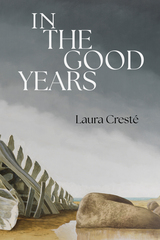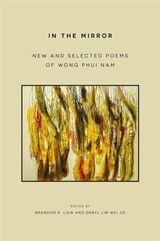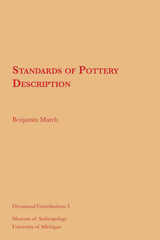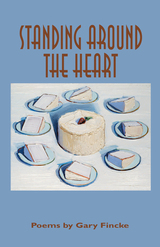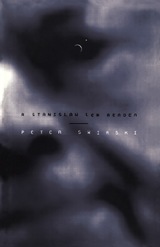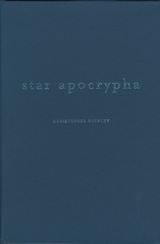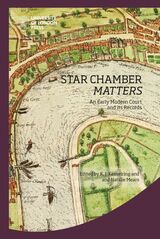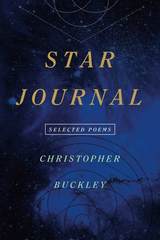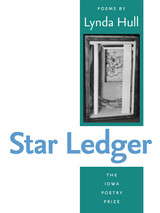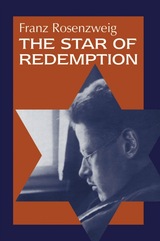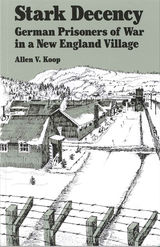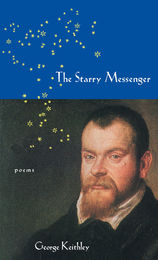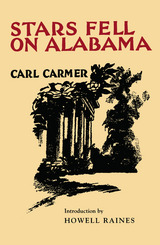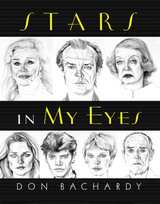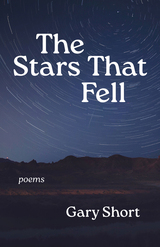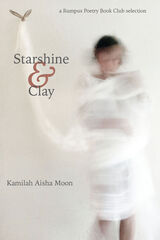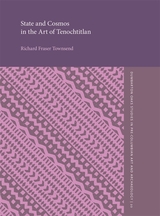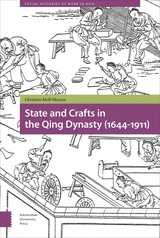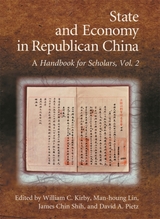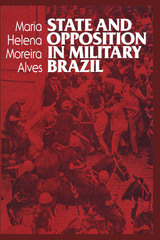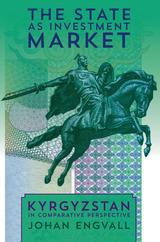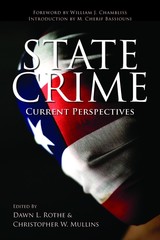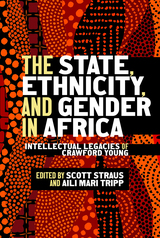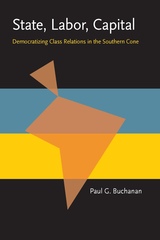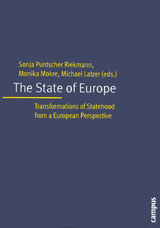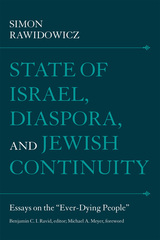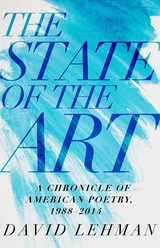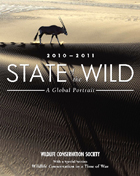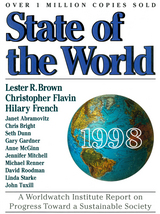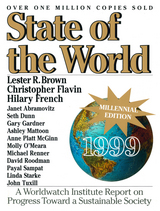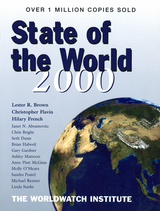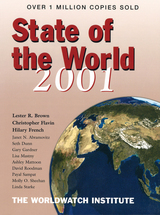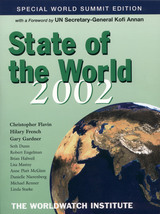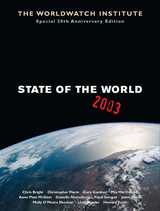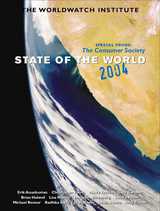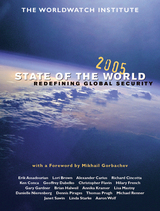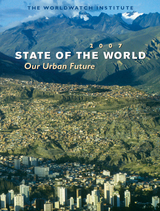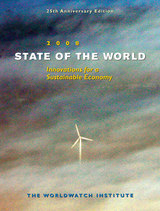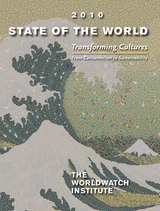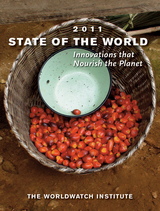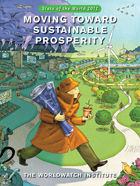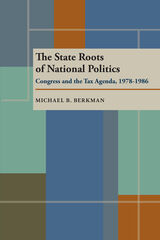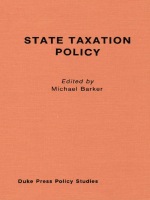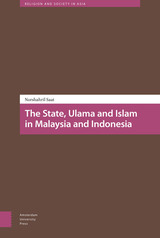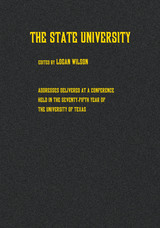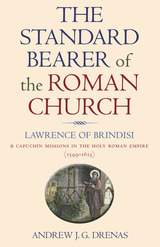 The Standard Bearer of the Roman Church: Lawrence of Brindisi and Capuchin Missions in the Holy Roman Empire (1599-1613)
Andrew J.G. Drenas
Catholic University of America Press, 2018 The Standard Bearer of the Roman Church examines the missionary work of the early modern Capuchin friar, and doctor of the Church, Lawrence of Brindisi. Renowned in his own day as a preacher, Bible scholar, missionary, chaplain, and diplomat, as well as vicar general of his order, Lawrence led the first organized, papally-commissioned Capuchin mission among the non-Catholics of Bohemia in the Holy Roman Empire from 1599 to 1602. He returned again under papal mandate, from 1606 to 1613. Andrew Drenas analyzes Lawrence’s evangelistic and polemical strategies in central Europe in order to shed light on some of the ways the Capuchins labored in religiously divided territories to confirm Catholics in their faith and to win over heretics. The introduction explains, principally, the book’s purpose and the historiographical background. After providing a brief biographical sketch of Lawrence’s life followed by details of his afterlife, Drenas examines Lawrence’s leading role in establishing the Capuchins’ new Commissariate of Bohemia-Austria-Styria in 1600, and specifically its first three friaries in Prague, Vienna, and Graz. From there the volume moves on to treat his preaching against heresy, followed by a focus on how Lawrence, while in Prague, involved himself directly in theological disputations with two different Lutheran preachers. The first dispute, with Polycarp Leyser, took place in July 1607, and dealt with good works and justification. The second, with a Lutheran whose identity remains unknown, and which occurred in August 1610, concerned Catholic veneration of the Virgin Mary. This is followed by an analysis of the Lutheranismi hypotyposis, or The Express Image of Lutheranism, Lawrence’s literary refutation of Lutheranism following additional contact with Polycarp Leyser in 1607. Finally, Drenas considers briefly the effectiveness of Lawrence’s apostolate and closes with a review of the book as a whole.
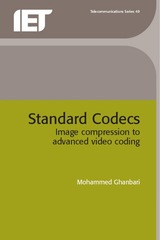 Standard Codecs: Image compression to advanced video coding
Mohammed Ghanbari
The Institution of Engineering and Technology, 2003 A substantially updated edition of Video Coding: An Introduction to Standard Codecs (IEE, 1999, winner of IEE Rayleigh Award), this book discusses the growth of digital television technology and the revolution in image and video compression (such as JPEG2000, broadcast TV, video phone). It highlights the need for standardisation in processing static and moving images and their exchange between computer systems. ITU and ISO/IEC standards are now widely accepted in the picture/video coding field. The book gives an authoritative explanation of picture and video coding algorithms, working from basic principles through to the advanced video compression systems now being developed. It discusses the reasons behind the introduction of a standard codec for a specific application and its chosen parameter. This book will enable readers to appreciate the fundamentals needed to design a video codec for any given application and should prove to be a valuable resource for engineers working in this field.
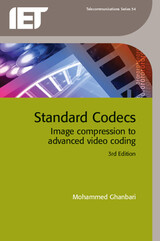 Standard Codecs: Image compression to advanced video coding
Mohammed Ghanbari
The Institution of Engineering and Technology, 2011 A substantially updated edition of Video Coding: An introduction to standard codecs (IEE 1999, winner of IEE Rayleigh Award as the best book of 2000), this book discusses the growth of digital television technology, from image compression to advanced video coding. This third edition also includes the latest developments on H.264/MPEG-4 video coding and the scalability defined for this codec, which were not available at the time of the previous edition (IEE 2003). The book highlights the need for standardisation in processing static and moving images and extensively exploits the ITU and ISO/IEC standards defined in this field. The book gives an authoritative explanation of pictures and video coding algorithms, working from basic principles through to the advanced video compression systems now being developed. It discusses the reasons behind the introduction of a standard codec for a specific application and its chosen parameters. Each chapter is devoted to a standard video codec, and chapters are introduced in an evolutionary manner complementing the earlier chapters. This book will enable readers to appreciate the fundamentals needed to design a video codec for any given application and should prove a valuable resource for managers, engineers and researchers working in this field.
 Standardizing Sex: A History of Trans Medicine
Ketil Slagstad
University of Chicago Press, 2025 A history of trans medicine that uses Scandinavian sources to tell a global story.
Standardizing Sex traces the emergence of trans medicine in Scandinavia in the twentieth century, exploring the construction and negotiation of medical expertise among medical professionals, patients, and activists in the media and government bureaucracy. The book combines the author’s analysis of medical records and other archival sources with oral history interviews with former patients, activists, doctors, psychologists, and civil servants. Physician-historian Ketil Slagstad uses the Scandinavian story of sex reassignment to anchor not only the role of the state but also bureaucracy and social rights. Scandinavian countries, he shows, played a foundational role in the emergence of trans medicine internationally. As a result, Standardizing Sex tells a transnational history of medicine that sheds light on a set of relations and problems that continue to impact discussions of trans medicine and trans rights around the world.
Slagstad’s sources offer a rare opportunity to explore the emergence of trans medicine in action in the clinic, laboratory, waiting room, and operating room, as well as in the bureaucrat’s office, on the psychologist’s couch, and in the publications and meetings of activist groups. Together, these sources allow for the analysis of the increasingly complex negotiations of nosological criteria, medical knowledge, and medical practices in a formative period for transgender medicine. More generally, the book offers a story about the reshaping of the normal and the pathological in modern societies.
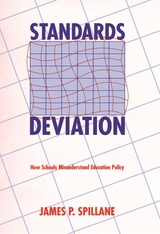 Standards Deviation: How Schools Misunderstand Education Policy
James P. Spillane
Harvard University Press, 2004 What happens to federal and state policies as they move from legislative chambers to individual districts, schools, and, ultimately, classrooms? Although policy implementation is generally seen as an administrative problem, James Spillane reminds us that it is also a psychological problem.
After intensively studying several school districts' responses to new statewide science and math teaching policies in the early 1990s, Spillane argues that administrators and teachers are inclined to assimilate new policies into current practices. As new programs are communicated through administrative levels, the understanding of them becomes increasingly distorted, no matter how sincerely the new ideas are endorsed. Such patterns of well-intentioned misunderstanding highlight the need for systematic training and continuing support for the local administrators and teachers who are entrusted with carrying out large-scale educational change, classroom by classroom.
Standards of Pottery Description
Benjamin March
University of Michigan Press, 1934 The third book in the Museum’s Occasional Contributions series is Benjamin March’s effort to standardize descriptions of pottery. Standards were needed so that pottery collections at various museums or institutions could be compared. With an introduction by Carl E. Guthe.
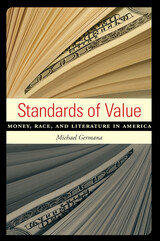 Standards of Value: Money, Race, and Literature in America
Germana, Michael
University of Iowa Press, 2010 In Standards of Value, Michael Germana reveals how tectonic shifts in U.S. monetary policy—from the Coinage Act of 1834 to the abolition of the domestic gold standard in 1933–34—correspond to strategic changes by American writers who renegotiated the value of racial difference. Populating the pages of this bold and innovative study are authors as varied as Harriet Beecher Stowe, George Washington Cable, Charles Chesnutt, James Weldon Johnson, Nella Larsen, Jessie Redmon Fauset, and Ralph Ellison—all of whom drew analogies between the form Americans thought the nation's money should take and the form they thought race relations and the nation should take. A cultural history of race organized around and enmeshed within the theories of literary and monetary value, Standards of Value also recovers a rhetorical tradition in American culture whose echoes can be found in the visual and lyrical grammars of hip hop, the paintings of John W. Jones and Michael Ray Charles, the cinematography of Spike Lee, and many other contemporary forms and texts. This reconsideration of American literature and cultural history has implications for how we value literary texts and how we read shifting standards of value. In vivid prose, Germana explains why dollars and cents appear where black and white bodies meet in American novels, how U.S. monetary policy gave these symbols their cultural currency, and why it matters for scholars of literary and cultural studies.
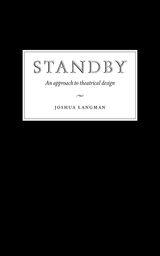 Standby: An Approach to Theatrical Design
Joshua Langman
Southern Illinois University Press, 2022 Named an Outstanding Academic Title: Theater and Dance, 2023 Choice Reviews
A groundbreaking philosophy of design for the stage
Standby proposes a practical philosophy of contemporary theatrical design that addresses all design disciplines, all theatrical collaborators, and all forms of theatre, from the traditional to the avant-garde. In a field that is too often dismissed as purely technical, Joshua Langman celebrates design as a transformative force with the power to elevate a performance and enable it to resonate beyond the bounds of its physical production. Beginning with the proposition that design contributes essential layers of meaning to an experience, Standby argues for a unique approach centered on the creation of revelatory theatrical moments.
In a mission to illuminate the soul of the craft, Langman investigates the purposes of design, details the elements of a production concept, uncovers the mechanics of creating meaning, explores the relationship of theatrical design to fine art and art history, and offers practical guidance on designing productions. He also considers what has changed as designers have embraced digital technology and suggests fifteen concrete methods for preserving the magic of live theatre in a digital age. Blending scholarship and storytelling, personal experience and contrarian wisdom, Standby challenges theatre-makers to harness the rich dramatic potential of theatrical design.
For additional information and supplemental materials, please visit www.standbybook.com.
Standing around the Heart: Poems
Gary Fincke
University of Arkansas Press, 2005 Gary Fincke’s new collection is a poetry grounded in memorable places and characters. He wants readers to remember the voices they hear in the poems, the work the characters do, the families they have, the things they believe in and strive to live up to. There is also a sense of the larger world layered into nearly every poem—history, politics, science, culture. Here too are poems about the mysteries of adolescence, capturing moments of youthful dreaming and wishing. Told in a confiding tone, these are very accessible and inviting poems about the way we redeem ourselves daily, a poetry that, as distinguished poet and critic Edward Hirsch put it, “memorializes the past and honors the life lived.”
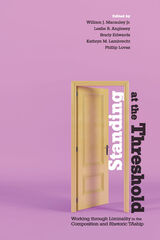 Standing at the Threshold: Working through Liminality in the Composition and Rhetoric TAship
William J. Macauley
Utah State University Press, 2021 Standing at the Threshold articulates identity and role dissonances experienced by composition and rhetoric teaching assistants and reimagines the TAship within a larger professional development process. Current researchers and scholars have not fully explored the liminality of the profession’s traditional path to credentialing. This collection reconsiders these positions and their contributions to academic careers.
These authors enrich the TA experience by supporting agency and self-efficacy, encouraging TAs to take active roles in understanding their positions and making the most of that experience. Many chapters are written by current or former TAs who are writing as a means of preparing, informing, and guiding new rhet/comp TAs, encouraging them to make choices about how they want to think through and participate in their teaching work.
The first work on the market to delve deeply into the TAship itself and what it means for the larger discipline, Standing at the Threshold provides a rich new theorizing based in the real experiences and liminalities of teaching assistants in composition and rhetoric, approached from a productive array of perspectives.
Contributors: Lew Caccia, Lillian Campbell, Rachel Donegan, Jaclyn Fiscus-Cannady, Jennifer K. Johnson, Ronda Leathers Dively, Faith Matzker, Jessica Restaino, Elizabeth Saur, Megan Schoettler, Kylee Thacker Maurer
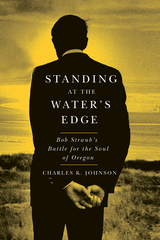 Standing at the Water's Edge: Bob Straub's Battle for the Soul of Oregon
Charles K. Johnson
Oregon State University Press, 2012 Standing at the Water’s Edge chronicles the life of a unique, and perhaps unlikely, political figure in Oregon’s history: former Governor Robert W. Straub.
A man of intelligence, drive, creativity, and fascinating contradictions, Straub overcame personal challenges and inevitable comparisons to his charismatic predecessor and friendly Republican rival, Tom McCall, to have a lasting impact on Oregon and the nation. Charles Johnson shares insights into Straub’s significant legacy, focusing on his leading role in the state’s financial and environmental issues and his influence on McCall. Johnson also reveals much of Straub’s warm personal story, along with his secret struggles, including his battle with depression while Governor.
Standing at the Water’s Edge offers rich descriptions of other intriguing political figures of the time as well, capturing the flavor of what has been called Oregon’s political “golden age” of the sixties and seventies—created in part by the symbiotic relationship between Straub and McCall—and describing how and why it ended.
Standing at the Water’s Edge is an essential addition to the literature about Oregon’s political leaders for historians, political scientists, and general readers interested in Oregon history.
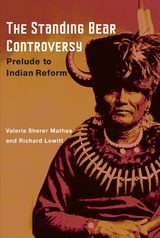 The Standing Bear Controversy: PRELUDE TO INDIAN REFORM
Valerie Sherer Mathes and Richard Lowitt
University of Illinois Press, 2003 In the spring of 1877 government officials forcibly removed members of the Ponca tribe from their homelands in the southeastern corner of Dakota territory, relocating them in the Indian Territory in Oklahoma. When Ponca Chief Standing Bear attempted to lead a group of his people home he was arrested, detained, and put on trial.
In this book Valerie Sherer Mathes and Richard Lowitt examine how the national publicity surrounding the trial of Chief Standing Bear, as well as a speaking tour by the chief and others, brought the plight of his tribe, and of tribespeople across America, to the attention of the general public, serving as a catalyst for the nineteenth-century Indian reform movement.
As the authors show, the eventual ramifications of the removal, flight, and trial of Standing Bear were extensive, and included the rise of an organized humanitarian reform movement, significant changes in the administration of Indian affairs, and the passage of the General Allotment Act in 1887.
This is the first full-length study of the Standing Bear trial and its consequences, and Mathes and Lowitt draw on a vast array of manuscript, diary, and journalistic sources in order to chronicle the events of 1877, as well as the effect the trial had on broader American popular opinion, on the federal government, and finally on the Native American population as a whole.
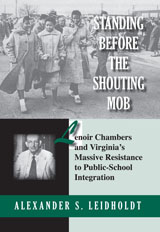 Standing Before the Shouting Mob: Lenoir Chambers and Virginia's Massive Resistance to Public School Integration
Alex Leidholdt
University of Alabama Press, 2007 A southern journalist campaigns for racial understanding during the
struggle over school desegregation in Virginia. In 1958 the nation's attention was focused on Norfolk,
Virginia, where nearly ten thousand students were locked out of their schools.
Rather than comply with the desegregation mandate of Brown v. Board
of Education, Governor J. Lindsay Almond, supported by the powerful
political machine of Senator Harry F. Byrd, Sr., had closed Norfolk's white
secondary schools. Massive resistance to integration transformed Norfolk
into a civil rights arena. Although the process by which Norfolk's schools
were integrated was far from orderly, the transition was characterized
by debate, political maneuvering, and judicial action--not violence. Lenoir
Chambers, editor of the Norfolk Virginian-Pilot, conducted a five-year
editorial campaign supporting the peaceful implementation of the Court's
order. The Pilot was Virginia's only white newspaper to take this
position. Chambers was later awarded a Pulitzer Prize for his editorials. Utilizing a wide range of primary and secondary sources,
Standing before the Shouting Mob examines Chambers's campaign, explores
the influences that shaped his racial views, and places him within the
context of southern journalism. The book also provides a detailed analysis
of Virginia's massive resistance and Norfolk's school closing.
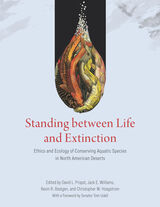 Standing between Life and Extinction: Ethics and Ecology of Conserving Aquatic Species in North American Deserts
Edited by David L. Propst, Jack E. Williams, Kevin R. Bestgen, and Christopher W. Hoagstrom
University of Chicago Press, 2020 North American deserts—lands of little water—have long been home to a surprising diversity of aquatic life, from fish to insects and mollusks. With European settlement, however, water extraction, resource exploitation, and invasive species set many of these native aquatic species on downward spirals. In this book, conservationists dedicated to these creatures document the history of their work, the techniques and philosophies that inform it, and the challenges and opportunities of the future.
A precursor to this book, Battle Against Extinction, laid out the scope of the problem and related conservation activities through the late 1980s. Since then, many nascent conservation programs have matured, and researchers have developed new technologies, improved and refined methods, and greatly expanded our knowledge of the myriad influences on the ecology and dynamics of these species. Standing between Life and Extinction brings the story up to date. While the future for some species is more secure than thirty years ago, others are less fortunate. Calling attention not only to iconic species like the razorback sucker, Gila trout, and Devils Hole pupfish, but also to other fishes and obscure and fascinating invertebrates inhabiting intermittent aquatic habitats, this book explores the scientific, social, and political challenges of preserving these aquatic species and their habitats amid an increasingly charged political discourse and in desert regions characterized by a growing human population and rapidly changing climate.
 Standing for Nature: Legal Strategies for Environmental Justice
Dana Zartner, Fabian Cardenas, Mohammad Golam Sarwar
Island Press, 2024 Rights of Nature laws are becoming a vital tool for addressing environmental injustice. From New Zealand and India to Ecuador and Bolivia, advocates have successfully secured legal rights for rivers, forests, and mountains. Granting rights to nature has the potential to expand environmental protections, strengthen indigenous rights, promote sustainable development, and alter how humans relate to nature. Despite these promises, rights of Nature laws have met with greater resistance in some countries than in others. Standing for Nature offers advocates a blueprint for creating, implementing, and safeguarding rights of Nature laws. This book looks closely at four examples—New Zealand, Colombia, Bangladesh, and the United States—to explain why these laws have been successful in some places but not others. Through this comparative exploration, the authors highlight key strategies for advancing rights of Nature laws in the United States and around the world. These lessons include an examination of different legal traditions to better understand which is the best form of law—judicial, legislative, or regulatory—for advocates to target; how to ensure effective implementation once a law is passed; and how to shift communal perspectives on the human-Nature relationship for better implementation and enforcement. This book is essential for environmental lawyers, policy makers, and advocates interested in gaining new knowledge and tools for championing rights of Nature laws in their own communities.
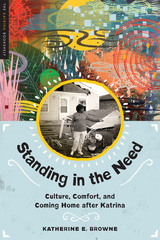 Standing in the Need: Culture, Comfort, and Coming Home After Katrina
By Katherine E. Browne
University of Texas Press, 2015 Standing in the Need presents an intimate account of an African American family’s ordeal after Hurricane Katrina. Before the storm struck, this family of one hundred fifty members lived in the bayou communities of St. Bernard Parish just outside New Orleans. Rooted there like the wild red iris of the coastal wetlands, the family had gathered for generations to cook and share homemade seafood meals, savor conversation, and refresh their interconnected lives. In this lively narrative, Katherine Browne weaves together voices and experiences from eight years of post-Katrina research. Her story documents the heartbreaking struggles to remake life after everyone in the family faced ruin. Cast against a recovery landscape managed by outsiders, the efforts of family members to help themselves could get no traction; outsiders undermined any sense of their control over the process. In the end, the insights of the story offer hope. Written for a broad audience and supported by an array of photographs and graphics, Standing in the Need offers readers an inside view of life at its most vulnerable.
 Standing on Common Ground: The Making of a Sunbelt Borderland
Geraldo L. Cadava
Harvard University Press, 2013 Under constant surveillance and policed by increasingly militarized means, Arizona's border is portrayed in the media as a site of sharp political and ethnic divisions. But this view obscures the region's deeper history. Bringing to light the shared cultural and commercial ties through which businessmen and politicians forged a transnational Sunbelt, Standing on Common Ground recovers the vibrant connections between Tucson, Arizona, and the neighboring Mexican state of Sonora. Geraldo L. Cadava corrects misunderstandings of the borderland's past and calls attention to the many types of exchange, beyond labor migrations, that demonstrate how the United States and Mexico continue to shape one another.
In the 1940s, a flourishing cross-border traffic developed in the Arizona-Sonora Sunbelt, as the migrations of entrepreneurs, tourists, shoppers, and students maintained a densely connected transnational corridor. Politicians on both sides worked to cultivate a common ground of free enterprise, spurring the growth of manufacturing, ranching, and agriculture. However, as Cadava illustrates, these modernizing forces created conditions that marginalized the very workers who propped up the regional economy, and would eventually lead to the social and economic instability that has troubled the Arizona-Sonora borderland in recent times.
Grounded in rich archival materials and oral histories, Standing on Common Ground clarifies why we cannot understand today's fierce debates over illegal immigration and border enforcement without identifying the roots of these problems in the Sunbelt's complex pan-ethnic and transnational history.
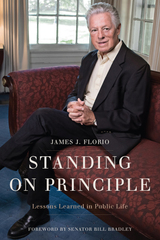 Standing on Principle: Lessons Learned in Public Life
Florio, James J
Rutgers University Press, 2018 James J. Florio is best known as governor of New Jersey from 1990 to 1994. But his career in local, state, and national government is far more varied, and his achievements as a progressive reformer are more substantial than most realize.
This political memoir tells the remarkable story of how Florio, a high school dropout who left to join the Navy as a teenager, went on to become an attorney, a state assemblyman, a congressman, and a governor. A passionate defender of the environment, Florio played a crucial role in the enactment of 1980s-era Superfund laws, which helped to clean up toxic waste sites in New Jersey and around the country. As governor, he fought for the groundbreaking Clean Water Enforcement Act. But his reforms quite literally came at a cost, as he raised New Jersey sales taxes and income taxes to balance the state budget. Florio reflects upon the challenges of meeting the state’s budgetary needs while keeping his tax-averse constituents happy.
Standing on Principle reveals a politician who has never been afraid to take a progressive stand—including a firm stance against semiautomatic weapons that led gun lobbyists to bankroll his opponent. His story is sure to inspire readers from New Jersey and across the nation.
Published in cooperation with the Center on the American Governor, Eagleton Institute of Politics, Rutgers University
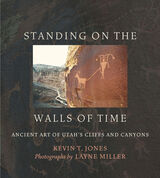 Standing on the Walls of Time: Ancient Art of Utah's Cliffs and Canyons
Kevin T. Jones and Layne Miller
University of Utah Press, 2019 In western culture, rock art has traditionally been viewed as “primitive” and properly belonging in the purview of anthropologists rather than art scholars and critics. This volume, featuring previously unpublished photographs of Utah’s magnificent rock art by long-time rock art researcher Layne Miller and essays by former Utah state archaeologist Kevin Jones, views rock art through a different lens.
Miller’s photographs include many rare and relatively unknown panels and represent a lifetime of work by someone intimately familiar with the Colorado Plateau. The photos highlight the astonishing variety of rock art as well as the variability within traditions and time periods. Jones’s essays furnish general information about previous Colorado Plateau cultures and shine a light on rock art as art. The book emphasizes the exquisite artistry of these ancient works and their capacity to reach through the ages to envelop and inspire viewers.
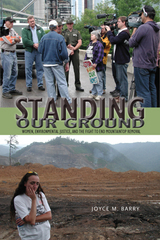 Standing Our Ground: Women, Environmental Justice, and the Fight to End Mountaintop Removal
Joyce M. Barry
Ohio University Press, 2012 Standing Our Ground: Women, Environmental Justice, and the Fight to End Mountaintop Removal examines women’s efforts to end mountaintop removal coal mining in West Virginia. Mountaintop removal coal mining, which involves demolishing the tops of hills and mountains to provide access to coal seams, is one of the most significant environmental threats in Appalachia, where it is most commonly practiced. The Appalachian women featured in Barry’s book have firsthand experience with the negative impacts of Big Coal in West Virginia. Through their work in organizations such as the Coal River Mountain Watch and the Ohio Valley Environmental Coalition, they fight to save their mountain communities by promoting the development of alternative energy resources. Barry’s engaging and original work reveals how women’s tireless organizing efforts have made mountaintop removal a global political and environmental issue and laid the groundwork for a robust environmental justice movement in central Appalachia.
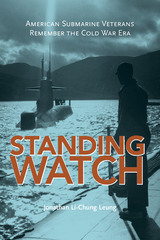 Standing Watch: American Submarine Veterans Remember the Cold War Era
Jonathan Li-Chung Leung
University of Alabama Press, 2019 The first book to capture and preserve the inside story of the exclusive brotherhood that manned the front lines of the Cold War
Featuring interviews from seventeen veteran submariners, Standing Watch: American Submarine Veterans Remember the Cold War Era offers the perspective of the submariners themselves—lending them a voice and paying homage to their service. Jonathan Li-Chung Leung provides an original glimpse into a world of unique challenges and characters, a life isolated and submerged, and a duty defined by the juxtaposition of monotonous routine and unparalleled excitement.
These personal accounts of life below the surface offer readers a front-row seat to close encounters with Soviet submarines and the naval blockade during the Cuban Missile Crisis, as well as an intimate understanding of daily life onboard the vessels, the culture of military discipline, and the religious-like fervor exercised in honoring traditions big and small. By applying first-hand perspectives to a larger thematic overview, this book uses authentic narratives to deliver a lively and colorful picture of the Silent Service.
Set against the backdrop of sobering geo-political disputes and their own role as the nation’s defenders against a seemingly ambiguous super-enemy, these veterans focus on their responsibilities and reflect on careers built on the simple axioms of pride and service. This invigorating and unalloyed account is an unprecedented addition to the existing literature on naval and military history.
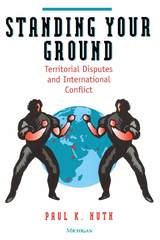 Standing Your Ground: Territorial Disputes and International Conflict
Paul K. Huth
University of Michigan Press, 1998 Through an examination of 129 territorial disputes between 1950 and 1990, Paul Huth presents a new theoretical approach for analyzing the foreign policy behavior of states, one that integrates insights from traditional realist as well as domestic political approaches to the study of foreign policy. Huth's approach is premised on the belief that powerful explanations of security policy must be built on the recognition that foreign policy leaders are domestic politicians who are very attentive to the domestic implications of foreign policy actions. Hypotheses derived from this new modified realist mode are then empirically tested by a combination of statistical and case study analysis.
". . . a welcome contribution to our understanding of how and why some territorial disputes escalate to war."--American Political Science Review
Paul Huth is Associate Professor of Political Science and Associate Research Scientist, Center for Political Studies, Institute for Social Research, University of Michigan.
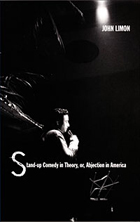 Stand-up Comedy in Theory, or, Abjection in America
John Limon
Duke University Press, 2000 Stand-Up Comedy in Theory, or, Abjection in America is the first study of stand-up comedy as a form of art. John Limon appreciates and analyzes the specific practice of stand-up itself, moving beyond theories of the joke, of the comic, and of comedy in general to read stand-up through the lens of literary and cultural theory. Limon argues that stand-up is an artform best defined by its fascination with the abject, Julia Kristeva’s term for those aspects of oneself that are obnoxious to one’s sense of identity but that are nevertheless—like blood, feces, or urine—impossible to jettison once and for all. All of a comedian’s life, Limon asserts, is abject in this sense.
Limon begins with stand-up comics in the 1950s and 1960s—Lenny Bruce, Carl Reiner, Mel Brooks, Mike Nichols, Elaine May—when the norm of the profession was the Jewish, male, heterosexual comedian. He then moves toward the present with analyses of David Letterman, Richard Pryor, Ellen DeGeneres, and Paula Poundstone. Limon incorporates feminist, race, and queer theories to argue that the “comedification” of America—stand-up comedy’s escape from its narrow origins—involves the repossession by black, female, queer, and Protestant comedians of what was black, female, queer, yet suburbanizing in Jewish, male, heterosexual comedy. Limon’s formal definition of stand-up as abject art thus hinges on his claim that the great American comedians of the 1950s and 1960s located their comedy at the place (which would have been conceived in 1960 as a location between New York City or Chicago and their suburbs) where body is thrown off for the mind and materiality is thrown off for abstraction—at the place, that is, where American abjection has always found its home.
A Stanislaw Lem Reader
Peter Swirski
Northwestern University Press, 1997 Polish-born Lem is one of the best-selling unknown writers of science fiction in the US. This collection assembles in-depth and insightful writings by and about, as well as interviews with, Lem. Two interviews are separated by Lem's own 1991 essay in which he surveys in detail 30 years of his earlier work, much of which has never been translated into English. Readers interested in Lem's provocative and uncompromising view of literature's role in the contemporary cultural environment, and in Lem's opinions about his own fiction, about the relation of literature to science and technology, and the dead ends of contemporary culture, will be fascinated by this eclectic collection.
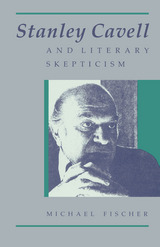 Stanley Cavell and Literary Skepticism
Michael Fischer
University of Chicago Press, 1989 Stanley Cavell's work is distinctive not only in its importance to philosophy but also for its remarkable interdisciplinary range. Cavell is read avidly by students of film, photography, painting, and music, but especially by students of literature, for whom Cavell offers major readings of Thoreau, Emerson, Shakespeare, and others. In this first book-length study of Cavell's writings, Michael Fischer examines Cavell's relevance to the controversies surrounding poststructuralist literary theory, particularly works by Jacques Derrida, J. Hillis Miller, Paul de Man, and Stanley Fish.
Throughout his study, Fischer focuses on skepticism, a central concern of Cavell's multifaceted work. Cavell, following J. L. Austin and Wittgenstein, does not refute the radical epistemological questioning of Descartes, Hume, and others, but rather characterizes skepticism as a significant human possibility or temptation. As presented by Fischer, Cavell's accounts of both external-world and other-minds skepticism share significant affinities with deconstruction, a connection overlooked by contemporary literary theorists.
Fischer follows Cavell's lead in examining how different genres address the problems raised by skepticism and goes on to show how Cavell draws on American and English romanticism in fashioning a response to it. He concludes by analyzing Cavell's remarks about current critical theory, focusing on Cavell's uneasiness with some of the conclusions reached by its practitioners. Fischer shows that Cavell's insights, grounded in powerful analyses of Descartes, Hume, and Wittgenstein, permit a fresh view of Derrida, Miller, de Man, and Fish. The result is not only a revealing characterization of deconstruction but a much-needed and insightful introduction to Cavell's rich but difficult oeuvre.
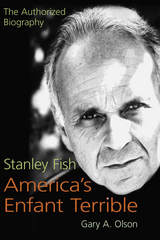 Stanley Fish, America's Enfant Terrible: The Authorized Biography
Gary A. Olson
Southern Illinois University Press, 2016 One of the twentieth century’s most original and influential literary theorists, Stanley Fish is also known as a fascinatingly atypical, polarizing public intellectual; a loud, cigar-smoking contrarian; and a lightning rod for both the political right and left. The truth and the limitations of this reputation are explored in Stanley Fish, America’s Enfant Terrible by Gary A. Olson. At once a literary biography and a traditional life story, this engrossing volume details Fish’s vibrant personal life and his remarkably versatile career.
Born into a tumultuous family, Fish survived life with an emotionally absent father and a headstrong mother through street sports and troublemaking as much as through his success at a rigorous prep school. As Olson shows, Fish’s escape from the working-class neighborhoods of 1940s and 1950s Providence, Rhode Island, came with his departure for the university life at the University of Pennsylvania and then Yale. His meteoric rise through the academic ranks at a troubled Vietnam-era UC-Berkeley was complemented by a 1966 romp through Europe that included drag racing through the streets of Seville in his Alfa Romeo. He went on to become an internationally prominent scholar at Johns Hopkins before moving to Duke, where he built a star-studded academic department that became a key site in the culture and theory wars of the 1980s and 1990s. Olson discusses Fish’s tenure as a highly visible dean at the University of Illinois at Chicago who clashed publicly with the state legislature. He also covers Fish’s most remarkable and controversial books, including Fish’s masterpiece, Surprised by Sin: The Reader in "Paradise Lost," which was a critical sensation and forever changed the craft of literary criticism, as well as Professional Correctness and Save the World on Your Own Time, two books that alienated Fish from most liberal-minded professors in English studies.
Olson concludes his biography of Fish with an in-depth analysis of the contradictions between Fish’s public persona and his private personality, examining how impulses and events from Fish’s childhood shaped his lifelong practices and personality traits. Also included are a chronology of the major events of Fish’s life and never-before-published photos.
Based on hundreds of hours of recorded interviews with friends, enemies, colleagues, former students, family members, and Fish himself, along with material from the Stanley Fish archive, Stanley Fish, America’s Enfant Terrible is a clearly written narrative of the life of an important and controversial scholar.
 Stanley Kubrick at Look Magazine: Authorship and Genre in Photojournalism and Film
Philippe D. Mather
Intellect Books, 2013 From 1945 to 1950, during the formative years of his career, Stanley Kubrick worked as a photojournalist for Look magazine. Offering a comprehensive examination of the work he produced during this period—before going on to become one of America’s most celebrated filmmakers—Stanley Kubrick at "Look" Magazine sheds new light on the aesthetic and ideological factors that shaped his artistic voice. Tracing the links between his photojournalism and films, Philippe Mather shows how working at Look fostered Kubrick’s emerging genius for combining images and words to tell a story. Mather then demonstrates how exploring these links enhances our understanding of Kubrick’s approach to narrative structure—as well as his distinctive combinations of such genres as fiction and documentary, and fantasy and realism. Beautifully written and exhaustively researched, Stanley Kubrick at "Look" Magazine features never-before-published photographs from the Look archives and complete scans of Kubrick’s photo essays from hard-to-obtain back issues of the magazine. It will be an indispensable addition to the libraries of Kubrick scholars and fans.
 Stanley Kubrick: New York Jewish Intellectual
Abrams, Nathan
Rutgers University Press, 2018 Stanley Kubrick is generally acknowledged as one of the world’s great directors. Yet few critics or scholars have considered how he emerged from a unique and vibrant cultural milieu: the New York Jewish intelligentsia.
Stanley Kubrick reexamines the director’s work in context of his ethnic and cultural origins. Focusing on several of Kubrick’s key themes—including masculinity, ethical responsibility, and the nature of evil—it demonstrates how his films were in conversation with contemporary New York Jewish intellectuals who grappled with the same concerns. At the same time, it explores Kubrick’s fraught relationship with his Jewish identity and his reluctance to be pegged as an ethnic director, manifest in his removal of Jewish references and characters from stories he adapted.
As he digs deep into rare Kubrick archives to reveal insights about the director’s life and times, film scholar Nathan Abrams also provides a nuanced account of Kubrick’s cinematic artistry. Each chapter offers a detailed analysis of one of Kubrick’s major films, including Lolita, Dr. Strangelove, 2001, A Clockwork Orange, Barry Lyndon, The Shining, Full Metal Jacket, and Eyes Wide Shut. Stanley Kubrick thus presents an illuminating look at one of the twentieth century’s most renowned and yet misunderstood directors.
 Stanley Kubrick Produces
James Fenwick
Rutgers University Press, 2021 Stanley Kubrick Produces provides the first comprehensive account of Stanley Kubrick’s role as a producer, and of the role of the producers he worked with throughout his career. It considers how he first emerged as a producer, how he developed the role, and how he ultimately used it to fashion himself a powerbase by the 1970s. It goes on to consider how Kubrick’s centralizing of power became a self-defeating strategy by the 1980s and 1990s, one that led him to struggle to move projects out of development and into active production.
Making use of overlooked archival sources and uncovering newly discovered ‘lost’ Kubrick projects (The Cop Killer, Shark Safari, and The Perfect Marriage among them), as well as providing the first detailed overview of the World Assembly of Youth film, James Fenwick provides a comprehensive account of Kubrick’s life and career and of how he managed to obtain the level of control that he possessed by the 1970s. Along the way, the book traces the rapid changes taking place in the American film industry in the post-studio era, uncovering new perspectives about the rise of young independent producers, the operations of influential companies such as Seven Arts and United Artists, and the whole field of film marketing.
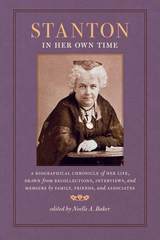 Stanton in Her Own Time: A Biographical Chronicle of Her Life, Drawn from Recollections, Interviews, and Memoirs by Family, Friends, and Associates
Noelle A. Baker
University of Iowa Press, 2016 Among nineteenth-century women’s rights reformers, Elizabeth Cady Stanton (1815–1902) stands out for the maternal and secular advocacy that shaped her activism and public reception. A wife and mother of seven, she was also a prolific writer, transatlantic women’s rights leader, popular lecturer, congressional candidate, canny historian, and freethought champion. Her lifelong interest in women’s sexual and reproductive rights and late efforts to reform institutional religion are as relevant to our time as they were to her own.
Stanton’s professional life lasted a half-century, ranging from antebellum women’s rights organization and oratory, to a post–Civil War career as a lyceum lecturer, to a late-century role as an incisive religious and cultural critic. Acutely aware of the medical, religious, legal, and educational barriers to women’s independence, she advocated for married women’s right to vote, obtain a divorce, gain custody of their children, and own property. As she grew more radical over the years, she also demanded judicial reform, the separation of church and state, free love, progressive coeducational opportunities, and women’s right to limit their fertility.
In this richly contextualized collection of primary sources, Noelle A. Baker brings together accounts of Stanton’s life and ideas from both well-known and recently recovered figures. From the teacher chiding an assertive young woman to erstwhile allies worrying about her growing radicalism, their voices paint a vivid portrait of a woman of vaunting ambition, powerhouse intellect, and her share of human failings.
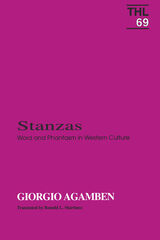 Stanzas: Word and Phantasm in Western Culture
Georgio Agamben
University of Minnesota Press, 1992 Stanzas is a fascinating blend of philology, medieval physics and psychology, the psychoanalysis of toys, and contemporary linguistics and philosophy. In this unique work, Giorgio Agamben attempts to reconfigure the epistemological foundation of Western culture. He rereads Freud and Saussure to discover the impossibility of metalanguage and of synthesis that could be reflected in the transparency of signs. There is no "superior language" that can read the obscure scenes of the unconscious, and the "symbol" is always the return of the repressed in an improper signifier.
This impossibility leads Agamben to the problem of representation. He argues that because language is the locus of the production and storage of phantasms, all real objects are fractured by phantasmic itineraries that in turn divide poetry and philosophy, joy and knowledge.
Giorgio Agamben teaches philosophy at the Collège International de Philosophie in Paris and at the University of Macerata in Italy. He is the author of Language and Death (1991), The Coming Community (1993), and Means without End (2000).
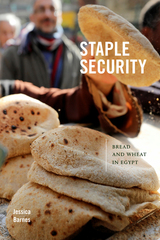 Staple Security: Bread and Wheat in Egypt
Jessica Barnes
Duke University Press, 2022 Egyptians often say that bread is life; most eat this staple multiple times a day, many relying on the cheap bread subsidized by the government. In Staple Security, Jessica Barnes explores the process of sourcing domestic and foreign wheat for the production of bread and its consumption across urban and rural settings. She traces the anxiety that pervades Egyptian society surrounding the possibility that the nation could run out of wheat or that people might not have enough good bread to eat, and the daily efforts to ensure that this does not happen. With rich ethnographic detail, she takes us into the worlds of cultivating wheat, trading grain, and baking, buying, and eating bread. Linking global flows of grain and a national bread subsidy program with everyday household practices, Barnes theorizes the nexus between food and security, drawing attention to staples and the lengths to which people go to secure their consistent availability and quality.
Star Apocrypha
Christopher Buckley
Northwestern University Press, 2001 A brilliant expression of philosophy and feeling, Christopher Buckley's latest poetry collection explores growing up in the America of the fifties and sixties and coming to terms with the aging process. In dazzling language, Star Apocrypha bears the beauty and weight of the big questions. The poet looks to nature--the interior and exterior landscapes--for his answers and with wit and high-pitched intelligence accepts his art and life in the twenty-first century.
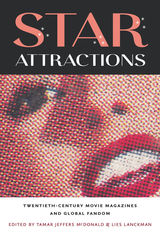 Star Attractions: Twentieth-Century Movie Magazines and Global Fandom
Tamar Jeffers McDonald and Lies Lanckman
University of Iowa Press, 2019 During Hollywood’s “classic era,” from the 1920s to 1950s, roughly twenty major fan magazines were offered each month at American newsstands and abroad. These publications famously fed fan obsessions with celebrities such as Mae West and Elvis Presley. Film studies scholars often regard these magazines with suspicion; perhaps due to their reputation for purveying scandal and gossip, their frequent mingling of gushing tone, and blatant falsehood. Looking at these magazines with fresh regarding eyes and treating them as primary sources, the contributors of this collection provide unique insights into contemporary assumptions about the relationship between fan and star, performer and viewer. In doing so, they reveal the magazines to be a huge and largely untapped resource on a wealth of subjects, including gender roles, appearance and behavior, and national identity. Contributors: Emily Chow-Kambitsch, Alissa Clarke, Jonathan Driskell, Lucy Fischer, Ann-Marie Fleming, Oana-Maria Mazilu, Adrienne L. McLean, Sarah Polley, Geneviève Sellier, Michael Williams
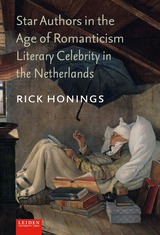 Star Authors in the Age of Romanticism: Literary Celebrity in the Netherlands
Rick Honings
Leiden University Press, 2018 "Although there has always been a fascination for famous people, the invention of modern celebrity culture goes back to the nineteenth century. During Romanticism the position of the author changed, but, with the phenomenon of the fan and associated fandom coming into existence, also that of the public with the phenomenon of the fan and associated fandom coming into existence. In Star Authors in the Age of Romanticism Dutch literary celebrity culture is analysed and embedded in the international discourse on this subject. Internationally, scholarly attention has over the last years been given to literary celebrity. This book supplies the Dutch dynamic to the international prevailing scholarly discourse on the development of literary celebrity by focusing on five famous Dutch authors from the nineteenth century: Willem Bilderdijk, Hendrik Tollens, Nicolaas Beets, François HaverSchmidt (alias Piet Paaltjens) and Eduard Douwes Dekker (better known as Multatuli). "
Star Chamber Matters: The Court and Its Records
Edited by Natalie Mears and Krista Kesselring
University of London Press, 2021 A comprehensive historical study into the birth of the law and legal courts in early modern Britain.
Star Chamber Matters details some of the fascinating, tragic, and startling cases brought before the Star Chamber, an English court that sat at the Royal Palace of Westminster from the late fifteenth century to the mid-seventeenth century. Through close examination of the breadth and depth of cases brought before the court in its day, readers will experience the trials and tribulations of life, love, and death in Tudor Britain. These cases touch on changing gender roles, shifting religious views, and more. Star Chamber Matters witnesses the birth of English common and civil law as we know it today.
Star Charting
Bess Matassa
Duke University Press, 2026 Astrology is the language in which all of existence speaks, says astrologist and tarotist Bess Matassa. In Star Charting, she leads readers on a vivid journey through the twelve signs of the zodiac as a poetic practice and transformative framework for befriending both the familiar and the strange. Matassa blends personal narrative, sensory immersion, inquiry exercises, and communal calls to action to reframe this ancient art as a modern manifesto for healing division by exalting the astounding complexity within this wild world. In contrast to more technical manuals on birth chart interpretation, this is magic-making as an exploratory treasure hunt, forging radical pathways to personal and collective evolution. Twelve modes of bearing witness to life and moving with its currents. Twelve styles of championing creative change. And twelve ways of never, ever losing heart.
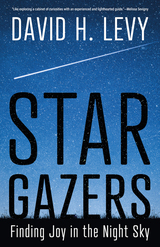 Star Gazers: Finding Joy in the Night Sky
David H. Levy
University of Arizona Press, 2025 A flash, a single streak of light, is what sparked David Levy’s passion for astronomy more than sixty years ago. In this delightful collection of essays, Levy shares not only his love for the sky and stars, but also his love for language and literature. With the voice of a poet and the eye of a skilled, albeit amateur, astronomer, Levy takes us on a glorious adventure as large as the universe.
Bringing together writing from across two decades of stargazing, Levy explores the different aspects of the night sky, from the simple star-studded vault that appears every clear night, to insight into how some amateur astronomers use advanced equipment to image details of the night sky. He writes about the James Webb Space Telescope and the Northern Lights, offering commentary on astronomical events and the profound questions they inspire. While there are books that describe how to observe the sky, this book explains why.
Star Gazers is a celebration of the joy and mystery found in the stars, with the author’s personal experiences serving as a continuous thread throughout. Whether you are a seasoned astronomer or a curious newcomer, Star Gazers will inspire you to look up and embrace the night sky with renewed passion and curiosity.
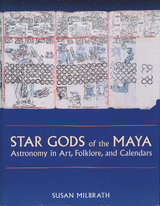 Star Gods of the Maya: Astronomy in Art, Folklore, and Calendars
By Susan Milbrath
University of Texas Press, 2000 Observations of the sun, moon, planets, and stars played a central role in ancient Maya lifeways, as they do today among contemporary Maya who maintain the traditional ways. This pathfinding book reconstructs ancient Maya astronomy and cosmology through the astronomical information encoded in Precolumbian Maya art and confirmed by the current practices of living Maya peoples. Susan Milbrath opens the book with a discussion of modern Maya beliefs about astronomy, along with essential information on naked-eye observation. She devotes subsequent chapters to Precolumbian astronomical imagery, which she traces back through time, starting from the Colonial and Postclassic eras. She delves into many aspects of the Maya astronomical images, including the major astronomical gods and their associated glyphs, astronomical almanacs in the Maya codices [painted books], and changes in the imagery of the heavens over time. This investigation yields new data and a new synthesis of information about the specific astronomical events and cycles recorded in Maya art and architecture. Indeed, it constitutes the first major study of the relationship between art and astronomy in ancient Maya culture.
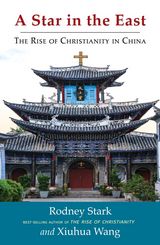 A Star in the East: The Rise of Christianity in China
Rodney Stark
Templeton Press, 2015 What is the state of Christianity in China? Some scholars say that China is invulnerable to religion. In contrast, others say that past efforts of missionaries have failed, writing off those converted as nothing more than “rice Christians” or cynical souls who had frequented the missions for the benefits they provided. Some wonder if the Cultural Revolution extinguished any chances of Christianity in China. Rodney Stark and Xiuhua Wang offer a different perspective, arguing that Christianity is alive, well, and on the rise. Stark approaches the topic from an extensive research background in Christianity and Chinese history, and Wang provides an inside look at Christianity and its place in her home country of China. Both authors cover the history of religion in China, disproving older theories concerning the number of Christians and the kinds of Christians that have emerged in the past 155 years. Stark and Wang claim that when just considering the visible Christians—those not part of underground churches—thousands of Chinese are still converted to Christianity daily, and forty new churches are opening each week. A Star in the East draws on two major national surveys to sketch a close-up of religion in China. A reliable estimate is that by 2007 there were approximately 60 million Christians in China. If the current growth rate were to hold until 2030, there would be more Christians in China—about 295 million—than in any other nation. This trend has significant implications, not just for China but for the greater world order. It is probable that Chinese Christianity will splinter into denominations, likely leading to the same political, social, and economic ramifications seen in the West today. Whether you’re new to studying Christianity in China or whether this has been your area of interest for years, A Star in the East provides a reliable, thought-provoking, and engaging account of the resilience of the Christian faith in China and the implications it has for the future.
Star Journal: Selected Poems
Christopher Buckley
University of Pittsburgh Press, 2016 Star Journal is a selection of poems from Christopher Buckley's twenty previous collections, from 1980-2014.
Past praise from Philip Levine:
“The poems are modest, straight forward, intensely lyrical and totally accessible. . . . This is a humble poetry of great truths and profound emotions that never overstates its concerns for the events both in and above the world. It rewards countless readings and never betrays itself.”
—Ploughshares
 Star Lake Saloon and Housekeeping Cottages: A Novel
Sara Rath
University of Wisconsin Press, 2006 In this first novel from award-winning writer Sara Rath, the forests and lakes of northern Wisconsin pose a daunting threat to outsider Hannah Swann, who is content with her quiet life in Madison, Wisconsin, where she teaches and writes screenplays about obscure nineteenth-century poets. Her relationship with her college-aged daughter is strained yet candid, and a long-standing affair with a married professor has its own peculiar ups and downs.
When Hannah unexpectedly inherits her uncle's rundown resort, she must head to the northwoods to close up and sell the business. But the only interested buyer is Ingold, an international mining company, and Hannah finds herself reluctantly operating the resort while trapped in the midst of a treacherous dispute between Ingold and Uncle Hal's activist friends.
From safeguarding the wilderness to pursuing elusive new love interests, Hannah has plenty to engage her imagination at Star Lake. A new aspect of her personality emerges, one that is surprisingly courageous and compassionate. Throughout this humorous, elegantly plotted adventure with its appealing characters and lyrical depictions of nature, Hannah encounters the inevitability of change—in herself and in the nostalgic landscape of the deep North.
Star Ledger
Lynda Hull
University of Iowa Press, 1991 In this dark but finally redemptive group of poems, the tawdry and the exquisite must coexist: Star Ledger may evoke images of the celestial, but it is also the name of the Newark morning newspaper. Such ironies continually inform Hull’s poetry, which is tough and uncompromising but richly veined with a musicality and a lyrical texture that recall earlier epics of the American city such as The Bridge and Paterson.
 The Star of August
Sonallah Ibrahim
Seagull Books, 2026 A piercing portrait of the Egyptian nation in upheaval in the 1960s—and a powerful critique of progress made at a human cost.
In the summer of 1965, a journalist newly released from prison finds himself stranded at the sprawling site of the Aswan High Dam, the flagship project of Gamal Abdel Nasser’s modern Egypt. Amid oppressive heat, unreliable transport, a mysterious epidemic, and the oppressive gaze of state surveillance, he confronts a dramatic transformation underway: villages erased, communities displaced, and a rich past disappearing beneath the waters of a new lake. As the journalist journeys south along the Nile, his observations illuminate a key moment in Cold War politics and a society wrestling with the promises and perils of progress.
Originally published in Arabic in 1974, Star of August is a masterwork by Sonallah Ibrahim—a writer who lived through these upheavals firsthand—and a timeless exploration of ideology, power, and the price of change.
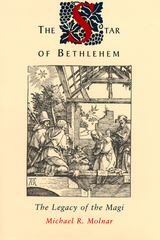 The Star of Bethlehem: The Legacy of the Magi
Molnar, Michael R.
Rutgers University Press, 2013 Could the $50 purchase of an ancient coin by a Rutgers astronomer have unlocked the mystery of the Christmas Star? For years, scientists have looked, with little success, to astronomical records for an explanation of the magical star that guided the Magi to Christ’s manger. Intrigued by the image he found on the latest addition to his coin collection, Michael Molnar thought there might be more to learn by looking, instead, at the teachings of ancient astrologers. Molnar argues in his book that the Star of Bethlehem was not a star at all, but rather a regal portent centering around the planet Jupiter that was eclipsed by the moon. He bases this theory on the actual beliefs of astrologers, such as the Magi, who lived around the time of Christ. Molnar found some intriguing clues to the mystery while researching the meaning of astrological symbols he found an ancient coin, which bore the image of Aries looking back at a star. He found that Aries was a symbol of Judea at the time, and that ancient astrologers believed that a new king would be born when the moon passed in front of Jupiter. Molnar wondered, could the coin have been issued as a response to the Great Messianic Portent, the Star of Bethlehem? To match the story of the appearance of the Christmas star, Molnar also knew the event had to happen when Jupiter was “in the east.” Using these criteria and a computer program, he was able to chart an eclipse of Jupiter in Aries on April 17, 6 B.C., a day when Jupiter was precisely “in the east,” which confirmed his theory. Moreover, he found that a Roman astrologer described the conditions of that day as fitting the birth of a “divine and immortal” person. According to Harvard University Professor Owen Gingerich, “this is the most original and important contribution of the entire 20th century” about the Magi’s star. Using clues from astronomy, astrology, and history, Molnar has created a provocative, fascinating theory on the Christmas Star. He weaves together an intriguing scientific detective story which resolves one of the world’s greatest mysteries: The Star of Bethlehem at the birth of Christ.
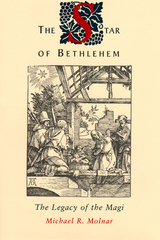 The Star of Bethlehem: The Legacy of the Magi
Molnar, Michael R.
Rutgers University Press, 1999 Could the $50 purchase of an ancient coin by a Rutgers astronomer have unlocked the mystery of the Christmas Star? For years, scientists have looked, with little success, to astronomical records for an explanation of the magical star that guided the Magi to Christ’s manger. Intrigued by the image he found on the latest addition to his coin collection, Michael Molnar thought there might be more to learn by looking, instead, at the teachings of ancient astrologers. Molnar argues in his book that the Star of Bethlehem was not a star at all, but rather a regal portent centering around the planet Jupiter that was eclipsed by the moon. He bases this theory on the actual beliefs of astrologers, such as the Magi, who lived around the time of Christ. Molnar found some intriguing clues to the mystery while researching the meaning of astrological symbols he found an ancient coin, which bore the image of Aries looking back at a star. He found that Aries was a symbol of Judea at the time, and that ancient astrologers believed that a new king would be born when the moon passed in front of Jupiter. Molnar wondered, could the coin have been issued as a response to the Great Messianic Portent, the Star of Bethlehem? To match the story of the appearance of the Christmas star, Molnar also knew the event had to happen when Jupiter was “in the east.” Using these criteria and a computer program, he was able to chart an eclipse of Jupiter in Aries on April 17, 6 B.C., a day when Jupiter was precisely “in the east,” which confirmed his theory. Moreover, he found that a Roman astrologer described the conditions of that day as fitting the birth of a “divine and immortal” person. According to Harvard University Professor Owen Gingerich, “this is the most original and important contribution of the entire 20th century” about the Magi’s star. Using clues from astronomy, astrology, and history, Molnar has created a provocative, fascinating theory on the Christmas Star. He weaves together an intriguing scientific detective story which resolves one of the world’s greatest mysteries: The Star of Bethlehem at the birth of Christ.
The Star of Redemption
Franz Rosenzweig; Translated by Barbara E. Galli; Foreword by Michael Oppenheim, introduction by Elliot R. Wolfson
University of Wisconsin Press, 2005 The Star of Redemption is essential reading for anyone interested in understanding religion and philosophy in the twentieth century. Fusing philosophy and theology, the book assigns both Judaism and Christianity distinct but equally important roles in the spiritual structure of the world. Franz Rosenzweig finds in both biblical religions approaches to a comprehension of reality.
The major themes and motifs of The Star—the birth, life, death, and the immortality of the soul; Eastern philosophies and Jewish mysticism; the relationship between God, world and humanity over time; and revelation as the real biblical miracle of faith and path to redemption—resonate meaningfully.
 The Star of Redemption
Fran Rosenzweig
University of Notre Dame Press, 1985 “Franz Rosenzweig’s The Start of Redemption is one of the few lasting books of our century, a work whose originality transcends the disciplinary limits of philosophy and religion and which must be read by anyone whose concern with the meaning of daily life is urgent and abiding.” —Maurice Natanson, Yale University
The Star of Redemption is widely recognized as a key document of modern existential thought and a significant contribution to Jewish theology in the twentieth century. An affirmation of what Rosenzweig called “the new thinking,” the work ensconces common sense in the place of abstract, conceptual philosophizing and posits the validity of the concrete, individual human being over that of “humanity” in general. Fusing philosophy and theology, it assigns both Judaism and Christianity distinct but equally important roles in the spiritual structure of the world, and finds in both biblical religions approaches toward a comprehension of reality.
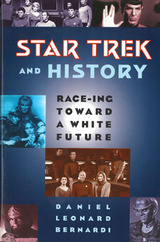 Star Trek and History: Race-ing toward a White Future
Bernardi, Daniel Leonard
Rutgers University Press, 1998 Star Trek is an enduring icon in American popular culture. For many viewers, the science fiction series represents the bold exploration of the unknown and the humanistic respect of the foreign and the alien. In fact, it is Star Trek's vision of a utopian future where humans no longer engage in racism, sexism, capitalism, among other "-isms" that many fans claim is the main reason for their loyalty. But is the visionary Trek future world truly colorblind?
Star Trek and History traces the shifting and reforming meaning of race articulated throughout the Star Trek television series, feature films, and fan community. Daniel Bernardi investigates and politicizes the presentation of race in Star Trek in the original series of the 1960s, the feature films and television spin-offs of the 1980s and 1990s, and the current fan community on the Internet. Through both critical and historical analysis, the book proposes a method of studying the framing of race in popular film and television that integrates sociology, critical theory, and cultural studies.
Bernardi examines the representational and narrative functions of race in Star Trek and explores how the meaning of race in the science fiction series has been facilitated or constrained by creative and network decision-making, by genre, by intertextuality, and by fans. He interprets how the changing social and political movements of the times have influenced the production and meaning of Trek texts and the ways in which the ongoing series negotiated and reflected these turbulent histories. Most significantly, Bernardi tells us why is it important for readers to better understand the articulation of race in this enduring icon of American popular culture.
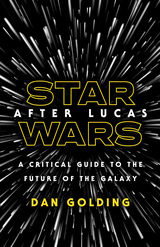 Star Wars after Lucas: A Critical Guide to the Future of the Galaxy
Dan Golding
University of Minnesota Press, 2019 Politics, craft, and cultural nostalgia in the remaking of Star Wars for a new age A long time ago, in a galaxy far, far away—way back in the twenty-first century’s first decade—Star Wars seemed finished. Then in 2012 George Lucas shocked the entertainment world by selling the franchise, along with Lucasfilm, to Disney. This is the story of how, over the next five years, Star Wars went from near-certain extinction to what Wired magazine would call “the forever franchise,” with more films in the works than its first four decades had produced. Focusing on The Force Awakens (2015), Rogue One (2016), The Last Jedi (2017), and the television series Rebels (2014–18), Dan Golding explores the significance of pop culture nostalgia in overcoming the skepticism, if not downright hostility, that greeted the Star Wars relaunch. At the same time he shows how Disney, even as it tapped a backward-looking obsession, was nonetheless creating genuinely new and contemporary entries in the Star Wars universe. A host of cultural factors and forces propelled the Disney-engineered Star Wars renaissance, and all figure in Golding’s deeply informed analysis: from John Williams’s music in The Force Awakens to Peter Cushing’s CGI face in Rogue One, to Carrie Fisher’s passing, to the rapidly changing audience demographic. Star Wars after Lucas delves into the various responses and political uses of the new Star Wars in a wider context, as in reaction videos on YouTube and hate-filled, misogynistic online rants. In its granular textual readings, broad cultural scope, and insights into the complexities of the multimedia galaxy, this book is as entertaining as it is enlightening, an apt reflection of the enduring power of the Star Wars franchise.
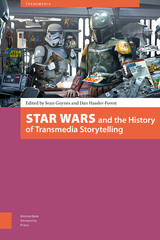 Star Wars and the History of Transmedia Storytelling
Edited by Sean Guynes and Dan Hassler-Forest
Amsterdam University Press, 2017 Star Wars has reached more than three generations of casual and hardcore fans alike, and as a result many of the producers of franchised Star Wars texts (films, television, comics, novels, games, and more) over the past four decades have been fans-turned-creators. Yet despite its dominant cultural and industrial positions, Star Wars has rarely been the topic of sustained critical work. Star Wars and the History of Transmedia Storytelling offers a corrective to this oversight by curating essays from a wide range of interdisciplinary scholars in order to bring Star Wars and its transmedia narratives more fully into the fold of media and cultural studies. The collection places Star Wars at the center of those studies’ projects by examining video games, novels and novelizations, comics, advertising practices, television shows, franchising models, aesthetic and economic decisions, fandom and cultural responses, and other aspects of Star Wars and its world-building in their multiple contexts of production, distribution, and reception. In emphasizing that Star Wars is both a media franchise and a transmedia storyworld, Star Wars and the History of Transmedia Storytelling demonstrates the ways in which transmedia storytelling and the industrial logic of media franchising have developed in concert over the past four decades, as multinational corporations have become the central means for subsidizing, profiting from, and selling modes of immersive storyworlds to global audiences. By taking this dual approach, the book focuses on the interconnected nature of corporate production, fan consumption, and transmedia world-building. As such, this collection grapples with the historical, cultural, aesthetic, and political-economic implications of the relationship between media franchising and transmedia storytelling as they are seen at work in the world’s most profitable transmedia franchise.
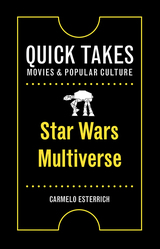 Star Wars Multiverse
Carmelo Esterrich
Rutgers University Press, 2021 Star Wars may have started out as a film about a Manichean battle between good and evil, but as countless filmmakers, novelists, animators, fan artists and even cosplayers have taken the opportunity to play in the fictional world George Lucas created, it has expanded into something far greater, resulting in a richly layered and diverse Star Wars multiverse.
Drawing from a full range of Star Wars media, including comics, children’s books, fan films, and television shows like Clone Wars and The Mandalorian, Carmelo Esterrich explores how these stories set in a galaxy far far away reflect issues that hit closer to home. He examines what they have to say about political oppression, authoritarianism, colonialism, discrimination, xenophobia, and perpetual war. Yet he also investigates subtler ways in which the personal is political within the multiverse, including its articulations of gender and sexuality, its cultural hierarchies of language use, and its complex relationships between humans, droids and myriad species. This book demonstrates that the Star Wars multiverse is not just a stage for thrilling interstellar battles, but also an exciting space for interpretation and discovery.
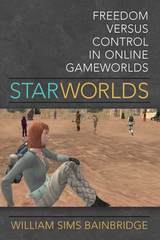 Star Worlds: Freedom Versus Control in Online Gameworlds
William Sims Bainbridge
University of Michigan Press, 2016 Star Worlds explores the future-oriented universe of online virtual worlds connected with popular science fiction—specifically, with Star Wars and Star Trek—that have been inhabited for over a decade by computer gamers. The Star Wars and Star Trek franchises, both of which have shaped the dominant science fiction mythologies of the last half-century, offer profound conceptions of the tension between freedom and control in human economic, political, and social interactions. William Sims Bainbridge investigates the human and technological dynamics of four online virtual worlds based on these two very different traditions: the massively multiplayer online games Star Wars Galaxies; Star Wars: The Old Republic; Star Trek Online; and the Star Trek community in the non-game, user-created virtual environment, Second Life.
The four “star worlds” explored in this book illustrate the dilemmas concerning the role of technology as liberator or oppressor in our postindustrial society, and represent computer simulations of future possibilities of human experience. Bainbridge considers the relationship between a real person and the role that person plays, the relationship of an individual to society, and the relationship of human beings to computing technology. In addition to collecting ethnographic and quantitative data about the social behavior of other players, he has immersed himself in each of these worlds, role-playing 14 avatars with different skills and goals to gain new insights into the variety of player experience from a personal perspective.
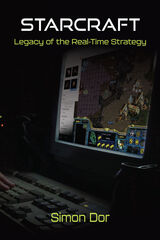 StarCraft: Legacy of the Real-Time Strategy
Simon Dor
University of Michigan Press, 2024 StarCraft (Blizzard Entertainment, 1998) is a real-time strategy video game, placing the player in command of three extraterrestrial races fighting against each other for strategic control of resources, terrain, and power. Simon Dor examines the game’s unanticipated effect by delving into the history of the game and the two core competencies it encouraged: decoding and foreseeing. Although StarCraft was not designed as an e-sport, its role in developing foreseeing skills helped give rise to one of the earliest e-sport communities in South Korea.
Apart from the game’s clear landmark status, StarCraft offers a unique insight into changes in gaming culture and, more broadly, the marketability and profit of previously niche areas of interest. The book places StarCraft in the history of real-time strategy games in the 1990s—Dune II, Command & Conquer, Age of Empires—in terms of visual style, narrative tropes, and control. It shows how design decisions, technological infrastructures, and a strong contribution from its gaming community through Battle.net and its campaign editor were necessary conditions for the flexibility it needed to grow its success. In exploring the fanatic clusters of competitive players who formed the first tournaments and professionalized gaming, StarCraft shows that the game was key to the transition towards foreseeing play and essential to competitive gaming and e-sports.
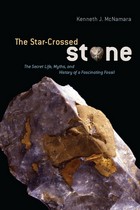 The Star-Crossed Stone: The Secret Life, Myths, and History of a Fascinating Fossil
Ken McNamara
University of Chicago Press, 2010 Throughout the four hundred thousand years that humanity has been collecting fossils, sea urchin fossils, or echinoids, have continually been among the most prized, from the Paleolithic era, when they decorated flint axes, to today, when paleobiologists study them for clues to the earth’s history.
In The Star-Crossed Stone, Kenneth J. McNamara, an expert on fossil echinoids, takes readers on an incredible fossil hunt, with stops in history, paleontology, folklore, mythology, art, religion, and much more. Beginning with prehistoric times, when urchin fossils were used as jewelry, McNamara reveals how the fossil crept into the religious and cultural lives of societies around the world—the roots of the familiar five-pointed star, for example, can be traced to the pattern found on urchins. But McNamara’s vision is even broader than that: using our knowledge of early habits of fossil collecting, he explores the evolution of the human mind itself, drawing striking conclusions about humanity’s earliest appreciation of beauty and the first stirrings of artistic expression. Along the way, the fossil becomes a nexus through which we meet brilliant eccentrics and visionary archaeologists and develop new insights into topics as seemingly disparate as hieroglyphics, Beowulf, and even church organs.
An idiosyncratic celebration of science, nature, and human ingenuity, The Star-Crossed Stone is as charming and unforgettable as the fossil at its heart.
 Stardust
Léonora Miano
Seagull Books, 2026 An unflinching look at the realities of racism, poverty, and exclusion in contemporary France—told through the eyes of a young Cameroonian mother navigating life on society’s edge.
At just twenty-three, Louise finds herself stranded in a Paris shelter with her baby, Bliss, in her arms while battling homelessness, racism, and the struggles that come with being a female immigrant trying to keep her dignity alive. Yet amid the chaos, Louise encounters a fragile network of mothers and survivors from the Maghreb and sub-Saharan Africa, each carrying their own story of violence, addiction, and resilience.
Based on a pivotal moment in author Léonora Miano’s own life, Stardust is a luminous story of the quiet power of choosing life. The novel was first composed over twenty years ago and remained unpublished for years. Now, Miano invites readers into her world, shedding light on the invisible corners of French society and offering a moving meditation on motherhood, dignity, and renewal.
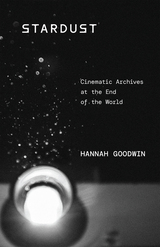 Stardust: Cinematic Archives at the End of the World
Hannah Goodwin
University of Minnesota Press, 2024 An exploration of the fundamental bond between cinema and the cosmos
The advent of cinema occurred alongside pivotal developments in astronomy and astrophysics, including Albert Einstein’s theories of relativity, all of which dramatically altered our conception of time and provided new means of envisioning the limits of our world. Tracing the many aesthetic, philosophical, and technological parallels between these fields, Stardust explores how cinema has routinely looked toward the cosmos to reflect our collective anxiety about a universe without us. Employing a “cosmocinematic gaze,” Hannah Goodwin uses the metaphorical frameworks from astronomy to posit new understandings of cinematic time and underscore the role of light in generating archives for an uncertain future. Surveying a broad range of works, including silent-era educational films, avant-garde experimental works, and contemporary blockbusters, she carves out a distinctive area of film analysis that extends its reach far beyond mainstream science fiction to explore films that reckon with a future in which humans are absent. This expansive study details the shared affinities between cinema and the stars in order to demonstrate how filmmakers have used cosmic imagery and themes to respond to the twentieth century’s moments of existential dread, from World War I to the atomic age to our current moment of environmental collapse. As our outlook on the future continues to change, Stardust illuminates the promise of cinema to bear witness to humanity’s fragile existence within the vast expanse of the universe.
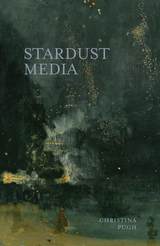 Stardust Media
Christina Pugh
University of Massachusetts Press, 2020 Christina Pugh's fifth book of poems explores the technologies both ancient and new that inhabit our contemporary cultural moment. Mapping an uncanny journey through the clusters of media we encounter daily but seldom stop to contemplate, Pugh's focused descriptions, contrasting linguistic textures, and acute poetic music become multifarious sources of beauty, disruption, humor, and hurt. Here, Netflix and YouTube share space with eighteenth-century paintings, Italian graffiti, ballet, Kurt Cobain's recordings, and even a collection of rocks. Whether technology is a vessel for joy or grief in these poems, it is always an expression of our continuing desire to invent and to mediate. At once personal archive and cultural barometer, Stardust Media traces the moving constellations of life in the distant twenty-first century, "a kaleidoscope / . . . half-filled with sky-blue glass-cut blossoming, / then labored to crystallize."
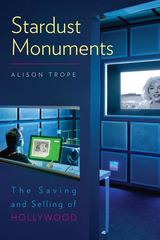 Stardust Monuments: The Saving and Selling of Hollywood
Alison Trope
Dartmouth College Press, 2012 Stardust Monuments spotlights the enduring efforts to memorialize and canonize the history and meaning of Hollywood and American film culture. In this engaging analysis, Alison Trope explores the tensions between art and commerce as they intersect in a range of nonprofit and for-profit institutions and products. An insightful tour of Hollywood’s past, present, and future, Stardust Monuments examines the establishment of film libraries and museums beginning in the mid 1930s, the many failed attempts to open a Hollywood museum ranging from the 1960s to today, and the more successful recent corporate efforts to use Hollywood’s past in theme restaurants and parks, classic movie channels, and DVD boxed sets. This fascinating narrative details the ongoing struggle to champion and codify Hollywood’s legacy, a struggle engaged in by Hollywood stars and corporate executives, as well as memorabilia collectors and users of IMDb.
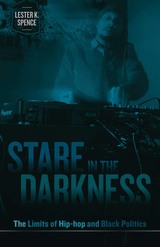 Stare in the Darkness: The Limits of Hip-hop and Black Politics
Lester K. Spence
University of Minnesota Press, 2010 Rap’s critique of police brutality in the 1980s. The Hip Hop Political Convention. The rise (and fall) of Kwame Kilpatrick, the “hip-hop mayor” of Detroit. Barack Obama echoing the body language of Jay-Z on the campaign trail.
A growing number of black activists and artists claim that rap and hip-hop are the basis of an influential new urban social movement. Simultaneously, black citizens evince concern with the effect that rap and hip-hop culture exerts on African American communities. According to a recent Pew survey conducted on the opinions of Black Americans, 71 percent of blacks think that rap is a bad influence. To what extent are African American hopes and fears about hip-hop’s potential political power justified? In Stare in the Darkness, Lester K. Spence answers this question using a blend of neoliberal analysis, survey data, experiments, and case studies.
Spence finds that rap does in fact influence black political attitudes. However, rap also reproduces rather than critiques neoliberal ideology. Furthermore, black activists seeking to create an innovative model of hip-hop politics are hamstrung by their reliance on outmoded forms of organizing. By considering the possibilities inherent in the most prolific and prominent activities of hip-hop politics, Stare in the Darkness reveals, in a clear and practical manner, the political consequences of rap culture for black publics.
Staredown: Another Year Inside Boxing
Thomas Hauser
University of Arkansas Press, 2020 Each year, readers, writers, and critics alike look forward to Thomas Hauser’s newest collection of articles about the contemporary boxing scene. Reviewing his 2019 collection, Booklist proclaimed, “It's hard to think of another sports journalist who knows more about his or her sport of choice. As it does every year, Hauser’s anthology laps the field. The man is a treasure.”
Staredown continues this tradition of excellence with inside reporting from the dressing room before some of last year’s biggest fights, in-depth investigations into corruption in boxing, and more. Hauser also moves beyond the norm to explore incidents like street fights and examine boxing’s storied history in new and creative ways.
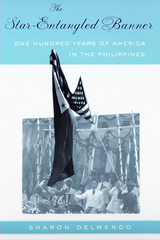 The Star-Entangled Banner: One Hundred Years of America in the Philippines
Delmendo, Sharon
Rutgers University Press, 2004 During a ceremony held in 1996 to commemorate the fiftieth anniversary of formal Philippine independence, the U.S. flag was being lowered while the Philippine flag was being raised, and the two became entangled. In The Star-Entangled Banner, Sharon Delmendo demonstrates that this incident is indicative of the longstanding problematic relationship between the two countries. When faced with a national crisis or a compelling need to reestablish its autonomy, each nation paradoxically turns to its history with the other to define its place in the world.
Each chapter of the book deals with a separate issue in this linked history: the influence of Buffalo Bill’s show on the proto-nationalism of José Rizal, who is often described as the “First Filipino”; the portrayal of the Philippines in American children’s books; Back to Bataan, a World War II movie starring John Wayne; the post-independence fiction of F. Sionil José; and the refusal of the U..S military to return the Balangiga Bells, which were taken as war booty during the Philippine-American War. Ultimately, Delmendo demonstrates how the effects of U.S. imperialism in the Philippines continue to resonate in U.S. foreign policy in the post cold war era and the war on terrorism.
Stark Decency: German Prisoners of War in a New England Village
Allen V. Koop
Dartmouth College Press, 1988 Stark Decency is a window into the events of two vastly different worlds: German combat veterans captured in North Africa and Normandy, and the small New Hampshire logging town which found itself hosting the prison camp. Each side was forced to confront its prejudices and fears, and examine the merits and flaws of its ideology. Then, an astonishing thing happened: in their rural isolation, sharing harsh weather conditions and the pinch of wartime rationing, friendships began to develop. Prisoners and their guards sometimes even worked together to meet the daily pulpwood quotas, and little handmade gifts to the local villagers cemented friendships that continue to this day.
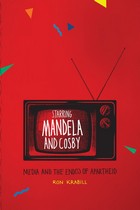 Starring Mandela and Cosby: Media and the End(s) of Apartheid
Ron Krabill
University of Chicago Press, 2010 During the worst years of apartheid, the most popular show on television in South Africa—among both Black and White South Africans—was The Cosby Show. Why did people living under a system built on the idea that Black people were inferior and threatening flock to a show that portrayed African Americans as comfortably mainstream? Starring Mandela and Cosby takes up this paradox, revealing the surprising impact of television on racial politics.
The South African government maintained a ban on television until 1976, and according to Ron Krabill, they were right to be wary of its potential power. The medium, he contends, created a shared space for communication in a deeply divided nation that seemed destined for civil war along racial lines. At a time when it was illegal to publish images of Nelson Mandela, Bill Cosby became the most recognizable Black man in the country, and, Krabill argues, his presence in the living rooms of white South Africans helped lay the groundwork for Mandela’s release and ascension to power.
Weaving together South Africa’s political history and a social history of television, Krabill challenges conventional understandings of globalization, offering up new insights into the relationship between politics and the media.
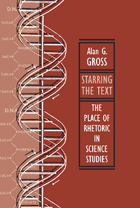 Starring the Text: The Place of Rhetoric in Science Studies
Alan G. Gross
Southern Illinois University Press, 2006 Starring the Text: The Place of Rhetoric in Science Studies firmly establishes the rhetorical analysis of science as a respected field of study. Alan G. Gross, one of rhetoric’s foremost authorities, summarizes the state of the field and demonstrates the role of rhetorical analysis in the sciences. He documents the limits of such analyses with examples from biology and physics, explores their range of application, and sheds light on the tangled relationships between science and society. In this deep revision of his important Rhetoric of Science, Gross examines how rhetorical analyses have a wide range of application, effectively exploring the generation, spread, certification, and closure that characterize scientific knowledge. Gross anchors his position in philosophical rather than in rhetorical arguments and maintains there is rhetorical criticism from which the sciences cannot be excluded. Gross employs a variety of case studies and examples to assess the limits of the rhetorical analysis of science. For example, in examining avian taxonomy, he demonstrates that both taxonomical and evolutionary species are the product of rhetorical interactions. A review of Newton’s two formulations of optical research illustrates that their only significant difference is rhetorical, a difference in patterns of style, arrangement, and argument. Gross also explores the range of rhetorical analysis in his consideration of the “evolution of evolution” of Darwin’s notebooks. In his analysis of science and society, he explains the limits of citizen action in executive, judicial, and legislative democratic realms in the struggle to prevent, ameliorate, and provide adequate compensation for occupational disease. By using philosophical, historical, and psychological perspectives, Gross concludes, rhetorical analysis can also supplement other viewpoints in resolving intellectual problems. Starring the Text, which includes fourteen illustrations, is an updated, readable study geared to rhetoricians, historians, philosophers, and sociologists interested in science. The volume effectively demonstrates that the rhetoric of science is a natural extension of rhetorical theory and criticism.
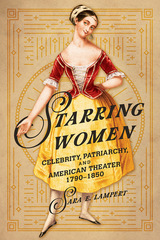 Starring Women: Celebrity, Patriarchy, and American Theater, 1790-1850
Sara E. Lampert
University of Illinois Press, 2020 Women performers played a vital role in the development of American and transatlantic entertainment, celebrity culture, and gender ideology. Sara E. Lampert examines the lives, careers, and fame of overlooked figures from Europe and the United States whose work in melodrama, ballet, and other stage shows shocked and excited early U.S. audiences. These women lived and performed the tensions and contradictions of nineteenth-century gender roles, sparking debates about women's place in public life. Yet even their unprecedented wealth and prominence failed to break the patriarchal family structures that governed their lives and conditioned their careers. Inevitable contradictions arose. The burgeoning celebrity culture of the time forced women stage stars to don the costumes of domestic femininity even as the unsettled nature of life in the theater defied these ideals. A revealing foray into a lost time, Starring Women returns a generation of performers to their central place in the early history of American theater.
The Starry Messenger
George Keithley
University of Pittsburgh Press, 2003 "Keithley’s talent is remarkable; he seems to possess Whitman’s visionary imagination, that rare ability to evoke powerful, scaled-down, lyric details in the service of a vast structure."
--American Poetry Review
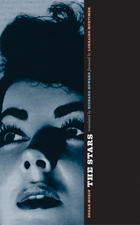 The Stars
Edgar Morin
University of Minnesota Press, 2005 Worshipped as heroes, treated as gods, movie stars are more than objects of admiration. A star's influence touches on every aspect of ordinary life, dictating taste in fashion, lifestyle, and desire. Edgar Morin's remarkable investigation into the cultural and social significance of the star system traces its evolution from the earliest days of the cinema - when stars like Chaplin, Garbo, and Valentino lived at a distance from their fans, far beyond all mortals, to the postwar era in which stars like Humphrey Bogart and Marilyn Monroe became familiar and familial, less unapproachable but more moving, and concludes with an analysis of the furious religious adulation surrounding the life and death of James Dean. Ultimately, Morin finds, stars are more than just creations of the movie studios; they serve as intermediaries between the real and the imaginary. Today, with the cult of fame more pervasive and influential than ever, The Stars remains a vibrant, vital, and surprising work.
 The Stars Are Back: The St. Louis Cardinals, the Boston Red Sox, and Player Unrest in 1946
Jerome M. Mileur
Southern Illinois University Press, 2013 In 1946, as the aftershocks of World War II still trembled across the globe, America returned to its favorite pastime: baseball. In The Stars Are Back, Jerome M. Mileur offers a fascinating account of this storied season and of the backstage battle that would forever transform the game of professional baseball. Mileur begins with one of the most famous clashes in major league history: the neck-and-neck race to the National League pennant between the St. Louis Cardinals and the Brooklyn Dodgers. As these two iconic teams engaged in a bitter struggle leading to the first-ever playoff to determine the winner of the National League pennant, the Boston Red Sox blazed a trail to the top of the American League to face the Cardinals in the World’s Series, as it was then called. But while the nation was riveted by the return of its beloved baseball heroes, the game behind the scenes was just as dramatic. As the threat of unionization loomed and the Mexican League continued to lure players away from the United States with lucrative contracts, tensions between players and team owners mounted. The result was a standoff for control of the game that would culminate in the Magna Carta of baseball and the creation of standard contracts for players, ushering in the modern era of baseball. Set against the backdrop of a country recovering from war, facing the new adversary of Communism, and absorbing the emotional impact of the atomic bomb, The Stars Are Back tells the story of a nation hungry for a return to normalcy and a game poised on the brink of new horizons.
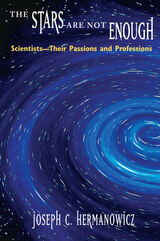 The Stars Are Not Enough: Scientists--Their Passions and Professions
Joseph C. Hermanowicz
University of Chicago Press, 1998 Based on sixty interviews with physicists at universities across the United States, The Stars are Not Enough offers a detailed and intimate account of the worlds in which scientists work. Joseph C. Hermanowicz looks at a range of scientists from young graduate students to older professionals well into their careers. The result is a colorful portrait of a profession and its diverse cast of characters.
These deeply personal narratives reveal dreams of fame and glory, in which scientists confess their ambitions of becoming the next Newton or Einstein. However, these scientists also discuss the meaning of success and failure. We hear their stories of aspiration and anxiety, disappointment and tragedy, hope and achievement; we are privy to their doubts and to what they consider to be their limitations and weaknesses. As the scientists age in their professions, the specter of failure often visits them, and they have to accept something less than scientific immortality or even the Nobel Prize.
Ultimately these stories give us more than an inside look at the details of careers in science, they also examine ambition by uncovering the forces that drive people in their professions and by describing how these forces persist or fade over time. Ambition for greatness often ignites a career and often sustains it. Yet, as Hermanowicz's study reveals, greatness eludes nearly all people in their heroic quests for extraordinary achievement. The Stars Are Not Enough offers a fascinating account that will appeal to anyone interested in how people's dreams blossom and evolve.
Stars as Laboratories for Fundamental Physics: The Astrophysics of Neutrinos, Axions, and Other Weakly Interacting Particles
Georg G. Raffelt
University of Chicago Press, 1996 The first extended work of its kind, Stars as Laboratories for Fundamental Physics stands at the intersection of two burgeoning fields, astrophysics and particle physics. Georg Raffelt, one of the world's leading researchers in this field, describes what the study of stars reveals about fundamental particle interactions.
Raffelt presents the many uses of stellar astrophysics for research in basic particle physics. He focuses primarily on the properties and nongravitational interactions of elementary particles. Numerous graphs and figures complement the text.
Stars as Laboratories for Fundamental Physics is a valuable reference for cosmologists, astrophysicists, and particle physicists.
 Stars at Noon: Poems from the Life of Jacqueline Cochran
Enid Shomer
University of Arkansas Press, 2001 These poems give voice to the life of the first woman to fly faster than the speed of sound. While Jacqueline Cochran was alive, no man or woman in the world could match her records for speed, distance, and altitude flying. Founder and director of the Women’s Airforce Service Pilots (WASP) during World War II, Cochran continued to fly competitively until she was sixty, owned and operated her own line of designer cosmetics for three decades, ran for Congress, and generally placed herself on the path of history. Having begun life as a foundling in the crushing poverty of a lumber company town of the Florida panhandle, she described her life as “a passage from sawdust to stardust.” Yet after her death she has barely been remembered. Poet Enid Shomer brings back this mercurial, dazzling, powerful woman. These poems speak in her voice and in the voices of her mother, teachers, husband, confidants, and political opponents, shaped by Shomer’s consummate formal control and stunning lyricism.
Stars Fell on Alabama
Carl Carmer
University of Alabama Press, 2000 Stars Fell on Alabama is truly a classic. The book enjoyed enormous popularity and notoriety when it was first published (it was a selection of The Literary Guild and also sold widely in Europe). It can be described as a book of folkways—not journalism, or history, or a novel. At times it is impressionistic; at other times it conveys deep insights into the character of Alabama. Carmer visited every region of the state, always accompanied by someone intimately familiar with the locality. The mosaic that emerges from the pages of his book portrays Alabama’s human landscape in all its variety, and it is a work essential to an understanding of Alabama and its culture.
Stars in My Eyes
Don Bachardy
University of Wisconsin Press, 2011 Stars in My Eyes is a revealing and entertaining collection of celebrity portraits, rendered both in acute drawings and in finely observed prose. In the 1970s and 1980s, internationally known artist Don Bachardy made portraits from life, depicting the actors, writers, artists, composers, directors, and Hollywood elite that he and his partner Christopher Isherwood knew. He then made detailed notes about these portrait sittings in the journal he has kept for more than forty years. The result is a unique document: we enter the mind of the artist as he records the images and behavior of his celebrity subjects—from Ruby Keeler and Barbara Stanwyck to Jack Nicholson and Linda Ronstadt—during their often intense collaboration with him. Finalist, Lambda Literary Foundation Book Award
The Stars That Fell: Poems
Gary Short
University of Nevada Press, 2026 The Stars That Fell infuses poetry with a new meaning for modern Nevada and the American West. Using autobiographical details and testimony mixed with Nevada history and folklore, this poetry collection focuses on and includes the scars left by the mining industry, the military complex, and the treatment of Indigenous peoples to tell the story of the complex relationship between the people and the land.
Through his poems, Gary Short illuminates the humanity of the people of Nevada and the American West, specifically the rural communities that often get left out of the narrative. Focusing on family and the relationships between characters, he extends feelings of hope, solace, forgiveness, and even wisdom throughout this collection.
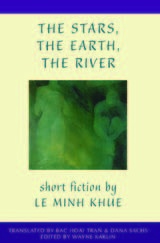 The Stars, The Earth, The River: Short Stories by Le Minh Khue
Le Minh Khue
Northwestern University Press, 1997 This collection of 14 stories—each a harrowing sketch of the Vietnam War and its aftermath—offers American readers a glimpse of familiar territory, but from an unfamiliar perspective. Often writing from a young woman's point of view, Le Minh Khue, a war veteran who served in the Youth Volunteers Brigade, uses simple, understated prose to describe numbing horrors. Her stories explore themes such as love and war, the tangles of family relationships, and the complexities of post-war life. Khue gives readers a look into Vietnam before, during, and after the war with the United States. The Stars, the Earth, the River contains an excellent introduction by the translators, grounding the stories in Le Minh Khue's personal history. You simultaneously feel the rage of the author and the narrator when Khue disparagingly notes that the conversations around her center on luxuries, motor scooters, and business deals. Of what use, these stories ask, is such suffering? How can a culture honor the losses of war?
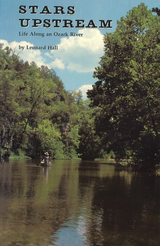 Stars Upstream: Life Along an Ozark River
Leonard Hall
University of Missouri Press, 1969 This chronicle of life along the Current and Jacks Fork rivers in the Missouri Ozarks has been called "required reading for everyone interested in the future of America." First published in 1958, it remains unsurpassed as an example of one man's love for the land and rivers around him and of a way of life all too much in danger of being lost to us. The rivers described in Stars Upstream were designated by Congress in 1964 as the Ozark National Scenic Riverways, creating America's first national river. Granting of national park status has changed the area in many ways--the river system is now heavily used for recreational purposes--yet the concerns presented by Hall about the dangers of commercialism, exploitation, and pollution are still very much with us. Stars Upstream has played an invaluable role in promoting wise use of these rivers and should be read by everyone interested in preserving America's streams and wildlands as a national heritage.
Starshine & Clay
Kamilah Aisha Moon
Four Way Books, 2017 We are making our lives up “here on this bridge / between starshine and clay” (Lucille Clifton). Addressing tough circumstances tenderly, this book is about life—what we inherit, what we create, what shapes us, what’s possible.
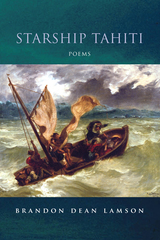 Starship Tahiti: Poems
Brandon Dean Lamson
University of Massachusetts Press, 2013 The poems in Brandon Dean Lamson's first volume, Starship Tahiti, explore imprisoned bodies and the tension between captivity and imagination. Beginning on Rikers Island, the book traces a creation myth in reverse, moving from prison to the spacious arches of Grand Central Station to the shores of the Chesapeake Bay.
Lamson examines themes of violence, gender, and identity in various real and imagined settings where inmates read Antigone, Howlin' Wolf sings in a black barbershop, and Metallica records burn on a Viking altar. Throughout these shifts, the poems construct fractured narratives that subvert linear storytelling. The layering of voice and imagery in this collection transgresses boundaries between the secular and the sacred, and between the communal and the personal. As the speaker of "Portland Bardo" says, "The fragile, in between state of larvae hatching / is no less desirable than full bloom in a city of roses, if such a city can ever be found."
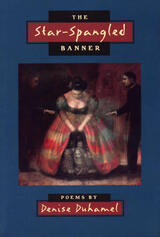 The Star-Spangled Banner
Denise Duhamel
Southern Illinois University Press, 1999 The Star-Spangled Banner, Denise Duhamel's sixth book of poems, is about falling in love, American-style, with someone who is not American. In the title poem, a small American girl mishears the first line of "The Star-Spangled Banner" as "José, can you see?", which leads her to imagine a foreign lover of an American woman dressed in a star-spangled gown. The misunderstandings caused by language recur throughout the book: contemplating what "yes" means in different cultures; watching Nickelodeon's "Nick at Nite" with a husband who grew up in the Philippines and never saw The Patty Duke Show; misreading another poet's title "The Difference Between Pepsi and Coke" as "The Difference Between Pepsi and Pope" and concluding that "Pepsi is all for premarital sex. / The Pope won't stain your teeth." Misunderstandings also abound as characters mingle with others from different classes. In "Cockroaches," a father-in-law refers to budget-minded American college students backpacking in Europe as cockroaches, not realizing his daughter-in-law was once, not so long ago, such a student/roach herself. With welcome levity and refreshing irreverence, The Star-Spangled Banner addresses issues of ethnicity, class, and gender in America.
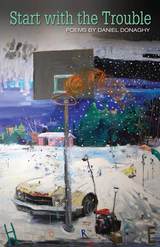 Start with the Trouble: Poems
Daniel Donaghy
University of Arkansas Press, 2009 In his second collection of poems, Daniel Donaghy uses the power of poetry to connect the Kensington section of Philadelphia he knew as a boy––a place replete with crime, poverty, fractured families, and various other kinds of darkness––to upstate New York’s woods, rural Connecticut’s town greens and small churches, Vancouver’s back alleys, the killing ground of the 1864 Sand Creek Massacre in Kiowa County, Colorado, and the shores of ancient Greece. In doing so, he examines the relationship between memory and identity and strives to give voice to those who might otherwise be forgotten by history. Start with the Trouble is the place of fist fights and first kisses, where we sit beside the dying and where we sing to those not yet born. It is where Michelangelo’s Pieta recreates itself on a Kensington sidewalk, where a mother watches helplessly as two older boys dangle her son from the roof of a building, where a prostitute writes poems between tricks before she disappears without a trace. It is where Bruce Springsteen goes back in time to woo Circe and the Sirens, where a father returns from the dead in the voice of Babe Ruth, where a mother’s spirit rises from the shadows of spruce trees, where Santa forsakes his reindeer and slides into town behind sled dogs. It is where simple gestures such as opening a car trunk or loading a wheelbarrow become portals into faraway, nightmarish worlds in which the young are forced to bear too much witness to the world. Start with the Trouble is a place where beauty exists amidst every kind of ugliness, and where that beauty is made even more precious because of the depths from which it rises.
 A Starter's Guide for Academic Library Leaders: Advice in Conversation
Amanda Clay Powers
American Library Association, 2019 The path towards leadership starts with you. But you don’t have to go it alone. For this book, the authors sat down with many of the library leaders they most admire for a series of conversations about the aspects of the job that they find the most fascinating (and challenging). Much like the chats you might have over coffee at a conference or with a mentor, these frank discussions will nourish you with nuts-and-bolts wisdom on a diverse range of academic library management issues. Among the topics and situations broached are - balancing personal values against the common refrain “you don’t get to be who you want to be in positions like ours”;
- five questions to ask that reveal much about organizational culture and climate;
- creating a culture of change, including why a newly promoted director chose to make the most drastic changes in the first 100 days;
- forming a “dean team” to help frame responses with consideration to institutional culture;
- the value of demystifying the budget for the entire library staff;
- using tools such as a personal “learning journal” to fuel professional development;
- cultivating a personal network by setting up meetings at local libraries during conferences;
- the risks that result from jumping into a situation too fast and boxing yourself into a corner;
- lessons learned from failed initiatives;
- examples of navigating controversies, such as a director’s response to a WPA mural with a racist message; and
- managing facilities, with an example of how injecting a previously ignored library voice into a building project led to a tripling of the space.
Between these covers you’ll find guidance, ideas, and inspiration as you continue your leadership journey.
 Starting and running a nonprofit organization
Joan M. Hummel
University of Minnesota Press, 1980 A best-selling resource on nonprofit management.
Starting and Running a Nonprofit Organization is a book for people who are forming new nonprofits; thinking about converting an informal, grassroots group into tax-exempt status; reorganizing an existing agency; or currently managing a nonprofit. It provides practical and basic how-to information on legal, tax, organizational, and other issues particular to nonprofits.
This one-of-a-kind resource has been an invaluable guide to nonprofit management for more than fifteen years. Its unique, compact format provides all of the necessary information in an easy-to-understand style. The long-awaited revised edition retains all of the useful features of the original, adding important new insights and strategies for the challenges of today's nonprofit operating climate.
The book describes, step-by-step, all of the phases of creating and operating a new nonprofit, including incorporation, establishing a board of directors, writing bylaws, obtaining tax-exempt status, creating a strategic plan, budgeting and grant seeking, understanding accounting principles, managing human resources, and creating a community relations plan. The information provided is specific enough to be immediately useful, yet can be generalized to any nonprofit practitioner in any state. Handy checklists and worksheets, as well as a list of sources for assistance and management development and a bibliography on nonprofit management, make Starting and Running a Nonprofit Organization a valuable and unique resource.
"The book emphasizes small non-profit groups, and it covers bylaws, registration requirements, accounting procedures, strategic planning, fund raising, public relations, and assembling a board of directors. Ms. Hummel includes rudimentary work sheets on budgeting, shoring up mission objectives. and taking advantage of news-media opportunities." --The Chronicle of Philanthropy
"A valuable and unique resource." --Nonprofit Management News
Joan M. Hummel has served as both staff and board member for a number of nonprofit organizations, as well as working with foundations and other supporters of nonprofits.
The Center for Nonprofit Management is a department of the Graduate School of Business at the University of St. Thomas in Minneapolis and St. Paul. It provides training and guidance in all aspects of the nonprofit sector to existing organizations as well as individuals or groups who are seeking help in starting a nonprofit.
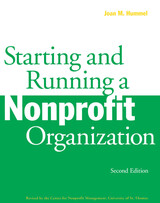 Starting and Running a Nonprofit Organization
Joan M. Hummel
University of Minnesota Press, 1996 Starting and Running a Nonprofit Organization is a book for people who are forming new small nonprofits; thinking about converting an informal, grassroots group into tax-exempt status; reorganizing an existing agency; or currently managing a nonprofit. It provides practical and basic how-to information on legal, tax, organizational, and other issues particular to nonprofits. This one-of-a-kind resource has been a valuable guide to nonprofit management for decades. While much of the information originated in an earlier era of nonprofit formation, it remains highly useful for gaining an overview and creating an action plan for people entering this realm of organizational management. Its compact format provides information in an easy-to-understand style. The book describes, step-by-step, the typical phases of creating and operating a new nonprofit, including incorporation, establishing a board of directors, writing bylaws, obtaining tax-exempt status, creating a strategic plan, budgeting and grant seeking, understanding accounting principles, managing human resources, and creating a community relations plan. The Center for Nonprofit Management is a department of the Graduate School of Business at the University of St. Thomas in Minneapolis and St. Paul. It provides training and guidance in all aspects of the nonprofit sector to existing organizations as well as individuals or groups who are seeking help in starting a nonprofit.
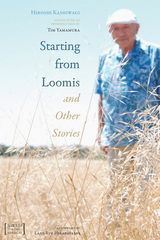 Starting from Loomis and Other Stories
Hiroshi Kashiwagi
University Press of Colorado, 2013 A memoir in short stories, Starting from Loomis chronicles the life of accomplished writer, playwright, poet, and actor Hiroshi Kashiwagi. In this dynamic portrait of an aging writer trying to remember himself as a younger man, Kashiwagi recalls and reflects upon the moments, people, forces, mysteries, and choices—the things in his life that he cannot forget—that have made him who he is. Central to this collection are Kashiwagi’s confinement at Tule Lake during World War II, his choice to answer “no” and “no” to questions 27 and 28 on the official government loyalty questionnaire, and the resulting lifelong stigma of being labeled a “No-No Boy” after his years of incarceration. His nonlinear, multifaceted writing not only reflects the fragmentations of memory induced by traumas of racism, forced removal, and imprisonment but also can be read as a bold personal response to the impossible conditions he and other Nisei faced throughout their lifetimes.
 The Starting Line: Latina/o Children, Texas Schools, and National Debates on Early Education
By Robert Crosnoe
University of Texas Press, 2020 How can we create high-quality learning environments for children from socially, politically, and economically marginalized groups? How do early childhood programs help to overcome the challenges created by poverty? Seeking to answer these questions, The Starting Line delves into the ups and downs of early education programs serving Latinas/os in Texas, using the state as a window into broader debates about academic opportunity and the changing demographics of the United States. Immersing readers in the day-to-day activities of Texas's early childhood education programs, Robert Crosnoe illuminates how significant obstacles can stymie the best intentions. Crosnoe pays particular attention to the complex connections among classrooms, schools, families, and communities, as well as the frequently unfolding interplay of educational philosophies. The result is a story highlighting the promises of early childhood education, the perils faced in attempting to fulfill them, and the degree to which Texas stands at the forefront of some larger movements and lags behind in others. Giving voice to bilingual educators and low-income Latina/o families, this book is a timely exploration of the strengths and needs of what will soon be the largest share of the US child population.
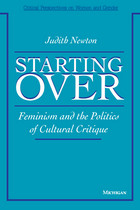 Starting Over: Feminism and the Politics of Cultural Critique
Judith Newton
University of Michigan Press, 1994 For more than a decade Judith Newton has been at the forefront of defining and promoting materialist feminist criticism. Starting Over brings together a selection of her essays that chart the establishment of feminist literary criticism in the academy and its relation to other forms of cultural criticism, including Marxist, post-Marxist, new historicist, and cultural materialist approaches, as well as cultural studies. The essays in Starting Over have functioned as exemplars of interdisciplinary thinking, mapping out the ways in which reading strategies and the constructions of history, culture, identity, change, and agency in various materialist theories overlap, and the ways in which feminist-materialist work both draws upon, revises, and complicates the vision of nonfeminist materialist critiques. They are shaped by an awareness that public knowledge is always informed by the so-called private realm of familial and sexual relations and that cultural criticism must bring together investigations of daily behaviors, economic and social relations, and the dynamics of race, class, gender, and sexual struggle. Starting Over is a brilliant synthesis of literature, history, anthropology, the many influential trends in contemporary theory, and the politics of feminism.
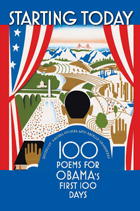 Starting Today: 100 Poems for Obama’s First 100 Days
Rachel Zucker
University of Iowa Press, 2010 Normal.dotm 0 0 1 89 512 The University of Iowa 4 1 628 12.0 0 false 18 pt 18 pt 0 0 false false false /* Style Definitions */ table.MsoNormalTable {mso-style-name:"Table Normal"; mso-tstyle-rowband-size:0; mso-tstyle-colband-size:0; mso-style-noshow:yes; mso-style-parent:""; mso-padding-alt:0in 5.4pt 0in 5.4pt; mso-para-margin:0in; mso-para-margin-bottom:.0001pt; mso-pagination:widow-orphan; font-size:12.0pt; font-family:"Times New Roman"; mso-ascii-font-family:Cambria; mso-ascii-theme-font:minor-latin; mso-fareast-font-family:"Times New Roman"; mso-fareast-theme-font:minor-fareast; mso-hansi-font-family:Cambria; mso-hansi-theme-font:minor-latin; mso-bidi-font-family:"Times New Roman"; mso-bidi-theme-font:minor-bidi;}
Starting Today contains 100 poems written during—and responding to—Barack Obama’s first 100 days in office. The poems included in this anthology, except for Elizabeth Alexander’s inauguration poem, were all written no more than a day before they appeared on the popular blog “Starting Today: Poems for the First 100 Days” http://100dayspoems.blogspot.com. The result is a work that documents the political and personal events of those crucial days through a variety of contemporary poetic voices, from the ebullient to the admiring, from the pithy to the loquacious.
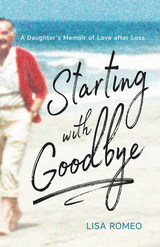 Starting with Goodbye: A Daughter's Memoir of Love after Loss
Lisa Romeo
University of Nevada Press, 2018 Starting with Goodbye begins with loss and ends with love, as a midlife daughter rediscovers her enigmatic father after his death. Lisa has little time for grief, but when her dead dad drops in for “conversations,” his absent presence invites Lisa to examine why the parent she had turned away from in life now holds her spellbound.
Lisa reconsiders the affluent upbringing he financed (filled with horses, lavish vacations, bulging closets), and the emotional distance that grew when he retired to Las Vegas and she remained in New Jersey where she and her husband earn moderate incomes. She also confronts death rituals, navigates new family dynamics, while living both in memory and the unfolding moment.
In this brutally honest yet compelling portrayal and tribute, Lisa searches for meaning, reconciling the Italian-American father—self-made textile manufacturer who liked newspapers, smoking, Las Vegas craps tables, and solitude—with the complex man she discovers influenced everything, from career choice to spouse.
By forging a new father-daughter “relationship,” grief is transformed to hopeful life-affirming redemption. In poignant, often lyrical prose, this powerful, honest book proves that when we dare to love the parent who challenged us most, it’s never too late.
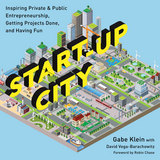 Start-Up City: Inspiring Private and Public Entrepreneurship, Getting Projects Done, and Having Fun
Gabe Klein with David Vega-Barachowitz
Island Press, 2015 There has been a revolution in urban transportation over the past five years—set off by start-ups across the US and internationally. Sleek, legible mobility platforms are connecting people to cars, trains, buses, and bikes as never before, opening up a range of new transportation options while improving existing ones. While many large city governments, such as Chicago, New York, and Washington, D.C., have begun to embrace creative forms and processes of government, most still operate under the weight of an unwieldy, risk-averse bureaucracy.
With the advent of self-driving vehicles and other technological shifts upon us, Gabe Klein asks how we can close the gap between the energized, aggressive world of start-ups and the complex bureaucracies struggling to change beyond a geologic time scale. From his experience as a food-truck entrepreneur to a ZipCar executive and a city transportation commissioner, Klein’s career has focused on bridging the public-private divide, finding and celebrating shared goals, and forging better cities with more nimble, consumer-oriented bureaucracies.
In Start-Up City, Klein, with David Vega-Barachowitz, demonstrates how to affect big, directional change in cities—and how to do it fast. Klein's objective is to inspire what he calls “public entrepreneurship,” a start-up-pace energy within the public sector, brought about by leveraging the immense resources at its disposal. Klein offers guidance for cutting through the morass, and a roadmap for getting real, meaningful projects done quickly and having fun while doing it.
This book is for anyone who wants to change the way we live in cities without waiting for the glacial pace of change in government.
 Start-Up Poland: The People Who Transformed an Economy
Jan Cienski
University of Chicago Press, 2018 Poland in the 1980s was filled with shuttered restaurants and shops that bore such imaginative names as “bread,” “shoes,” and “milk products,” from which lines could stretch for days on the mere rumor there was something worth buying. But you’d be hard-pressed to recognize the same squares—buzzing with bars and cafés—today. In the years since the collapse of communism, Poland’s GDP has almost tripled, making it the eighth-largest economy in the European Union, with a wealth of well-educated and highly skilled workers and a buoyant private sector that competes in international markets. Many consider it one of the only European countries to have truly weathered the financial crisis.
As the Warsaw bureau chief for the Financial Times, Jan Cienski spent more than a decade talking with the people who did something that had never been done before: recreating a market economy out of a socialist one. Poland had always lagged behind wealthier Western Europe, but in the 1980s the gap had grown to its widest in centuries. But the corrupt Polish version of communism also created the conditions for its eventual revitalization, bringing forth a remarkably resilient and entrepreneurial people prepared to brave red tape and limited access to capital. In the 1990s, more than a million Polish people opened their own businesses, selling everything from bicycles to leather jackets, Japanese VCRs, and romance novels. The most business-savvy turned those primitive operations into complex corporations that now have global reach.
Well researched and accessibly and entertainingly written, Start-Up Poland tells the story of the opening bell in the East, painting lively portraits of the men and women who built successful businesses there, what their lives were like, and what they did to catapult their ideas to incredible success. At a time when Poland’s new right-wing government plays on past grievances and forms part of the populist and nationalist revolution sweeping the Western world, Cienski’s book also serves as a reminder that the past century has been the most successful in Poland’s history.
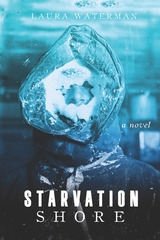 Starvation Shore
Laura Waterman
University of Wisconsin Press, 2019 In the summer of 1881, the twenty-five men of the Lady Franklin Bay Expedition watched their ship sail for home from Discovery Harbor, just 500 miles from the North Pole. Commanded by the ambitious yet underqualified Adolphus W. Greely, this crew represented the first U.S. attempt to engage in scientific study of the Arctic. The frigid landscape offered the promise of great adventure—and unknown dangers. It was an expedition Greely eagerly anticipated long before it began. Standing there on that sunny summer afternoon, no one could have known how much would go wrong.
Drawing upon historic records, diaries, and letters of the men who inhabited the makeshift shelter they called Camp Clay, Laura Waterman reimagines the true story of polar explorers fighting for their lives and their sanity under dehumanizing conditions. This gripping, tragic tale of hunger, fear, and hope is told through the eyes of men at their worst—and most desperate—moments.
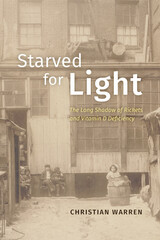 Starved for Light: The Long Shadow of Rickets and Vitamin D Deficiency
Christian Warren
University of Chicago Press, 2024 A wide-ranging history of rickets tracks the disease’s emergence, evolution, and eventual treatment—and exposes the backstory behind contemporary worries about vitamin D deficiency.
Rickets, a childhood disorder that causes soft and misshapen bones, transformed from an ancient but infrequent threat to a common scourge during the Industrial Revolution. Factories, mills, and urban growth transformed the landscape. Malnutrition and insufficient exposure to sunlight led to severe cases of rickets across Europe and the United States, affecting children in a variety of settings: dim British cities and American slave labor camps, moneyed households and impoverished ones. By the late 1800s, it was one of the most common pediatric diseases, seemingly an intractable consequence of modern life.
Starved for Light offers the first comprehensive history of this disorder. Tracing the efforts to understand, prevent, and treat rickets—first with the traditional remedy of cod liver oil, then with the application of a breakthrough corrective, industrially produced vitamin D supplements—Christian Warren places the disease at the center of a riveting medical history, one alert to the ways society shapes our views on illness. Warren shows how physicians and public health advocates in the United States turned their attention to rickets among urban immigrants, both African Americans and southern Europeans; some concluded that the disease was linked to race, while others blamed poverty, sunless buildings and cities, or cultural preferences in diet and clothing. Spotlighting rickets’ role in a series of medical developments, Warren leads readers through the encroachment on midwifery by male obstetricians, the development of pediatric orthopedic devices and surgeries, early twentieth-century research into vitamin D, appalling clinical experiments on young children testing its potential, and the eventual commercialization of all manner of vitamin D supplements. As vitamin D consumption rose in the mid-twentieth century, rickets—previously a major concern for doctors, parents, and public health institutions—faded in its severity and frequency, and as a topic of discussion. But despite the availability of drugstore supplements and fortified milk, small numbers of cases still appear today, and concerns and controversies about vitamin D deficiency in general continue to grow.
Sweeping and engaging, Starved for Light illuminates the social conditions underpinning our cures and our choices, helping us to see history’s echoes in contemporary prescriptions.
 Starved for Light: The Long Shadow of Rickets and Vitamin D Deficiency
Christian Warren
University of Chicago Press, 2024 This is an auto-narrated audiobook version of this book.
A wide-ranging history of rickets tracks the disease’s emergence, evolution, and eventual treatment—and exposes the backstory behind contemporary worries about vitamin D deficiency.
Rickets, a childhood disorder that causes soft and misshapen bones, transformed from an ancient but infrequent threat to a common scourge during the Industrial Revolution. Factories, mills, and urban growth transformed the landscape. Malnutrition and insufficient exposure to sunlight led to severe cases of rickets across Europe and the United States, affecting children in a variety of settings: dim British cities and American slave labor camps, moneyed households and impoverished ones. By the late 1800s, it was one of the most common pediatric diseases, seemingly an intractable consequence of modern life.
Starved for Light offers the first comprehensive history of this disorder. Tracing the efforts to understand, prevent, and treat rickets—first with the traditional remedy of cod liver oil, then with the application of a breakthrough corrective, industrially produced vitamin D supplements—Christian Warren places the disease at the center of a riveting medical history, one alert to the ways society shapes our views on illness. Warren shows how physicians and public health advocates in the United States turned their attention to rickets among urban immigrants, both African Americans and southern Europeans; some concluded that the disease was linked to race, while others blamed poverty, sunless buildings and cities, or cultural preferences in diet and clothing. Spotlighting rickets’ role in a series of medical developments, Warren leads readers through the encroachment on midwifery by male obstetricians, the development of pediatric orthopedic devices and surgeries, early twentieth-century research into vitamin D, appalling clinical experiments on young children testing its potential, and the eventual commercialization of all manner of vitamin D supplements. As vitamin D consumption rose in the mid-twentieth century, rickets—previously a major concern for doctors, parents, and public health institutions—faded in its severity and frequency, and as a topic of discussion. But despite the availability of drugstore supplements and fortified milk, small numbers of cases still appear today, and concerns and controversies about vitamin D deficiency in general continue to grow.
Sweeping and engaging, Starved for Light illuminates the social conditions underpinning our cures and our choices, helping us to see history’s echoes in contemporary prescriptions.
 Starved for Light: The Long Shadow of Rickets and Vitamin D Deficiency
Christian Warren
University of Chicago Press, 2024 This is an auto-narrated audiobook version of this book.
A wide-ranging history of rickets tracks the disease’s emergence, evolution, and eventual treatment—and exposes the backstory behind contemporary worries about vitamin D deficiency.
Rickets, a childhood disorder that causes soft and misshapen bones, transformed from an ancient but infrequent threat to a common scourge during the Industrial Revolution. Factories, mills, and urban growth transformed the landscape. Malnutrition and insufficient exposure to sunlight led to severe cases of rickets across Europe and the United States, affecting children in a variety of settings: dim British cities and American slave labor camps, moneyed households and impoverished ones. By the late 1800s, it was one of the most common pediatric diseases, seemingly an intractable consequence of modern life.
Starved for Light offers the first comprehensive history of this disorder. Tracing the efforts to understand, prevent, and treat rickets—first with the traditional remedy of cod liver oil, then with the application of a breakthrough corrective, industrially produced vitamin D supplements—Christian Warren places the disease at the center of a riveting medical history, one alert to the ways society shapes our views on illness. Warren shows how physicians and public health advocates in the United States turned their attention to rickets among urban immigrants, both African Americans and southern Europeans; some concluded that the disease was linked to race, while others blamed poverty, sunless buildings and cities, or cultural preferences in diet and clothing. Spotlighting rickets’ role in a series of medical developments, Warren leads readers through the encroachment on midwifery by male obstetricians, the development of pediatric orthopedic devices and surgeries, early twentieth-century research into vitamin D, appalling clinical experiments on young children testing its potential, and the eventual commercialization of all manner of vitamin D supplements. As vitamin D consumption rose in the mid-twentieth century, rickets—previously a major concern for doctors, parents, and public health institutions—faded in its severity and frequency, and as a topic of discussion. But despite the availability of drugstore supplements and fortified milk, small numbers of cases still appear today, and concerns and controversies about vitamin D deficiency in general continue to grow.
Sweeping and engaging, Starved for Light illuminates the social conditions underpinning our cures and our choices, helping us to see history’s echoes in contemporary prescriptions.
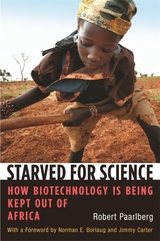 Starved for Science: How Biotechnology Is Being Kept Out of Africa
Robert PaarlbergForeword by Norman Borlaug and Jimmy Carter
Harvard University Press, 2009 Listen to a short interview with Robert PaarlbergHost: Chris Gondek | Producer: Heron & Crane
Heading upcountry in Africa to visit small farms is absolutely exhilarating given the dramatic beauty of big skies, red soil, and arid vistas, but eventually the two-lane tarmac narrows to rutted dirt, and the journey must continue on foot. The farmers you eventually meet are mostly women, hardworking but visibly poor. They have no improved seeds, no chemical fertilizers, no irrigation, and with their meager crops they earn less than a dollar a day. Many are malnourished.
Nearly two-thirds of Africans are employed in agriculture, yet on a per-capita basis they produce roughly 20 percent less than they did in 1970. Although modern agricultural science was the key to reducing rural poverty in Asia, modern farm science—including biotechnology—has recently been kept out of Africa.
In Starved for Science Robert Paarlberg explains why poor African farmers are denied access to productive technologies, particularly genetically engineered seeds with improved resistance to insects and drought. He traces this obstacle to the current opposition to farm science in prosperous countries. Having embraced agricultural science to become well-fed themselves, those in wealthy countries are now instructing Africans—on the most dubious grounds—not to do the same.
In a book sure to generate intense debate, Paarlberg details how this cultural turn against agricultural science among affluent societies is now being exported, inappropriately, to Africa. Those who are opposed to the use of agricultural technologies are telling African farmers that, in effect, it would be just as well for them to remain poor.
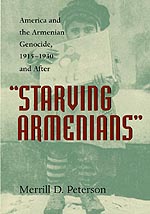 "Starving Armenians": America and the Armenian Genocide, 1915-1930 and After
Merrill D. Peterson
University of Virginia Press, 2004 The persecution and suffering of the Armenian people, a religious and cultural minority in the Ottoman Empire, reached a peak in the era of World War I at the hands of the Turks. Between 1915 and 1925 as many as 1.5 million Armenian men, women, and children died in Ottoman Turkey, victims of execution, starvation, and death marches to the Syrian desert.
In "Starving Armenians," Merrill Peterson explores the American response to these atrocities, beginning with the initial reports to President Wilson from his Ambassador to the Ottoman Empire, Henry Morgenthau, who described Turkey as "a place of horror." The West gradually began to take notice. As the New York Times carried stories about the "slow massacre of a race," public outrage over this tragedy led to an unprecedented philanthropic crusade spearheaded by Near East Relief, an organization rooted in Protestant missionary endeavors in the Near East and dedicated to saving the survivors of the first genocide of the twentieth century. The book also addresses the Armenian aspirations for an independent republic under American auspices; these hopes went unfulfilled in the peacemaking after the war and ended altogether when Armenia was absorbed into the Soviet Union.
Part of a generation who were admonished as children to "remember the starving Armenians," Peterson went to Armenia in 1997 as a Peace Corps volunteer and became fascinated by the country's troubled history. The extensive research he embarked upon afterwards revealed not only the scope of the people's hardship and amazing resilience; it located in the American effort to help the Armenians a unique perspective on our own nation's experience of the twentieth century. "Starving Armenians" is an eloquent narrative of an all but forgotten part of that experience.
--------------------------------------------------------------------------------
Merrill D. Peterson, Professor of History Emeritus at the University of Virginia, is the editor of the Library of America edition of the writings of Thomas Jefferson and author of numerous books, including Lincoln in American Memory and John Brown: The Legend Revisited.
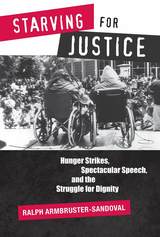 Starving for Justice: Hunger Strikes, Spectacular Speech, and the Struggle for Dignity
Ralph Armbruster-Sandoval
University of Arizona Press, 2017 In the 1990s three college campuses in California exploded as Chicano/a and Latino/a students went on hunger strikes. Through courageous self-sacrifice, these students risked their lives to challenge racial neoliberalism, budget cuts, and fee increases. The strikers acted and spoke spectacularly and, despite great odds, produced substantive change. Social movement scholars have raised the question of why some people risk their lives to create a better world. In Starving for Justice, Ralph Armbruster-Sandoval uses interviews and archival material to examine people’s willingness to make the extreme sacrifice and give their lives in order to create a more just society. Popular memory and scholarly discourse around social movements have long acknowledged the actions of student groups during the 1960s. Now Armbruster-Sandoval extends our understanding of social justice and activism, providing one of the first examinations of Chicana/o and Latina/o student activism in the 1990s. Students at University of California, Los Angeles; University of California, Santa Barbara; and Stanford University went on hunger strikes to demand the establishment and expansion of Chicana/o studies departments. They also had even broader aspirations—to obtain dignity and justice for all people. These students spoke eloquently, making their bodies and concerns visible. They challenged anti-immigrant politics. They scrutinized the rapid growth of the prison-industrial complex, racial and class polarization, and the university’s neoliberalization. Though they did not fully succeed in having all their demands met, they helped generate long-lasting social change on their respective campuses, making those learning institutions more just.
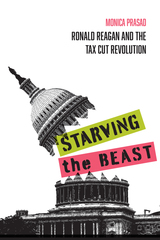 Starving the Beast: Ronald Reagan and the Tax Cut Revolution
Monica Prasad
Russell Sage Foundation, 2018 Since the Reagan Revolution of the early 1980s, Republicans have consistently championed tax cuts for individuals and businesses, regardless of whether the economy is booming or in recession or whether the federal budget is in surplus or deficit. In Starving the Beast, sociologist Monica Prasad uncovers the origins of the GOP’s relentless focus on tax cuts and shows how this is a uniquely American phenomenon.
Drawing on never-before seen archival documents, Prasad traces the history of the 1981 tax cut—the famous “supply side” tax cut, which became the cornerstone for the next several decades of Republican domestic economic policy. She demonstrates that the main impetus behind this tax cut was not business group pressure, racial animus, or a belief that tax cuts would pay for themselves.
Rather, the tax cut emerged because in America--unlike in the rest of the advanced industrial world—progressive policies are not embedded within a larger political economy that is favorable to business. Since the end of World War II, many European nations have combined strong social protections with policies to stimulate economic growth such as lower taxes on capital and less regulation on businesses than in the United State. Meanwhile, the United States emerged from World War II with high taxes on capital and some of the strongest regulations on business in the advanced industrial world. This adversarial political economy could not survive the economic crisis of the 1970s.
Starving the Beast suggests that taking inspiration from the European model of progressive policies embedded in market-promoting political economy could serve to build an American economy that works better for all.
 The State after Statism: New State Activities in the Age of Liberalization
Jonah Levy
Harvard University Press, 2006 This book assesses the changing nature of state intervention in the economies of the affluent democracies. Against a widespread understanding that contemporary developments, such as globalization and new technologies, are pressing for a rollback of state regulation in the economy, the book shows that these same forces are also creating new demands and opportunities for state intervention. Thus, state activism has shifted, rather than simply eroded.
State authorities have shifted from a market-steering orientation to a market-supporting one. Chief among the new state missions are: repairing the main varieties of capitalism (liberal, corporatist, and statist); making labor markets and systems of social protection more employment-friendly; recasting regulatory frameworks to permit countries to cross major economic and technological divides; and expanding market competition at home and abroad.
Because the changes from market steering to market support are so controversial and far-reaching, state officials often find themselves making choices that produce clear winners and losers. Such choices require a capacity to act unilaterally and decisively, even in the face of substantial societal opposition. As a result, state activism, autonomy, and occasionally imposition remain essential for meeting the challenges of today's globalizing economy.
State and Cosmos in the Art of Tenochtitlan
Richard Fraser Townsend
Harvard University Press Richard Fraser Townsend offers an interpretation of major examples of Mexica monumental art by identifying three interrelated iconographic themes: the conception of the universe as a sacred structure, the correspondence of the social order and the territory of the nation with the cosmic structure, and the representation of Tenochtitlan as the historically legitimate successor to the civilization of the past.
State and Crafts in the Qing Dynasty (1644-1911)
Christine Moll-Murata
Amsterdam University Press, 2018 This book, full of quantitative evidence and limited-circulation archives, details manufacturing and the beginnings of industrialisation in China from 1644 to 1911. It thoroughly examines the interior organisation of public craft production and the complementary activities of the private sector. It offers detailed knowledge of shipbuilding and printing. Moreover, it contributes to the research of labour history and the rise of capitalism in China through its examination of living conditions, working conditions, and wages.
State and Economy in Republican China: A Handbook for Scholars, Volumes 1 and 2
William C. Kirby
Harvard University Press, 2000 This manual for students focuses on archival research in the economic and business history of the Republican era (1911–1949). Following a general discussion of archival research and research aids for the Republican period, the handbook introduces the collections of archives in the People’s Republic of China and the Republic of China on Taiwan that contain materials in the areas of economics and business, with data on the history of the archives, descriptions of their holdings, and publications on their collections.
The second half of the work consists of guided readings in Republican-era documents, such as government decrees, regulations, and business letters, with complete vocabulary lists and explanations of terms. Also included with the handbook are facsimile reproductions of these documents.
 The State and Insurrection: New Interventions in Latin American Marxist Theory
Bruno Bosteels
University of Pittsburgh Press, 2023 Claims that students are too sensitive are familiar on and around college campuses. The ideas of cancel culture, safe spaces, and political correctness are used to shut down discussion and prevent students from being recognized as stakeholders in higher education and as advocates for their own interests. Further, universities can claim that student activists threaten academic freedom. In Sensitive Rhetorics, Kendall Gerdes puts these claims and common beliefs into conversation with rhetorical theory to argue that critiques of sensitivity reveal a deep societal discomfort with the idea that language is a form of action. Gerdes poses important questions: What kind of harm can language and representation actually do, and how? What responsibilities do college and university teachers bear toward their students? Sensitive Rhetorics explores the answers by surfacing submerged assumptions about higher education, the role of instructors and faculty, and the needs of an increasingly diverse student body.
State and Opposition in Military Brazil
By Maria Helena Moreira Alves
University of Texas Press, 1985 Based on extensive research into opposition and government documents, including the previously unavailable Manual Básico da Escola de Guerra, Maria Helena Moreira Alves provides a rich description of the long and tortuous attempt by the Brazilian military government to create a workable “national security state” in the face of determined and resilient opposition. She interviewed more than one hundred key figures in government, the military, business, professional associations, the Catholic church, grassroots organizations, and trade unions in order to analyze politically and historically the relationship between civil society and government structures in Brazil during the years 1964–1983. Her study charts the rise and subsequent decline of the military government’s power, concluding with a discussion of the abertura policy instituted under General João Batista Figueiredo.
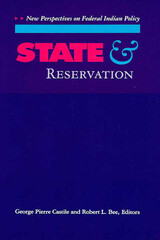 State and Reservation: New Perspectives on Federal Indian Policy
Edited by George Pierre Castile and Robert L. Bee
University of Arizona Press, 1992 Ten original essays focus on the rise, change, and persistence of the Native American reservation system. Contributors drawn from history, anthropology, sociology, and political science offer divergent points of view buttressed by historical and ethnographic case studies. Together, these articles suggest that the time has come—or is long overdue—to rethink the basic assumptions underlying Federal Indian policy.
CONTENTS
Introduction, George Pierre Castile & Robert L. Bee
Part I—Historical Foundations of the Reservation System
An Elusive Institution: The Meanings of Indian Reservations in Gold Rush California, John M. Findlay
Crow Leadership Amidst Reservation Oppression, Frederick E. Hoxie
Part II—The Nonreservation Experience
Utah Indians and the Homestead Laws, Martha C. Knack
The Enduring Reservations of Oklahoma, John H. Moore
Without Reservation: Federal Indian Policy and the Landless Tribes of Washington, Frank W. Porter, III
Part III—Power and Symbols
Riding the Paper Tiger, Robert L. Bee
Indian Sign: Hegemony and Symbolism in Federal Indian Policy, George P. Castile
Part IV—The Resource Base
Primitive Accumulation, Reservations, and the Alaska Native Claims Settlement Act, Lawrence Weiss & David C.Maas
Shortcomings of the Indian Self-Determination Policy, George S. Esber, Jr.
Getting to Yes in the New West: The Negotiation of Policy, Thomas R. McGuire
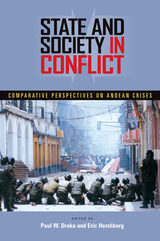 State and Society in Conflict: Comparative Perspectives on the Andean Crises
ra
University of Pittsburgh Press, 2006
State and Society in Conflict analyzes one of the most volatile regions in Latin America, the Andean states of Colombia, Venezuela, Ecuador, Peru, and Bolivia. For the last twenty-five years, crises in these five Andean countries have endangered Latin America's democracies and strained their relations with the United States. As these nations struggle to cope with demands from Washington on security policies (emphasizing drugs and terrorism), neoliberal economics, and democratic politics, their resulting domestic travails can be seen in poor economic growth, unequal wealth distribution, mounting social unrest, and escalating political instability.
The contributors to this volume examine the histories, politics, and cultures of the Andean nations, and argue that, due to their shared history and modern circumstances, these countries are suffering a shared crisis of deteriorating relations between state and society that is best understood in regional, not purely national, terms. The results, in some cases, have been semi-authoritarian hybrid regimes that lurch from crisis to crisis, often controlled through force, though clinging to a notion of democracy. The solution to these problems--whether through democratic, authoritarian, peaceful, or violent means--will have profound implications for the region and its future relations with the world.
 The State and the City
Ted Robert Gurr and Desmond King
University of Chicago Press, 1987 Many of the oldest and largest Western cities today are undergoing massive economic decline. The State and the City deals with a key issue in the political economy of cities—the role of the state. Ted Robert Gurr and Desmond S. King argue that theoreticians from both the left and the right have underestimated the significance of state action for cities. Grounding theory in empirical evidence, they argue that policies of the local and national state have a major impact on urban well-being.
Gurr and King's analysis assumes modern states have their own interests, institutional momentum, and the capacity to act with relative autonomy. Their historically based analysis begins with an account of the evolution of the Western state's interest in the viability of cities since the industrial revolution. Their agument extends to the local level, examining the nature of the local state and its autonomy from national political and economic forces.
Using cross-national evidence, Gurr and King examine specific problems of urban policy in the United States and Britain. In the United States, for example, they show how the dramatic increases in federal assistance to cities in the 1930s and the 1960s were made in response to urban crises, which simultaneously threatened national interests and offered opportunities for federal expansion of power. As a result, national and local states now play significant material and regulatory roles that can have as much impact on cities as all private economic activities.
A comparative analysis of thirteen American cities reflects the range and impact of the state's activities at the urban level. Boston, they argue, has become the archetypical postindustrial public city: half of its population and personal income are directly dependent on government spending. While Gurr and King are careful to delineate the limits to the extent and effectiveness of state intervention, they conclude that these limits are much broader than formerly thought. Ultimately, their evidence suggests that the continued decline of most of the old industrial cities is the result of public decisions to allow their economic fate to be determined in the private sector.
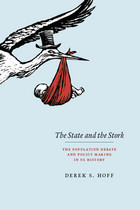 The State and the Stork: The Population Debate and Policy Making in US History
Derek S. Hoff
University of Chicago Press, 2012 From the colonial era to the present, the ever-shifting debate about America’s prodigious population growth has exerted a profound influence on the evolution of politics, public policy, and economic thinking in the United States. In a remarkable shift since the late 1960s, Americans of all political stripes have come to celebrate the economic virtues of population growth. As one of the only wealthy countries experiencing significant population growth in the twenty-first century, the United States now finds itself at a demographic crossroads, but policymakers seem unwilling or unable to address the myriad economic and environmental questions surrounding this growth.
From the founders’ fears that crowded cities would produce corruption, luxury, and vice to the zero population growth movement of the late 1960s to today’s widespread fears of an aging crisis as the Baby Boomers retire, the American population debate has always concerned much more than racial composition or resource exhaustion, the aspects of the debate usually emphasized by historians. In The State and the Stork, Derek Hoff draws on his extraordinary knowledge of the intersections between population and economic debates throughout American history to explain the many surprising ways that population anxieties have provoked unexpected policies and political developments—including the recent conservative revival. At once a fascinating history and a revelatory look at the deep origins of a crucial national conversation, The State and the Stork could not be timelier.
 State Anti-Intellectualism and the Politics of Gender and Race: Illiberal France and Beyond
Éric Fassin
Central European University Press, 2024 Eric Fassin examines the trend of State anti-intellectualism in France using the nation as a case study to demonstrate that this tendency is not limited to ostensibly illiberal regimes. He argues that today’s world requires an examination of this phenomenon beyond Cold War geopolitical divisions and highlights a global shift towards authoritarian neoliberalism. His book is a plea for the political urgency of intellectual work in a global moment of political anti-intellectualism.
The book covers the period from President Sarkozy to Prime Minister Valls and includes both firsthand and public cases of attacks against academics, not only in France, but also in Brazil, Hungary, Russia, Turkey, and the United States, with examples of State racism and the argument of the State against antiracism. The book also considers issues of censorship and cancel culture, concluding with Fassin’s firsthand account of attacks on him from the far-right.
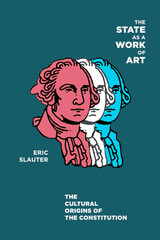 The State as a Work of Art: The Cultural Origins of the Constitution
Eric Slauter
University of Chicago Press, 2009 The founding of the United States after the American Revolution was so deliberate, so inspired, and so monumental in scope that the key actors considered this new government to be a work of art framed from natural rights. Recognizing the artificial nature of the state, these early politicians believed the culture of a people should inform the development of their governing rules and bodies. Eric Slauter explores these central ideas in this extensive and novel account of the origins and meanings of the Constitution of the United States. Slauter uncovers the hidden cultural histories upon which the document rests, highlights the voices of ordinary people, and considers how the artifice of the state was challenged in its effort to sustain inalienable natural rights alongside slavery and to achieve political secularization at a moment of growing religious expression. A complement to classic studies of the Constitution’s economic, ideological, and political origins, The State as a Work of Art sheds new light on the origins of the Constitution and on ongoing debates over its interpretation.
The State as Investment Market: Kyrgyzstan in Comparative Perspective
Johan Engvall
University of Pittsburgh Press, 2016 Based on the case of Kyrgyzstan, while going well beyond it to elaborate a theory of the developing state that comprehends corruption as not merely criminal, but a type of market based on highly rational decisions made by the powerful individuals within, or connected to, the state.
State Blues: The Michigan Review of Prisoner Creative Writing, Volume 13
Prison Creative Arts Project
Michigan Publishing, 2021 The Michigan Review of Prisoner Creative Writing seeks to showcase the talent and diversity from Michigan’s best incarcerated writers. The Review features writing from both beginning and experienced writers - writing that comes from the heart, and that is unique, well-crafted, and lively. It is a publication by the Prison Creative Arts Project, a nationally recognized program committed to bringing those impacted by the justice system and the University of Michigan community into artistic collaboration for mutual learning and growth.
www.prisonarts.org
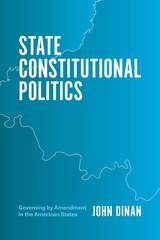 State Constitutional Politics: Governing by Amendment in the American States
John Dinan
University of Chicago Press, 2018 Since the US Constitution came into force in 1789, it has been amended just twenty-seven times, with ten of those amendments coming in the first two years following ratification. By contrast, state constitutions have been completely rewritten on a regular basis, and the current documents have been amended on average 150 times. This is because federal amendments are difficult, so politicians rarely focus on enacting them. Rather, they work to secure favorable congressional statutes or Supreme Court decisions. By contrast, the relative ease of state amendment processes makes them a realistic and regular vehicle for seeking change.
With State Constitutional Politics, John Dinan looks at the various occasions in American history when state constitutional amendments have served as instruments of governance. Among other things, amendments have constrained state officials in the way they levy taxes and spend money; enacted policies unattainable through legislation on issues ranging from minimum wage to the regulation of marijuana; and updated understandings of rights, including religious liberty, equal protection, and the right to bear arms. In addition to comprehensively chronicling the ways amendments shape politics in the states, Dinan also assesses the consequences of undertaking changes in governance through amendments rather than legislation or litigation. For various reasons, including the greater stability and legitimacy of changes achieved through the amendment process, he argues that it might be a more desirable way of achieving change.
State Control of Local Finance in Massachusetts
Royal S. Van de Woestyne
Harvard University Press Massachusetts was a pioneer in developing a scientific and effective system of state control covering nearly all phases of local municipal finance, and this system has served as a model for several other states in formulating programs for dealing with their local financial problems. Accordingly the experience of Massachusetts has particular significance for students of public finance and for public administrators. The present study is designed to meet the needs of both groups.
State Crime: Current Perspectives
Rothe, Dawn
Rutgers University Press, 2010 Current media and political discourse on crime has long ignored crimes committed by States themselves, despite their greater financial and human toll. For the past two decades, scholars have examined how and why States violate their own laws and international law and explored what can be done to reduce or prevent these injustices. Through a collection of essays by leading scholars in the field, State Crime offers a set of cases exemplifying state criminality along with various methods for controlling governmental transgressions. With topics ranging from crimes of aggression to nuclear weapons to the construction and implementation of social controls, this volume is an indispensable resource for those who examine the behavior of States and those who study crime in its varied forms.
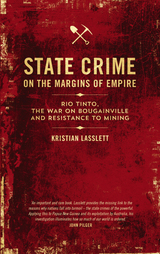 State Crime on the Margins of Empire: Rio Tinto, the War on Bougainville and Resistance to Mining
Kristian Lasslett
Pluto Press, 2014 This book offers a pioneering window into the elusive workings of state-corporate crime within the mining industry. It follows a campaign of resistance organised by indigenous activists on the island of Bougainville, who struggled to close a Rio Tinto owned copper mine, and investigates the subsequent state-corporate response, which led to the shocking loss of some 10,000 lives.
Drawing on internal records and interviews with senior officials, Kristian Lasslett examines how an articulation of capitalist growth mediated through patrimonial politics, imperial state-power, large-scale mining, and clan-based, rural society, prompted an ostensibly ‘responsible’ corporate citizen, and liberal state actors, to organise a counterinsurgency campaign punctuated with gross human rights abuses.
State Crime on the Margins of Empire represents a unique intervention rooted in a classical Marxist tradition that challenges positivist streams of criminological scholarship, in order to illuminate with greater detail the historical forces faced by communities in the global south caught in the increasingly violent dynamics of the extractive industries.
 The State Drug: Theriac, Pharmacy, and Politics in Early Modern Italy
Barbara Di Gennaro Splendore
Harvard University Press, 2025 A revelatory account of the “wonder drug” theriac, which became a powerful tool in the hands of medical and political authorities at the height of the Italian Renaissance.
From the 1490s, one of the most influential remedies to circulate in Europe was the “wonder drug” theriac. Although it had been in use for centuries, theriac gained special importance in the Renaissance, when Italy became a major hub of its production and export. A quintessential example of Galenic pharmacy, theriac was used to treat everything from venomous bites and poisons to headaches, sore throats, fevers, palsy, and heart problems. Examining this pivotal period in the history of medicine, Barbara Di Gennaro Splendore shows how a panacea became a vehicle for political power as well as intellectual and commercial competition.
So essential was theriac to good health that regimes in Bologna and Venice could secure popular support by asserting regulatory control over this “state drug.” Likewise, medical authorities relied on theriac to solidify their own legitimacy, through public ceremonies replete with music and choreography. Apothecaries and physicians engaged in spirited rivalry over branding and control of production, as well as disputes over optimal recipes, which included opium and viper flesh as well as dozens of other ingredients. Yet as Galenic science came into question in the late seventeenth century, the alliance between politics and pharmacy weakened. Physicians, in particular, grew hesitant over whether to continue promoting theriac at all. While the drug remained beloved, especially among the poor, its political power was significantly diminished by the nineteenth century.
Offering a vivid window into the political history of medicine, The State Drug sheds new light on the fraught, age-old intersection of power and pharmacy.
State Employment Policy in Hard Times
Michael Barker, ed.
Duke University Press, 1983 Two hundred years ago, Samuel Johnson observed that a society's level of civilization could be gauged by the manner in which it treated its poor. By that measure, the United States today is steadily losing ground. Whereas the number of officially defined poor dwindled steadily from the enactment of the Great Society programs in the mid-1960s, reaching a low of 24.5 million people in 1978, it has since risen to more than 32 million people. Although the economy continues to generate large numbers of new jobs, the basic unemployment rate continues to rise and current projections show little likelihood of unemployment rates consistently below 10 percent until some time after 1984, if then. In the years to come, the creation of an equitable and workable employment policy will be a major agenda item for politicians and policy makers at the state level, as well as for national leaders.
The State, Ethnicity, and Gender in Africa: Intellectual Legacies of Crawford Young
Edited by Scott Straus and Aili Mari Tripp
University of Wisconsin Press, 2024 Postcolonialism, the politics of ethnic and religious identity, and the role of women in African society and politics have become important, and often connected, foci in African studies. Here, fifteen chapters explore these themes in tandem. With essays that span the continent, this volume showcases the political histories, challenges, and promise of contemporary Africa.
Written in honor of Crawford Young, a foundational figure in the study of African politics, the essays reflect the breadth and intellectual legacy of this towering scholar and illustrate the vast impact Young had, and continues to have, on the field. The book’s themes build from his seminal publications, and the essays were written by leading scholars who were trained by Young.
 State Fair
Phil Stong
University of Iowa Press, 1996 First published in the spring of 1932, Phil Strong's whimsical and wise State Fair was an immediate success. Hollywood released a film that fall starring Will Rogers as Abel Frake and a champion hog from an Iowa farm as the famous Blue Boy, “the finest Hampshire stud boar in the world.” In 1945 Rodgers and Hammerstein's musical motion picture launched such memorable songs as “It Might as Well Be Spring.” In 1962 a movie musical with Pat Boone and Ann-Margret was set at the Texas State Fair. And in 1995 a highly entertaining adaptation of the 1945 musical premiered at the Iowa State Fair before moving on to Broadway. This paperback edition of State Fair, with a new foreword by Robert McCown, reprints the original novel in all it exuberance and freshness. On the surface State Fair simply recounts the adventures of the close-knit Frake family at the Iowa State Fair in the late 1920s, but Strong's universal morality tale has much to reveal to anyone willing to read between the lines. The book shocked some readers in 1932, but most were captivated by the Frakes' good-natured integrity and applauded their spirit. Readers today will find the same joy, liveliness, and insight in this new edition ofState Fair.
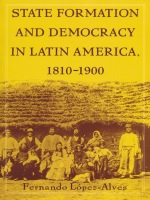 State Formation and Democracy in Latin America, 1810-1900
Fernando López-Alves
Duke University Press, 2000 Despite a shared colonial past, South American nations experienced different patterns of conflict in the nineteenth century. These differences led to the creation of a variety of states and regimes, from authoritarian military oligarchies to popular democracies. Using a rigorous logic of comparison, Fernando López-Alves explores the roots of state building in five countries and explains why the political systems of these early postindependent societies were prone to militarism, corporatism, or liberal democracy.
Breaking with the traditional economic analysis of South American development, López-Alves argues that civil-military relations lay at the core of state building. By comparing three countries in particular—Uruguay, Colombia, and Argentina—during an intense phase of state and regime formation, he shows how war and the collective action of the rural poor contributed to the construction of central armies, the rise of new social classes, and the emergence of civilian organizations. He also examines characteristics unique to each country’s war-formed culture and discusses how coalitions were built during this period. Examples from Paraguay and Venezuela and references to state formation in Europe, the United States, Asia, and the Middle East add to the complexity and richness of the study’s comparative analysis.
Drawing on a vast bibliography of both primary and secondary sources, López-Alves goes beyond providing insights into the particular development of Latin American countries and introduces a comprehensive theory of state formation applicable to other regions. This book will interest Latin Americanists, historians, political scientists, and sociologists studying state formation.
 State Formation: Anthropological Perspectives
Edited by Christian Krohn-Hansen and Knut G. Nustad
Pluto Press, 2005 What is the 'state' and how can we best study it? This book investigates new ways of analysing the state.
The contributors argue that the state is not a fixed and definite object. Our perceptions of it are constantly changing, and differ from person to person. What is your idea of the state if you are a refugee? Or if you are living in post-aparteid South Africa? Our perceptions are formed and sustained by evolving discourses and techniques---these come from institutions such as government, but are also made by communities and individuals.
The contributors examine how state structures are viewed from the inside, by official state bodies, composed of bureaucrats and politicians; and how these state manifestations are supported, reproduced or transformed at a local level. An outline of theoretical approaches is followed by nine case studies ranging from South Africa to Peru to Norway.
With a good range of contributors including Cris Shore, Clifton Crais, Ana Alonso and Bruce Kapferer, this is a comprehensive critical analysis of anthropological approaches to the study of state formation.
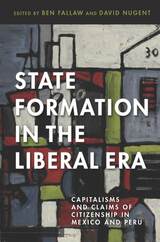 State Formation in the Liberal Era: Capitalisms and Claims of Citizenship in Mexico and Peru
Edited by Ben Fallaw and David Nugent
University of Arizona Press, 2020 State Formation in the Liberal Era offers a nuanced exploration of the uneven nature of nation making and economic development in Peru and Mexico. Zeroing in on the period from 1850 to 1950, the book compares and contrasts the radically different paths of development pursued by these two countries.
Mexico and Peru are widely regarded as two great centers of Latin American civilization. In State Formation in the Liberal Era, a diverse group of historians and anthropologists from the United States, the United Kingdom, and Latin America compare how the two countries advanced claims of statehood from the dawning of the age of global liberal capitalism to the onset of the Cold War. Chapters cover themes ranging from foreign banks to road building and labor relations. The introductions serve as an original interpretation of Peru’s and Mexico’s modern histories from a comparative perspective.
Focusing on the tensions between disparate circuits of capital, claims of statehood, and the contested nature of citizenship, the volume spans disciplinary and geographic boundaries. It reveals how the presence (or absence) of U.S. influence shaped Latin American history and also challenges notions of Mexico’s revolutionary exceptionality. The book offers a new template for ethnographically informed comparative history of nation building in Latin America.
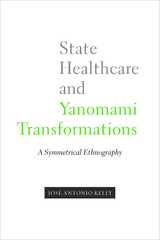 State Healthcare and Yanomami Transformations: A Symmetrical Ethnography
José Antonio Kelly
University of Arizona Press, 2011 Amazonian indigenous peoples have preserved many aspects of their culture and cosmology while also developing complex relationships with dominant non-indigenous society. Until now, anthropological writing on Amazonian peoples has been divided between “traditional” topics like kinship, cosmology, ritual, and myth, on the one hand, and the analysis of their struggles with the nation-state on the other. What has been lacking is work that bridges these two approaches and takes into consideration the meaning of relationships with the state from an indigenous perspective.
That long-standing dichotomy is challenged in this new ethnography by anthropologist José Kelly. Kelly places the study of culture and cosmology squarely within the context of the modern nation-state and its institutions. He explores Indian-white relations as seen through the operation of a state-run health system among the indigenous Yanomami of southern Venezuela.
With theoretical foundations in the fields of medical and Amazonian anthropology, Kelly sheds light on how Amerindian cosmology shapes concepts of the state at the community level. The result is a symmetrical anthropology that treats white and Amerindian perceptions of each other within a single theoretical framework, thus expanding our understanding of each group and its influences on the other. This book will be valuable to those studying Amazonian peoples, medical anthropology, development studies, and Latin America. Its new takes on theory and methodology make it ideal for classroom use.
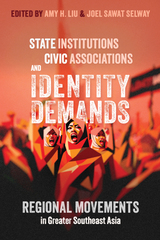 State Institutions, Civic Associations, and Identity Demands: Regional Movements in Greater Southeast Asia
Amy H. Liu and Joel Sawat Selway, Editors
University of Michigan Press, 2024 While the media tends to pay the most attention to violent secessionist movements or peaceful independence movements, it is just as important to understand why there are regions where political movements for autonomy fail to develop. In neglecting regions without political movements or full-blown independence demands, theories may be partial at best and incorrect at worst.
State Institutions, Civic Associations, and Identity Demands examines over a dozen regions, comparing and contrasting successful cases to abandoned, unsuccessful, or dormant cases. The cases range from successful secession (East Timor, Singapore) and ongoing secessionist movements (Southern Philippines), to internally divided regional movements (Kachin State), low-level regionalist stirrings (Lanna, Taiwan), and local but not regional mobilization of identity (Bali, Minahasan), all the way to failed movements (Bataks, South Maluku) and regions that remain politically inert (East and North Malaysia, Northeast Thailand). While each chapter is written by a country expert, the contributions rely on a range of methods, from comparative historical analysis, to ethnography, field interviews, and data from public opinion surveys. Together, they contribute important new knowledge on little-known cases that nevertheless illuminate the history of regions and ethnic groups in Southeast Asia. Although focused on Southeast Asia, the book identifies the factors that can explain why movements emerge and successfully develop and concludes with a chapter by Henry Hale that illustrates how this can be applied globally.
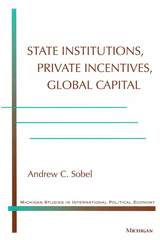 State Institutions, Private Incentives, Global Capital
Andrew C. Sobel
University of Michigan Press, 2002 The growth of global finance since 1960 constitutes one of the most important transformations in social relations during the twentieth century. Using historical, statistical, and graphical techniques, State Institutions, Private Incentives, and Global Capital examines three important aspects of this phenomenal shift in the international political economy. First, Andrew Sobel explores the reawakening of the international financial markets, mapping their extraordinary transformation since the early 1960s and discussing the role of politics in that metamorphosis. The author then offers a fresh understanding of the systematic differences in access for borrowers in this rapidly transforming and expanding global capital pool. He then demonstrates the influence of political factors in producing differential access to the global capital pool. Showing how the character and stability of a country's political system affects investors's decisions to invest in that country, Sobel breaks new ground in understanding the basis for the frequent admonitions by the World Bank and others that a stable political and legal system are essential for states to attract significant foreign investment.
With the growing debate about the effect of financial interdependence on the ability of states to conduct economic policy and indeed to preserve their independence in the face of unprecedented economic linkages, this book will be of interest to political scientists and economists as well as policy makers concerned with the impact of financial globalization and the causes of differentials in access to capital.
Andrew C. Sobel is Assistant Professor of Political Science and Resident Fellow, Center in Political Economy, Washington University, St. Louis. He is the author of Domestic Choices, International Markets: Dismantling National Barriers and Liberalizing Securities Markets.
State, Labor, Capital: Democratizing Class Relations in the Southern Cone
Paul G. Buchanan
University of Pittsburgh Press, 1995 Organized labor has played a critical role in political transition away from authoritarianism in Argentina, Brazil, and Uruguay. Buchanan views the institutional networks where these new governments strive to maintain democracy, focusing on the role of national labor administrations.
This book argues that because democratic capitalist regimes are founded on a state-mediated class compromise, institutionalizing labor relations is a major concern. Institutions that foster equitable labor-management bargaining are at the foundation of workers' acquiescence to bourgeois rule.
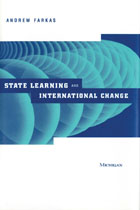 State Learning and International Change
Andrew Farkas
University of Michigan Press, 1998 Explaining change in the behavior of states and other international actors is at the core of the study of international relations. The proficiency with which states respond to changes in the international environment has important consequences for world peace and the world economy as well as domestic politics and well being. One way to understand changes in behavior is to consider whether and how states learn. Key to understanding this is considering how the groups responsible for making decisions learn and make decisions.
Andrew Farkas presents an evolutionary theory of how states adjust their foreign policies in response to international changes. Employing both formal models and computer simulations, Farkas explores the relative efficacy of a wide range of alternative strategies for dealing with unanticipated changes in the international environment, and goes a long way toward reconciling the success of rational choice modeling with criticism from psychological studies of decision making.
Farkas looks at the way small groups charged with making policy decisions work. He explicitly models the process of search and policy selection. He demonstrates how a group of disparate individuals can act as if it were a unitary rational actor and provides the first endogenous account of when and why groups curtail their search for satisfactory policies. Farkas uses the general model to explore the effects of different institutional designs on the decisionmaking process.
This book will be of interest to scholars of international relations, learning models and group processes.
Andrew Farkas is Assistant Professor of Political Science, Rutgers University.
 The State Library and Archives of Texas: A History, 1835-1962
By David B. Gracy II
University of Texas Press, 2010 The Texas State Library and Archives Commission celebrated its centennial in 2009. To honor that milestone, former State Archivist David Gracy has taken a retrospective look at the agency's colorful and sometimes contentious history as Texas's official information provider and record keeper. In this book, he chronicles more than a century of efforts by dedicated librarians and archivists to deliver the essential, nonpartisan library and archival functions of government within a political environment in which legislators and governors usually agreed that libraries and archives were good and needed—but they disagreed about whatever expenditure was being proposed at the moment. Gracy recounts the stories of persevering, sometimes controversial state librarians and archivists, and commission members, including Ernest Winkler, Elizabeth West (the first female agency head in Texas government), Fannie Wilcox, Virginia Gambrell, and Louis Kemp, who worked to provide Texans the vital services of the state library and archives—developing public library service statewide, maintaining state and federal records for use by the public and lawmakers, running summer reading programs for children, providing services for the visually impaired, and preserving the historically significant records of Texas as a colony, province, republic, and state. Gracy explains how the agency has struggled to balance its differing library and archival functions and, most of all, to be treated as a full-range information provider, and not just as a collection of disparate services.
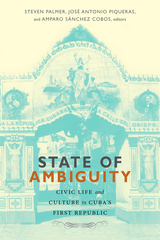 State of Ambiguity: Civic Life and Culture in Cuba's First Republic
Steven Palmer, José Antonio Piqueras, Amparo Sánchez Cobos, eds.
Duke University Press, 2014 Cuba's first republican era (1902–1959) is principally understood in terms of its failures and discontinuities, typically depicted as an illegitimate period in the nation's history, its first three decades and the overthrow of Machado at best a prologue to the "real" revolution of 1959. State of Ambiguity brings together scholars from North America, Cuba, and Spain to challenge this narrative, presenting republican Cuba instead as a time of meaningful engagement—socially, politically, and symbolically. Addressing a wide range of topics—civic clubs and folkloric societies, science, public health and agrarian policies, popular culture, national memory, and the intersection of race and labor—the contributors explore how a broad spectrum of Cubans embraced a political and civic culture of national self-realization. Together, the essays in State of Ambiguity recast the first republic as a time of deep continuity in processes of liberal state- and nation-building that were periodically disrupted—but also reinvigorated—by foreign intervention and profound uncertainty. Contributors. Imilcy Balboa Navarro, Alejandra Bronfman, Maikel Fariñas Borrego, Reinaldo Funes Monzote, Marial Iglesias Utset, Steven Palmer, José Antonio Piqueras Arenas, Ricardo Quiza Moreno, Amparo Sánchez Cobos, Rebecca J. Scott, Robert Whitney
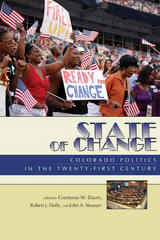 State of Change: Colorado Politics in the Twenty-first Century
Courtenay W. Daum
University Press of Colorado, 2011 Colorado has recently been at the center of major shifts in American politics. Indeed, over the last several decades the political landscape has altered dramatically on both the state and national levels. State of Change traces the political and demographic factors that have transformed Colorado, looking beyond the major shift in the dominant political party from Republican to Democratic to greater long-term implications. The increased use of direct democracy has resulted in the adoption of term limits, major reconstruction of fiscal policy, and many other changes in both statutory and constitutional law. Individual chapters address these changes within a range of contexts--electoral, political, partisan, and institutional--as well as their ramifications. Contributors also address the possible impacts of these changes on the state in the future, concluding that the current state of affairs is fated to be short-lived. State of Change is the most up-to-date book on Colorado politics available and will be of value to undergraduate- and graduate-level students, academics, historians, and anyone involved with or interested in Colorado politics.
 The State of Democracy in America
William J. Crotty, Editor
Georgetown University Press, 2001 In this wide-ranging assessment of democracy in America today, fifteen respected scholars of American politics chart the strengths and weaknesses of the nation’s democratic mechanisms and outline the challenges that lie ahead. They focus not on specific policies or elections but on the quality of American political life, the representativeness of its governing institutions, and the issues of racial and economic equity. The contributors cover a broad spectrum of the American political process. Topics include the extent and nature of political participation, the relevance of political parties, political fundraising and its policy consequences, demographic change and its likely effect on the national political agenda, and the future of racial politics. Others explore how representative Congress really is today, how the market economy affects public policy, the use of impeachment as a political weapon, and the degree of corporate influence on the political process. A final chapter explores the circumstances likely to shape policy agendas over the course of the twenty-first century. Taken together, these essays provide a clear picture of political evolution during the past fifty years and discuss possible problems and issues of the future. Written for advanced undergraduate and graduate students, the book is a thoughtful, well-documented, critical analysis of contemporary American democracy.
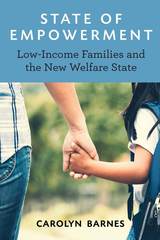 State of Empowerment: Low-Income Families and the New Welfare State
Carolyn Barnes
University of Michigan Press, 2020 On weekday afternoons, dismissal bells signal not just the end of the school day but also the beginning of another important activity: the federally funded after-school programs that offer tutoring, homework help, and basic supervision to millions of American children. Nearly one in four low-income families enroll a child in an after-school program. Beyond sharpening students’ math and reading skills, these programs also have a profound impact on parents. In a surprising turn—especially given the long history of social policies that leave recipients feeling policed, distrusted, and alienated—government-funded after-school programs have quietly become powerful forces for political and civic engagement by shifting power away from bureaucrats and putting it back into the hands of parents. In State of Empowerment Carolyn Barnes uses ethnographic accounts of three organizations to reveal how interacting with government-funded after-school programs can enhance the civic and political lives of low-income citizens.
The State of Europe: Transformation of Statehood from a European Perspective
Edited by Sonja Puntscher Riekmann, Monika Mokre, and Michael Latzer
Campus Verlag, 2004 While globalization affects the sovereignty of every nation-state, European countries face special challenges due to the emergence of the European Union. The State of Europe explores the transformation of ideas of statehood in light of the EU’s continued development, including rapidly changing notions of democracy, representation, and citizenship alongside major shifts in economic regulation. This book will be an essential guide for students and teachers of economics, political science, and international relations, as well as anyone interested in the expanding role of the EU worldwide.
 State of Exception
Giorgio Agamben
University of Chicago Press, 2004 Two months after the attacks of 9/11, the Bush administration, in the midst of what it perceived to be a state of emergency, authorized the indefinite detention of noncitizens suspected of terrorist activities and their subsequent trials by a military commission. Here, distinguished Italian philosopher Giorgio Agamben uses such circumstances to argue that this unusual extension of power, or "state of exception," has historically been an underexamined and powerful strategy that has the potential to transform democracies into totalitarian states.
The sequel to Agamben's Homo Sacer: Sovereign Power and Bare Life, State of Exception is the first book to theorize the state of exception in historical and philosophical context. In Agamben's view, the majority of legal scholars and policymakers in Europe as well as the United States have wrongly rejected the necessity of such a theory, claiming instead that the state of exception is a pragmatic question. Agamben argues here that the state of exception, which was meant to be a provisional measure, became in the course of the twentieth century a normal paradigm of government. Writing nothing less than the history of the state of exception in its various national contexts throughout Western Europe and the United States, Agamben uses the work of Carl Schmitt as a foil for his reflections as well as that of Derrida, Benjamin, and Arendt.
In this highly topical book, Agamben ultimately arrives at original ideas about the future of democracy and casts a new light on the hidden relationship that ties law to violence.
 State of Fear: Policing a Postcolonial City
Joshua Barker
Duke University Press, 2024 In State of Fear, Joshua Barker reckons with how fear and violence are produced and reproduced through everyday practices of rule and control. Examining the ethnographic and historical genealogies of Indonesian policing, Barker focuses on the city of Bandung, which is permeated by anxieties about security, in spite of the fact that it’s a relatively safe city according to the data. Drawing from his fieldwork there during the latter years of the authoritarian New Order regime, Barker traces the complex relationship between the state and vigilante groups like neighborhood watch patrols and street gangs. Through interviews with police officers, vigilantes, and street-level toughs, he uncovers a struggle between two visions of social control that continues to animate policing in Indonesia: the modern, bureaucratic approach favored by the state, and a territorial approach that divides the city into fiefdoms overseen by charismatic individuals of authority. Synthesizing insights from in-depth ethnographic, historical, and theoretical work, Barker reveals how authoritarianism can take root not just from the top down but also from the bottom up.
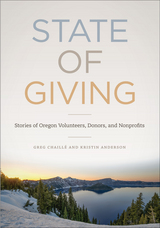 State of Giving: Stories of Oregon Nonprofits, Donors, and Volunteers
Greg Chaillé
Oregon State University Press, 2015 State of Giving is at once an authoritative overview of Oregon’s toughest challenges and a
much-needed manifesto for greater civic engagement. Chaillé and Anderson highlight the crucial
role that nonprofits play as pillars of Oregon’s civic structure through their engaging profiles of
the charismatic civic leaders, grassroots organizations, donors, and volunteers who are working
to combat some of Oregon’s most enduring problems, including:
• Education Inequity
• Environmental Conservation
• Social Inequity and Discrimination
• Hunger and Homelessness
• The Urban/Rural Divide
• Arts, Culture, and Heritage Funding
Traversing the state from a remote Great Basin field station to an intercultural center in north
Portland, State of Giving shows the many faces of public engagement in people like education
activist Ron Herndon, volunteer historians Gwen Carr and Willie Richardson, and Wallowa
County philanthropist and rancher Doug McDaniel. Their stories reveal that there are ways
in which we all—regardless of wealth, location, age, or background—can give back to our
communities.
In addition to introducing Oregon’s key areas of need and demonstrating diverse pathways
into civic engagement, the book provides extensive resources for prospective volunteers and
donors. Rousing, accessible, and enlivened by photographs of its people and places, State of Giving
is an essential reference for anyone interested in building a better Oregon, starting today.
 A State of Health: New Jersey's Medical Heritage
Reeds, Karen
Rutgers University Press, 2002 Did you know that New Jersey spearheaded the discovery of antibiotics? Or that the Garden State had the first state hospital serving the mentally ill and the first community rescue squad? And did you know that close to a million people around the world can walk again, thanks to the New Jersey Knee?
New Jersey is a small state that has played a big role in the history of medicine. Adrenalin, streptomycin, pure milk, tranquilizers, malaria control, cortisone, vitamins, revelations of radium's dangers—New Jersey’s impressive contributions to American health have been on display in a major traveling exhibition, “A State of Health: New Jersey’s Medical Heritage.” By 2002, more than twelve sites throughout New Jersey and Philadelphia will have hosted this display.
This catalogue to the exhibition celebrates more than four centuries of New Jersey medicine through original essays and 150-plus striking illustrations of artifacts, manuscripts, books, photographs, works of art, and postcards. Taking subjects of perennial interest—epidemics, children’s health, public health, hospitals, and biomedical research—curator Karen Reeds explores the state’s rich medical heritage and its uniqueplace as the heart of the world’s pharmaceutical industry.
Engagingly written and handsomely produced, A State of Health: New Jersey’s
Medical Heritage is at once a lasting resource for students, teachers, and historians and the perfect gift to your favorite healthcare professional or local history buff.
The State of Housing Design 2023
Joint Center for Housing Studies
Harvard University Press The State of Housing Design 2023 is the first report in a new series that reviews national trends, ideas, and critical issues as they relate to residential design. This volume examines recently built housing projects of notable design that address issues of affordability, social cohesion, sustainability, aesthetics, density, and urbanism. Through critical essays, visual content, and a crowdsourced survey of responses, it provides both designers and the general public with an overview of the forces at play in contemporary design of housing.
The State of Housing Design series is published by the Joint Center for Housing Studies, a research center affiliated with the Graduate School of Design at Harvard University, that has produced analyses of housing markets and policy for over sixty years.
The State of Islam: Culture and Cold War Politics in Pakistan
Saadia Toor
Pluto Press, 2011 The State of Islam tells the story of Pakistan through the lens of the Cold War, and more recently the War on Terror, to shed light on the domestic and international processes behind the global rise of militant Islam.
Unlike existing scholarship on nationalism, Islam and the state in Pakistan, which tends to privilege events in a narrowly-defined ‘political’ realm, Saadia Toor highlights the significance of cultural politics in Pakistan from its origins to the contemporary period. This extra dimension allows Toor to explain how the struggle between Marxists and liberal nationalists was influenced and eventually engulfed by the agenda of the religious right.
Timely and unique, this book is a must for anyone who wants to understand the roots of modern Pakistan and the likely outcome of current power struggles in the country.
State of Israel, Diaspora, and Jewish Continuity: Essays on the “Ever-Dying People”
Simon Rawidowicz
Brandeis University Press, 1998 This readable, insightful, and thought-provoking collection of essays, presents an original and innovative ideology that stirringly affirms the unity of the Jewish people. Rawidowicz's rich themes include the relationship between the State of Israel and the Diaspora; Jewish "difference" and its repercussions; Jewish learning; and Jewish continuity in the post-Holocaust world. In his foreword to the paper edition, Michael A. Meyer writes, "Forty years after his death, [Rawidowicz's] sober analyses, his realism with regard to both the State of Israel and the Diaspora, and his striving to find unities among dichotomies that divide the Jewish people -- all of these make his images and ideas still worthy of our reflection."
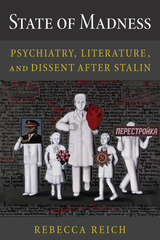 State of Madness: Psychiatry, Literature, and Dissent After Stalin
Rebecca Reich
Northern Illinois University Press, 2018 What madness meant was a fiercely contested question in Soviet society. State of Madness examines the politically fraught collision between psychiatric and literary discourses in the years after Joseph Stalin’s death. State psychiatrists deployed set narratives of mental illness to pathologize dissenting politics and art. Dissidents such as Aleksandr Vol’pin, Vladimir Bukovskii, and Semen Gluzman responded by highlighting a pernicious overlap between those narratives and their life stories. The state, they suggested in their own psychiatrically themed texts, had crafted an idealized view of reality that itself resembled a pathological work of art. In their unsanctioned poetry and prose, the writers Joseph Brodsky, Andrei Siniavskii, and Venedikt Erofeev similarly engaged with psychiatric discourse to probe where creativity ended and insanity began. Together, these dissenters cast themselves as psychiatrists to a sick society.
By challenging psychiatry’s right to declare them or what they wrote insane, dissenters exposed as a self-serving fiction the state’s renewed claims to rationality and modernity in the post-Stalin years. They were, as they observed, like the child who breaks the spell of collective delusion in Hans Christian Andersen’s story “The Emperor’s New Clothes.” In a society where normality means insisting that the naked monarch is clothed, it is the truth-teller who is pathologized. Situating literature’s encounter with psychiatry at the center of a wider struggle over authority and power, this bold interdisciplinary study will appeal to literary specialists; historians of culture, science, and medicine; and scholars and students of the Soviet Union and its legacy for Russia today.
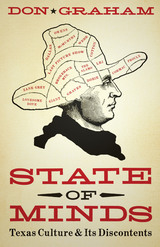 State of Minds: Texas Culture and Its Discontents
By Don Graham
University of Texas Press, 2011 John Steinbeck once famously wrote that “Texas is a state of mind.” For those who know it well, however, the Lone Star State is more than one mind-set, more than a collection of clichés, more than a static stereotype. There are minds in Texas, Don Graham asserts, and some of the most important are the writers and filmmakers whose words and images have helped define the state to the nation, the world, and the people of Texas themselves. For many years, Graham has been critiquing Texas writers and films in the pages of Texas Monthly and other publications. In State of Minds, he brings together and updates essays he published between 1999 and 2009 to paint a unique, critical picture of Texas culture. In a strong personal voice—wry, humorous, and ironic—Graham offers his take on Texas literary giants ranging from J. Frank Dobie to Larry McMurtry and Cormac McCarthy and on films such as The Alamo, The Last Picture Show, and Brokeback Mountain. He locates the works he discusses in relation to time and place, showing how they sprang (or not) from the soil of Texas and thereby helped to define Texas culture for generations of readers and viewers—including his own younger self growing up on a farm in Collin County. Never shying from controversy and never dull, Graham’s essays in State of Minds demolish the notion that “Texas culture” is an oxymoron.
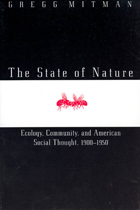 The State of Nature: Ecology, Community, and American Social Thought, 1900-1950
Gregg Mitman
University of Chicago Press, 1992 Although science may claim to be "objective," scientists cannot avoid the influence of their own values on their research. In The State of Nature, Gregg Mitman examines the relationship between issues in early twentieth-century American society and the sciences of evolution and ecology to reveal how explicit social and political concerns influenced the scientific agenda of biologists at the University of Chicago and throughout the United States during the first half of this century.
Reacting against the view of nature "red in tooth and claw," ecologists and behavioral biologists such as Warder Clyde Allee, Alfred Emerson, and their colleagues developed research programs they hoped would validate and promote an image of human society as essentially cooperative rather than competitive. Mitman argues that Allee's religious training and pacifist convictions shaped his pioneering studies of animal communities in a way that could be generalized to denounce the view that war is in our genes.
 State of Segregation: America’s Freedom Rights Struggles as Told by Alabama
Mark J. Tenhundfeld
University of Alabama Press, 2026 A revealing legal journey through Alabama’s civil rights battles, exposing systemic discrimination and the enduring fight for justice via landmark Supreme Court cases State of Segregation: America’s Freedom Rights Struggles, as Told by Alabama by Mark J. Tenhundfeld offers a compelling exploration of Alabama’s civil rights and civil liberties history through the lens of thirty-two pivotal US Supreme Court cases. Each case, rooted in Alabama’s social and legal conflicts, reveals the persistent struggle to fulfill the Constitution’s promises of equal protection and due process. From early twentieth-century challenges to the Alabama Constitution of 1901 to contemporary battles over gerrymandering, Tenhundfeld traces how discrimination was embedded in the state’s institutions—and how it was contested. State of Segregation uniquely blends legal analysis, historical narrative, and social commentary to expose the deep-rooted systems of racial, gender, and class-based discrimination in Alabama. Tenhundfeld argues that while discrimination is the most defining feature of Alabama’s past, it remains the most difficult to confront. By illuminating the legal strategies used to uphold and dismantle injustice, State of Segregation contributes to the broader understanding of how historical inequities continue to shape modern society. Accessible to general readers and scholars alike, this work stands apart by combining Alabama history, civil rights struggles, and Supreme Court jurisprudence into a single, powerful narrative. It offers both cautionary tales about the fragility of freedom and enduring lessons for today’s social justice advocates.
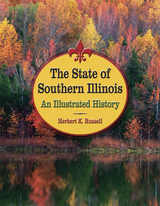 The State of Southern Illinois: An Illustrated History
Herbert K. Russell
Southern Illinois University Press, 2012 In The State of Southern Illinois: An Illustrated History, Herbert K. Russell offers fresh interpretations of a number of important aspects of Southern Illinois history. Focusing on the area known as “Egypt,” the region south of U.S. Route 50 from Salem south to Cairo, he begins his book with the earliest geologic formations and follows Southern Illinois’s history into the twenty-first century. The volume is richly illustrated with maps and photographs, mostly in color, that highlight the informative and straightforward text. Perhaps most notable is the author’s use of dozens of heretofore neglected sources to dispel the myth that Southern Illinois is merely an extension of Dixie. He corrects the popular impressions that slavery was introduced by early settlers from the South and that a majority of Southern Illinoisans wished to secede. Furthermore, he presents the first in-depth discussion of twelve pre–Civil War, free black communities located in the region. He also identifies the roles coal mining, labor violence, gangsters, and the media played in establishing the area’s image. He concludes optimistically, unveiling a twenty-first-century Southern Illinois filled with myriad attractions and opportunities for citizens and tourists alike. The State of Southern Illinois is the most accurate all-encompassing volume of history on this unique area that often regards itself as a state within a state. It offers an entirely new perspective on race relations, provides insightful information on the cultural divide between north and south in Illinois, and pays tribute to an often neglected and misunderstood region of this multidimensional state, all against a stunning visual backdrop.
Superior Achievement from the Illinois State Historical Society, 2013
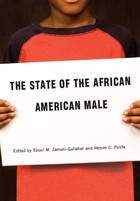 The State of the African American Male
Eboni M. Zamani-Gallaher
Michigan State University Press, 2010 The circumstances affecting many African American males in schools and society remain complex and problematic. In spite of modest gains in school achievement and graduation rates, conditions that impede the progress of African American males persist: high rates of school violence and suspensions, overrepresentation in special education classes, poor access to higher education, high incidence of crime and incarceration, gender and masculine identity issues, and HIV/AIDS and other health crises.
The essays gathered here focus on these issues as they exist for males in grades K-12 and postsecondary education in Michigan. However, the authors intend their analyses and policy recommendations to apply to African American males nationally.
Although it recognizes the current difficulties of this population overall, this is an optimistic volume, with a goal of creating policies and norms that help African American males achieve their educational and social potential. In this era of widespread change for all members of American society-regardless of race-this book is a must-read for educators and policymakers alike.
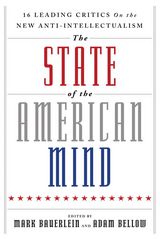 The State of the American Mind: 16 Leading Critics on the New Anti-Intellectualism
Mark Bauerlein
Templeton Press, 2015 In 1987, Allan Bloom’s The Closing of the American Mind was published; a wildly popular book that drew attention to the shift in American culture away from the tenants that made America—and Americans—unique. Bloom focused on a breakdown in the American curriculum, but many sensed that the issue affected more than education. The very essence of what it meant to be an American was disappearing.
That was over twenty years ago. Since then, the United States has experienced unprecedented wealth, more youth enrolling in higher education than ever before, and technology advancements far beyond what many in the 1980s dreamed possible. And yet, the state of the American mind seems to have deteriorated further. Benjamin Franklin’s “self-made man” has become a man dependent on the state. Independence has turned into self-absorption. Liberty has been curtailed in the defense of multiculturalism.
In order to fully grasp the underpinnings of this shift away from the self-reliant, well-informed American, editors Mark Bauerlein and Adam Bellow have brought together a group of cultural and educational experts to discuss the root causes of the decline of the American mind. The writers of these fifteen original essays include E. D. Hirsch, Nicholas Eberstadt, and Dennis Prager, as well as Daniel Dreisbach, Gerald Graff, Richard Arum, Robert Whitaker, David T. Z. Mindich, Maggie Jackson, Jean Twenge, Jonathan Kay, Ilya Somin, Steve Wasserman, Greg Lukianoff, and R. R. Reno. Their essays are compiled into three main categories:
- States of Mind: Indicators of Intellectual and Cognitive Decline
- These essays broach specific mental deficiencies among the population, including lagging cultural IQ, low Biblical literacy, poor writing skills, and over-medication.
- Personal and Cognitive Habits/Interests
- These essays turn to specific mental behaviors and interests, including avoidance of the news, short attention spans, narcissism, and conspiracy obsessions.
- National Consequences
- These essays examine broader trends affecting populations and institutions, including rates of entitlement claims, voting habits, and a low-performing higher education system.
The State of the American Mind is both an assessment of our current state as well as a warning, foretelling what we may yet become. For anyone interested in the intellectual fate of America, The State of the American Mind offers an accessible and critical look at life in America and how our collective mind is faring.
The State of the Art: A Chronicle of American Poetry, 1988-2014
David Lehman
University of Pittsburgh Press, 2015 The acclaimed annual, The Best American Poetry, is the most prestigious showcase of new poetry in the United States and Canada. Each year since the series began in 1988, David Lehman has contributed a foreword, and this has evolved into a sort of state-of-the-art address that surveys new developments and explores various matters facing poets and their readers today. This book collects all twenty-nine forewords (including the two written for the retrospective “Best of the Best” volumes for the tenth and twenty-fifth anniversaries.) Beginning with a new introduction by Lehman and a foreword by poet Denise Duhamel (guest editor for The Best American Poetry 2013), the collection conveys a sense of American poetry in the making, year by year, over the course of a quarter of a century.
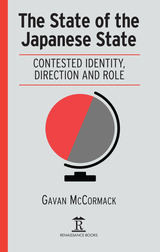 The State of the Japanese State: Contested Identity, Direction and Role
Gavan McCormack
Amsterdam University Press, 2018 In this his latest work, Gavan McCormack argues that Abe Shinzo’s efforts to re-engineer the Japanese state may fail, but his radicalism continues to shake the country and will have consequences not easy now to predict. The significance of this book will be widely recognized, particularly by those researching contemporary world politics, international relations and the history of modern Japan. McCormack here revisits and reassesses his previous formulations of Japan as construction state (doken kokka), client state (zokkoku), constitutional pacifist state, and colonial state (especially in its relationship to Okinawa). He adds a further chapter on what he calls the ‘rampant state’, that outlines the increasingly authoritarian or ikkyo (one strong) turn of the Abe government in the fifth year of its second term. And he critically addresses the Abe agenda for constitutional revision.
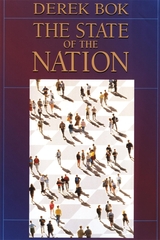 The State of the Nation: Government and the Quest for a Better Society
Derek Bok
Harvard University Press, 1996 Never before have Americans been so anxious about the future of their society. But rarely has anyone offered a clear statement about why, in a nation so prosperous, free, and stable, we tend to assume that the country is in dire straits and that the government can do little to help. This book is just such a statement, an eloquent assessment of where America stands, how our society has changed in the past half-century, and who or what is responsible for our current frustrations.
Derek Bok examines the nation's progress in five areas that Americans generally consider to be of paramount importance: economic prosperity, quality of life, opportunity, personal security, and societal values. He shows that although we are better off today in most areas than we were in 1960, we have performed poorly overall compared with other leading industrial nations. And when it comes to providing adequate health care at a reasonable cost, educating our young people for high-skilled jobs, alleviating poverty and urban blight, and reducing crime, our record has been dismal. Comparing the United States with other leading industrial nations on more than sixty key indicators, Bok shows that we rank below average in more than two-thirds of the cases and at the bottom in more than half.
What has caused this decline, and what can be done about it? In virtually all important areas of American life, Bok concludes, government policies have played a significant, often decisive role in accounting for our successes as well as our failures. But whereas others call for downsizing the federal government, Bok argues that government is essential to achieving America's goals. In short, Ronald Reagan was only half right. Government is the problem. But it is also the most important part of the solution. By assessing the state of the nation and identifying the reasons for its current condition, this book helps set the agenda for improving America's performance in the future.
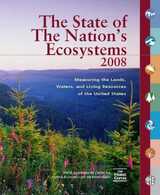 The State of the Nation's Ecosystems 2008: Measuring the Land, Waters, and Living Resources of The United States
The H. John Heinz III Center for Science, Economics, and the Environment, RobinO'Malley, Project Director
Island Press, 2008 Revised and updated periodically, The State of the Nation’s Ecosystems is widely recognized as America’s most comprehensive report on the condition of our lands, waters, and living resources. Like the acclaimed first edition, this second edition provides nonpartisan, scientifically reliable information for policymakers, scientists, journalists, and anyone who is interested in the state of America’s environment.
The State of the Nation’s Ecosystems provides a way to “take the pulse” of America’s environment. It is organized around the nation’s primary ecosystems: farmlands, forests, fresh waters, coasts and oceans, grasslands and shrublands, urban and suburban areas, and the nation as a whole. For each, it identifies what should be measured, counted, and reported so that decision makers and others can understand the changes that are occurring, set priorities for action, and measure whether we are achieving our environmental goals. Conditions are tracked using approximately 100 indicators, agreed upon by hundreds of experts from universities, government agencies, corporations, and environmental organizations. The new report refines the set of indicators and supplies data.
Until its publication, there was no environmental equivalent to the kind of “key economic indicators” that help to gauge the economic health of the nation, like gross domestic product. The State of the Nation’s Ecosystems provides our first set of “key environmental indicators.” It won’t eliminate differences of opinion about environmental policy, but it will provide a common set of data to inform the debate as well as a common yardstick for measuring the effectiveness of our actions. Most importantly, it will provide much-needed assistance in setting our future agenda.
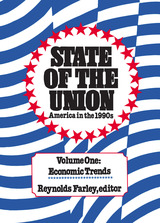 State of the Union: America in the 1990s, Economic Trends
Reynolds Farley
Russell Sage Foundation, 1995 "The Census is a most valuable source of information about our lives; these volumes make the story it has to tell accessible to all who want to know." —Lee Rainwater, Center for Advanced Study in the Behavioral Sciences "A lucid and balanced overview of major trends in the United States and essential reading for policymakers. State of the Union is a reality check that provides the factual basis for policy analysis."—Peter Gottschalk, Boston College State of the Union: America in the 1990s is the definitive new installment to the United States Census Series, carrying forward a tradition of census-based reports on American society that began with the 1930 Census. These two volumes offer a systematic, authoritative, and concise interpretation of what the 1990 Census reveals about the American people today. •Volume One: Economic Trends focuses on the schism between the wealthy and the poor that intensified in the 1980s as wages went up for highly educated persons but fell for those with less than a college degree. This gap was reflected geographically, as industries continued their migration from crumbling inner cities to booming edge cities, often leaving behind an impoverished minority population. Young male workers lost ground in the 1980s, but women made substantial strides, dramatically reducing the gender gap in earnings. The amount of family income devoted to housing rose over the decade, but while housing quality improved for wealthy, older Americans, it declined for younger, poorer families. •Volume Two: Social Trends examines the striking changes in American families and the rapid shifts in our racial and ethnic composition. Americans are marrying much later and divorcing more often, and increasing numbers of unmarried women are giving birth. These shifts have placed a growing proportion of children at risk of poverty. In glaring contrast, the elderly were the only group to make gains in the 1980s, and are now healthier and more prosperous than ever before. The concentrated immigration of Asians and Latinos to a few states and cities created extraordinary pockets of diversity within the population. Throughout the 1990s, the nation will debate questions about the state of the nation and the policies that should be adopted to address changing conditions. Will continued technological change lead to even more economic polarization? Will education become an increasingly important factor in determining earnings potential? Did new immigrants stimulate the economy or take jobs away from American-born workers? Will we be able to support the rapidly growing population of older retirees? State of the Union will help us to answer these questions and better understand how well the nation is adapting to the pervasive social and economic transformations of our era. A Volume in the Russell Sage Foundation Census Series
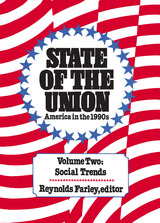 State of the Union: America in the 1990s, Social Trends
Reynolds Farley
Russell Sage Foundation, 1995 "The Census is a most valuable source of information about our lives; these volumes make the story it has to tell accessible to all who want to know." —Lee Rainwater, Center for Advanced Study in the Behavioral Sciences "A lucid and balanced overview of major trends in the United States and essential reading for policymakers. State of the Union is a reality check that provides the factual basis for policy analysis."—Peter Gottschalk, Boston College State of the Union: America in the 1990s is the definitive new installment to the United States Census Series, carrying forward a tradition of census-based reports on American society that began with the 1930 Census. These two volumes offer a systematic, authoritative, and concise interpretation of what the 1990 Census reveals about the American people today. •Volume One: Economic Trends focuses on the schism between the wealthy and the poor that intensified in the 1980s as wages went up for highly educated persons but fell for those with less than a college degree. This gap was reflected geographically, as industries continued their migration from crumbling inner cities to booming edge cities, often leaving behind an impoverished minority population. Young male workers lost ground in the 1980s, but women made substantial strides, dramatically reducing the gender gap in earnings. The amount of family income devoted to housing rose over the decade, but while housing quality improved for wealthy, older Americans, it declined for younger, poorer families. •Volume Two: Social Trends examines the striking changes in American families and the rapid shifts in our racial and ethnic composition. Americans are marrying much later and divorcing more often, and increasing numbers of unmarried women are giving birth. These shifts have placed a growing proportion of children at risk of poverty. In glaring contrast, the elderly were the only group to make gains in the 1980s, and are now healthier and more prosperous than ever before. The concentrated immigration of Asians and Latinos to a few states and cities created extraordinary pockets of diversity within the population. Throughout the 1990s, the nation will debate questions about the state of the nation and the policies that should be adopted to address changing conditions. Will continued technological change lead to even more economic polarization? Will education become an increasingly important factor in determining earnings potential? Did new immigrants stimulate the economy or take jobs away from American-born workers? Will we be able to support the rapidly growing population of older retirees? State of the Union will help us to answer these questions and better understand how well the nation is adapting to the pervasive social and economic transformations of our era. A Volume in the Russell Sage Foundation Census Series
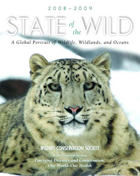 State of the Wild 2008-2009: A Global Portrait of Wildlife, Wildlands, and Oceans
Wildlife Conservation Society
Island Press, 2008 State of the Wild is a biennial series that brings together international conservation experts and writers to discuss emerging issues in the conservation of wildlife and wild places.
Each volume in the series combines evocative writings with a fascinating tour of conservation news highlights and vital statistics from around the world. One-third of each volume focuses on a topic of particular concern to conservationists working to protect wildlife and our last wild places. This 2008–2009 edition considers the integration of wildlife health, ecosystem health, human health, and the health of domestic animals—a “One World–One Health” approach to disease and conservation.
This focus is complemented with essays clustered into sections that address other key issues—conservation of species; conservation of wild places; people, culture, and conservation; and the art and practice of conservation. Essays cover a broad range of topics, from restoring biodiversity on the prairies to mapping the state of the oceans to the conservation impacts of lawlessness and coca cultivation in Colombia. Essay contributions come from people directly involved in on-the-ground conservation efforts and offer a unique and valuable perspective on often-overlooked topics.
State of the Wild’s accessible approach educates a wide range of audiences while at the same time presenting leading-edge scientific overviews of hot topics in conservation. Uniquely structured with magazine-like features up front, conservation news in the middle, and essays from eminent authors and experienced scientists throughout, this landmark series is an essential addition to any environmental bookshelf.
State of the Wild 2010-2011: A Global Portrait
Wildlife Conservation Society
Island Press, 2010 State of the Wild is a biennial series that brings together international conservation experts and writers to discuss emerging issues in the conservation of wildlife and wild places.
In addition to evocative writings and a fascinating tour of conservation news highlights and vital statistics from around the world, this 2010-2011 edition examines how destabilization and war affect wildlife and wild places.
State of the Wild's accessible approach educates a wide range of audiences while at the same time presenting leading-edge scientific overviews of hot topics in conservation. Uniquely structured with magazine-like features up front, conservation news in the middle, and essays from eminent authors and experienced scientists throughout, this landmark series is an essential addition to any environmental bookshelf.
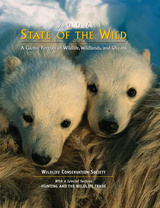 State of the Wild: A Global Portrait of Wildlife, Wildlands, and Oceans
Wildlife Conservation Society
Island Press, 2005 In wild places where nature thrives, humanity prospers; our well-being is inextricably linked with that of the planet's web of life. In fact, one could argue that the state of the world can be measured by the state of the wild. But how do we gauge the state of earth's wildlife, wildlands, and oceans? State of the Wild is a new series that brings together some of the world's most renowned conservationists and writers-George Schaller, Alan Rabinowitz, Sylvia Earle, Rick Bass, Bill McKibben, Tom Lovejoy, and many others-to assess wildlife and wilderness, and to provide insights into how humans can become better stewards of the wild. This new series combines evocative writings with a fascinating tour of news highlights and vital statistics from around the world. One-third of each volume will focus on a topic of particular concern to conservationists working to protect wildlife and our last wild places. This 2006 edition explores the impacts of hunting and the wildlife trade through a range of essays: Ted Kerasote traces the history of hunting in North America; Carl Safina, Eric Gilman, and Wallace J. Nichols quantify the toll taken by commercial fishing on seabirds, turtles, and other marine species; James Compton and Samuel K. H. Lee explore the global reach of the wildlife trade for traditional Asian medicine. Contributors also examine other pivotal conservation issues, from the reasons why one in eight of the world's birds are endangered, to the impacts of global climate change, to the complexity of conserving seals, flamingos, zebras, and other wide-ranging species. The book's closing essay, "The Relative Wild," considers what exactly it means for a place to be "wild," where even the most remote corners of the planet have been altered by human activities. Uniquely structured with magazine-like features up front, conservation news in the middle, and essay contributions from eminent authors and biologists throughout, this landmark series is an essential addition to any environmental bookshelf.
State of the World 1998: Environmental Threats of Economic Growth
The Worldwatch Institute
Island Press, 2015 In this fifteenth edition of State of the World, Lester R. Brown and the Worldwatch research team look at the environmental effects of continuing economic growth as the economy outgrows the earth's ecosystem. As the global economy has expanded from $5 trillion of output in 1950 to $29 trillion in 1997, its demands have crossed many of the earth's sustainable yield thresholds.
State of the World 2000: Building a Sustainable Economy
The Worldwatch Institute
Island Press, 2015 State of the World 2000 shines a sharp light on the great challenge our civilization faces: how to use our political systems to manage the difficult and complex relationships between the global economy and the Earth's ecosystems. If we cannot build an environmentally sustainable global economy, then we have no future that anyone would desire.
State of the World 2001: The Challenge of a Globalizing World
The Worldwatch Institute
Island Press, 2015 From the thinning of the Arctic sea ice to the invasion of the mosquito-borne West Nile virus, State of the World 2001 shows how the economic boom of the last decade has damaged natural systems. The increasingly visible evidence of environmental deterioration is only the tip of a much more dangerous problem: the growing inequities in wealth and income between countries and within countries, inequities that will generate enormous social unrest and pressure for change.
State of the World 2004: Special Focus: The Consumer Society
The Worldwatch Institute
Island Press, 2015 With chapters on food, water, energy, the politics of consumption and redefining the good life, Worldwatch’s award-winning research team asks whether a less-consumptive society is possible—and then argues that it is essential.
State of the World 2005: Redefining Global Security
The Worldwatch Institute
Island Press, 2015 In State of the World 2005, Worldwatch researchers explore underlying sources of global insecurity including poverty, infectious disease, environmental degradation, and rising competition over oil and other resources. Find out why terrorism is just symptomatic of a far broader set of complex problems that require more than a military response.
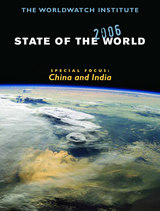 State of the World 2006: Special Focus: China and India
The Worldwatch Institute
Island Press, 2015 State of the World 2006 provides a special focus on China and India and their impact on the world as major consumers of resources and polluters of local and global ecosystems. The report explains the critical need for both countries to "leapfrog" the technologies, policies, and even the cultures that now prevail in many western countries for the sake of global sustainability—and reports on some of the strategies that China and India are starting to implement. Besides the focus on China and India, State of the World 2006 looks at actions corporations can take to be more socially responsible; examines the potential socioeconomic, health, and environmental implications of nanoscale technologies; assesses the impacts of large-scale development of biofuels on agriculture and the environment; describes mercury sources, industrial uses, and health hazards worldwide; and provides an overview of the need to safeguard freshwater ecosystems, with examples of proven approaches in cities, villages, and farming regions around the world.
State of the World 2007: Our Urban Future
The Worldwatch Institute
Island Press, 2015 In 2008, half of the Earth’s population will live in urban areas, marking the first time in history that humans are an urban species. State of the World 2007: Our Urban Future examines changes in the ways cities are managed, built, and lived in that could tip the balance towards a healthier and more peaceful urban future.
State of the World 2008: Innovations for a Sustainable Economy
The Worldwatch Institute
Island Press, 2015 Environmental issues were once regarded as irrelevant to economic activity, but today they are dramatically rewriting the rules for business, investors, and consumers. Around the world, innovative responses to climate change and other environmental problems are affecting more than $100 billion in annual capital flows as pioneering entrepreneurs, organizations, and governments take steps to create the Earth’s first “sustainable” global economy.
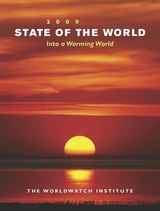 State of the World 2009: Into a Warming World
The Worldwatch Institute
Island Press, 2015 It's New Year's Day, 2101. Somehow, humanity survived the worst of global warming—the higher temperatures and sea levels and the more intense droughts and storms—and succeeded in stabilizing the Earth's climate. Greenhouse gas concentrations are peaking and are expected to drift downward in the 22nd century. The rise in global temperatures is slowing and the natural world is gradually healing. The social contract largely held. And humanity as a whole is better fed, healthier, and more prosperous today than it was a century ago. This scenario of an imagined future raises a key question: What must we do in the 21st century to make such a future possible, and to head off the kind of climate catastrophe that many scientists now see as likely? This question inspires the theme of the Worldwatch Institute's State of the World 2009 report: how climate change will play out over the coming century, and what steps we most urgently need to take now.
State of the World 2010: Transforming Cultures From Consumerism to Sustainability
The Worldwatch Institute
Island Press, 2015 Like a tsunami, consumerism has engulfed human cultures and Earth’s ecosystems. Left unaddressed, we risk global disaster. But if we channel this wave, intentionally transforming our cultures to center on sustainability, we will not only prevent catastrophe, but may usher in an era of sustainability—one that allows all people to thrive while protecting, even restoring, Earth. In State of the World 2010, sixty renowned researchers and practitioners describe how we can harness the world’s leading institutions—education, the media, business, governments, traditions, and social movements—to reorient cultures toward sustainability.
State of the World 2011: Innovations that Nourish the Planet
The Worldwatch Institute
Island Press, 2015 A compelling look at the global food crisis, with particular emphasis on global innovations that can help solve a worldwide problem. State of the World 2011 not only introduces us to the latest agro-ecological innovations and their global applicability but also gives broader insights into issues including poverty, international politics, and even gender equity.
State of the World 2012: Moving Toward Sustainable Prosperity
The Worldwatch Institute
Island Press, 2012 In the 2012 edition of its flagship report, Worldwatch celebrates the twentieth anniversary of the 1992 Earth Summit with a far-reaching analysis of progress toward building sustainable economies. Written in clear language with easy-to-read charts, State of the World 2012 offers a new perspective on what changes and policies will be necessary to make sustainability a permanent feature of the world's economies. The Worldwatch Institute has been named one of the top three environmental think tanks in the world by the University of Pennsylvania's Think Tanks and Civil Societies Program.
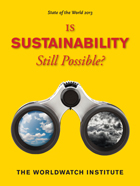 State of the World 2013: Is Sustainability Still Possible?
The Worldwatch Institute
Island Press, 2013 Every day, we are presented with a range of “sustainable” products and activities—from “green” cleaning supplies to carbon offsets—but with so much labeled as “sustainable,” the term has become essentially sustainababble, at best indicating a practice or product slightly less damaging than the conventional alternative. Is it time to abandon the concept altogether, or can we find an accurate way to measure sustainability? If so, how can we achieve it? And if not, how can we best prepare for the coming ecological decline?
In the latest edition of Worldwatch Institute’s State of the World series, scientists, policy experts, and thought leaders tackle these questions, attempting to restore meaning to sustainability as more than just a marketing tool. In State of the World 2013: Is Sustainability Still Possible?, experts define clear sustainability metrics and examine various policies and perspectives, including geoengineering, corporate transformation, and changes in agricultural policy, that could put us on the path to prosperity without diminishing the well-being of future generations. If these approaches fall short, the final chapters explore ways to prepare for drastic environmental change and resource depletion, such as strengthening democracy and societal resilience, protecting cultural heritage, and dealing with increased conflict and migration flows.
State of the World 2013 cuts through the rhetoric surrounding sustainability, offering a broad and realistic look at how close we are to fulfilling it today and which practices and policies will steer us in the right direction. This book will be especially useful for policymakers, environmental nonprofits, and students of environmental studies, sustainability, or economics.
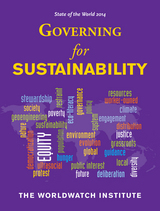 State of the World 2014: Governing for Sustainability
The Worldwatch Institute
Island Press, 2014 Citizens expect their governments to lead on sustainability. But from largely disappointing international conferences like Rio II to the U.S.’s failure to pass meaningful climate legislation, governments’ progress has been lackluster. That’s not to say leadership is absent; it just often comes from the bottom up rather than the top down. Action—on climate, species loss, inequity, and other sustainability crises—is being driven by local, people’s, women’s, and grassroots movements around the world, often in opposition to the agendas pursued by governments and big corporations.
These diverse efforts are the subject of the latest volume in the Worldwatch Institute’s highly regarded State of the World series. The 2014 edition, marking the Institute’s 40th anniversary, examines both barriers to responsible political and economic governance as well as gridlock-shattering new ideas. The authors analyze a variety of trends and proposals, including regional and local climate initiatives, the rise of benefit corporations and worker-owned firms, the need for energy democracy, the Internet’s impact on sustainability, and the importance of eco-literacy. A consistent thread throughout the book is that informed and engaged citizens are key to better governance.
The book is a clear-eyed yet ultimately optimistic assessment of citizens’ ability to govern for sustainability. By highlighting both obstacles and opportunities, State of the World 2014 shows how to effect change within and beyond the halls of government. This volume will be especially useful for policymakers, environmental nonprofits, students of environmental studies, sustainability, or economics—and citizens looking to jumpstart significant change around the world.
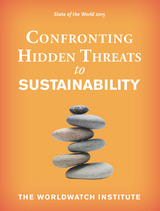 State of the World 2015: Confronting Hidden Threats to Sustainability
The Worldwatch Institute
Island Press, 2015 We think we understand environmental damage: pollution, water scarcity, a warming world. But these problems are just the tip of the iceberg. Food insecurity, financial assets drained of value by environmental damage, and a rapid rise in diseases of animal origin are among the underreported consequences of an unsustainable global system.
In State of the World 2015, the flagship publication of The Worldwatch Institute, experts explore hidden threats to sustainability and how to address them. How will nations deal with migration as climate change refugees cross borders in order to escape flooding, drought, or other extreme weather events? What will happen to the price and availability of fossil energy—the foundation of industrial civilization--as these resources oscillate between surplus and scarcity? If perpetual economic growth on a finite planet is impossible, what are the alternatives? Can national governments manage the transition? Eight key issues are addressed in depth, along with the central question of how we can develop resilience to these and other shocks.
For decades, The Worldwatch Institute has been a leader in identifying and analyzing emerging environmental threats. With the latest edition of State of The World, the authorities at Worldwatch bring to light challenges we can no longer afford to ignore.
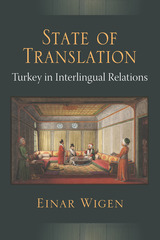 State of Translation: Turkey in Interlingual Relations
Einar Wigen
University of Michigan Press, 2018 International politics often requires two or more languages. The resulting interlingual relations mean translation, either by interpreters who are quite literally in the middle of conversations, or by bilingual statesmen who negotiate internationally in one language and then legitimize domestically in another. Since no two languages are the same, what can be argued in one language may be impossible in another. Political concepts can thus be significantly reformulated in the translation process. State of Translation examines this phenomenon using the case of how 19th-century Ottoman and later Turkish statesmen struggled to reconcile their arguments in external languages (French, then English) with those in their internal language (Ottoman, later Turkish), and in the process further entangled them. Einar Wigen shows how this process structured social relations between the Ottoman state and its interlocutors, both domestically and internationally, and shaped the dynamics of Turkish relations with Europe.
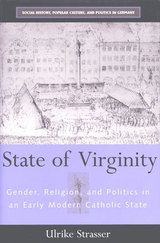 State of Virginity: Gender, Religion, and Politics in an Early Modern Catholic State
Ulrike Strasser
University of Michigan Press, 2006 Winner: 2005 Book Award from the Society for the Study of Early Modern Women; Selected by the German Studies Association as one of the top five books of 2004 in early modern history "A fresh, original study of gender roles and religious ideology in the early modern Catholic state. . . . Using a rich array of archival sources, Strasser explores ways in which an increasingly centralized Bavarian government in Munich inaugurated marriage and convent reforms and a civil religion based on the veneration of the Virgin Mary. Her carefully selected case studies show how church and state collaborated to produce a shared discourse and consistent policies proscribing extramarital sex, and excluding those without property from marriage. " —Choice Ulrike Strasser is Associate Professor of History, Affiliate Faculty in Women's Studies, and Core Faculty in Religious Studies at the University of California, Irvine.
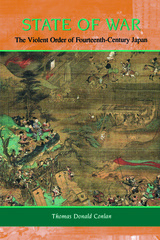 State of War: The Violent Order of Fourteenth-Century Japan
Thomas Donald Conlan
University of Michigan Press, 2003 State of War represents a fundamental revision of Japanese history. By illuminating Japan through the lens of war, Thomas Conlan provides insight into how state and society functioned, as opposed to how they were portrayed in ideal. Conlan recreates the experience of war from the perspective of one warrior and then reconstructs how war was fought through statistical analysis of surviving casualty records. State of War also shows that tThe battles of the 14th century mark a watershed in Japanese history. The fiscal exigencies of waging war led to a devolution of political power to the provinces. Furthermore, the outbreak of war caused social status to become performative, based upon the ability to fight autonomously, rather than being prescriptive, or determined by edicts of investiture. TBridging the intellectual gulf between the 14th and 20th centuries, Conlan also explores how the seemingly contradictory categories of “religion” and “war” were integrally related. The 14th-century belief that the outcome of battle was determined by the gods meant that religious institutions warred both ritually and physically, and that religious attitudes frequently underpinned warrior behavior. Based on diverse sources, including documents, picture scrolls, medical and religious texts, and chronicles, State of War rehabilitates warfare as a focal point of historical inquiry and provides a fascinating new overview of premodern Japanese history.
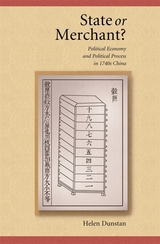 State or Merchant: Political Economy and Political Process in 1740s China
Helen Dunstan
Harvard University Press, 2006 What did it mean to run a large, commercialized agrarian polity according to the best Confucian principles?
This book is intended as a contribution to both intellectual and political history. It is partly a study of how Confucian-trained officials thought about the grain trade and the state's role in it, particularly the "ever-normal granaries," the stockpiles of grain maintained by every county government as protection against shortages and high prices. The author investigates the scope and limits of belief in market forces among those critical of government intervention, establishing that rudimentary economic arguments for state withdrawal from the grain trade were available by 1750. She then explores challenges, from within the ruling apparatus, to the state's claim that its own stockpiling served the public interest, as well as the factors behind decisions in the mid- and late 1740s to suspend or decrease state purchases of grain.
As a study of Confucian government in action, this book describes a mode of public policy discussion far less dominated by the Confucian scriptures than one might expect. As a contribution to intellectual history, the work offers a detailed view of members of an ostensibly Confucian government pursuing divergent agendas around the question of "state or merchant?"
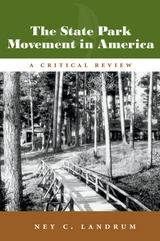 The State Park Movement in America: A Critical Review
Ney C. Landrum
University of Missouri Press, 2013 Essentially a phenomenon of the twentieth century, America’s pioneering state park movement has grown rapidly and innovatively to become one of the most important forces in the preservation of open spaces and the provision of public outdoor recreation in the country. During this time, the movement has been influenced and shaped by many factors—social, cultural, and economic—resulting in a wide variety of expressions. While everyone agrees that the state park movement has been a positive and beneficial force on the whole, there seems to be an increasing divergence of thought as to exactly what direction the movement should take in the future. In The State Park Movement in America, Ney Landrum, recipient of almost two dozen honors and awards for his service to state and national parks, places the movement for state parks in the context of the movements for urban and local parks on one side and for national parks on the other. He traces the evolution of the state park movement from its imprecise and largely unconnected origins to its present status as an essential and firmly established state government responsibility, nationwide in scope. Because the movement has taken a number of separate, but roughly parallel, paths and produced differing schools of thought concerning its purpose and direction, Landrum also analyzes the circumstances and events that have contributed to these disparate results and offers critical commentary based on his long tenure in the system. As the first study of its kind, The State Park Movement in America will fill a tremendous void in the literature on parks. Given that there are more than five thousand state parks in the United States, compared with fewer than five hundred national parks and historic sites, this history is long overdue. It will be of great interest to anyone concerned with federal, state, or local parks, as well as to land resource managers generally.
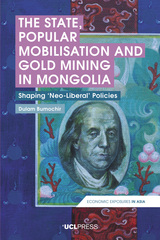 The State, Popular Mobilisation and Gold Mining in Mongolia: Shaping ‘Neo-Liberal’ Policies
Dulam Bumochir
University College London, 2020 Mongolia’s mining sector, along with its environmental and social costs, have been the subject of prolonged and heated debate. This debate has often cast the country as either a victim of the ‘resource curse’ or guilty of ‘resource nationalism’. In The State, Popular Mobilisation and Gold Mining in Mongolia, Dulam Bumochir aims to avoid the pitfalls of this debate by adopting an alternative theoretical approach. He focuses on the indigenous representations of nature, environment, economy, state, and sovereignty that have triggered nationalist and statist responses to the mining boom. In doing so, he explores the ways in which these responses have shaped the apparently ‘neo-liberal’ policies of twenty-first-century Mongolia, and the economy that has emerged from them, in the face of competing mining companies, protest movements, international donor organizations, economic downturn, and local and central government policies. Applying rich ethnography to a nuanced and complex picture, Bumochir’s analysis is essential reading for students and researchers studying the environment and mining, especially in Central and North-East Asia and post-Soviet regions, and also for readers interested in the relationship between neoliberalism, nationalism, environmentalism and state.
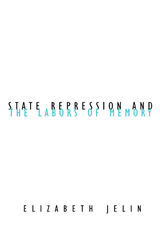 State Repression and the Labors of Memory
Elizabeth Jelin
University of Minnesota Press, 2003 A timely exploration of the nature of memory and its political uses Hearing the news from South America at the turn of the millennium can be like traveling in time: here are the trials of Pinochet, the searches for “the disappeared” in Argentina, the investigation of the death of former president Goulart in Brazil, the Peace Commission in Uruguay, the Archive of Terror in Paraguay, a Truth Commission in Peru. As societies struggle to come to terms with the past and with the vexing questions posed by ineradicable memories, this wise book offers guidance. Combining a concrete sense of present urgency and a theoretical understanding of social, political, and historical realities, State Repression and the Labors of Memory fashions tools for thinking about and analyzing the presences, silences, and meanings of the past. With unflappable good judgment and fairness, Elizabeth Jelin clarifies the often muddled debates about the nature of memory, the politics of struggles over memories of historical injustice, the relation of historiography to memory, the issue of truth in testimony and traumatic remembrance, the role of women in Latin American attempts to cope with the legacies of military dictatorships, and problems of second-generation memory and its transmission and appropriation. Jelin’s work engages European and North American theory in its exploration of the various ways in which conflicts over memory shape individual and collective identities, as well as social and political cleavages. In doing so, her book exposes the enduring consequences of repression for social processes in Latin America, and at the same time enriches our general understanding of the fundamentally conflicted and contingent nature of memory.
The State Roots of National Politics: Congress and the Tax Agenda, 1978–1986
Michael B. Berkman
University of Pittsburgh Press, 1994
Winner of the William Anderson Award of the American Political Science Association
Explores the role of state politics in shaping the national agenda during the 1980s. By focusing on the federal tax policy from 1978-1986, Berkman argues that a conservative political agenda slowly replaced the liberal agenda dominant since World War II.
The state roots model asserts that national policymakers, particularly members of Congress, are products of their state political systems and environments. Berkman applies this model to the tax-cutting policies that took hold nationally in 1978, before Regan came to office, and continued in the tax acts of 1981 and 1986.
 State, Space, World: Selected Essays
Henri Lefebvre
University of Minnesota Press, 2009 Leading intellectual Henri Lefebvre on political and state theory One of the most influential Marxist theorists of the twentieth century, Henri Lefebvre pioneered the study of the modern state in an age of accelerating global economic integration and fragmentation. Shortly after the 1974 publication of his landmark book The Production of Space, Lefebvre embarked on one of the most ambitious projects of his career: a consideration of the history and geographies of the modern state through a monumental study that linked several disciplines, including political science, sociology, geography, and history. State, Space, World collects a series of Lefebvre’s key writings on the state from this period. Making available in English for the first time the as-yet-unexplored political aspect of Lefebvre’s work, it contains essays on philosophy, political theory, state formation, spatial planning, and globalization, as well as provocative reflections on the possibilities and limits of grassroots democracy under advanced capitalism. State, Space, World is an essential complement to The Production of Space, The Urban Revolution, and The Critique of Everyday Life. Lefebvre’s original and prescient analyses that emerge in this volume are urgently relevant to contemporary debates on globalization and neoliberal capitalism.
State Taxation Policy and Economic Growth
Michael Barker, ed.
Duke University Press, 1983 This volume discusses the problems of state governments in coping with contemporary issues of redesigning taxation policies to encourage economic growth.
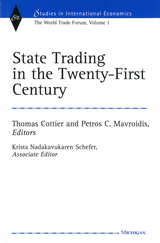 State Trading in the Twenty-First Century: The World Trade Forum, Volume 1
Thomas Cottier and Petros C. Mavroidis, Editors
University of Michigan Press, 1998 The University of Michigan Press is pleased to announce the first volume in an annual series, The World Trade Forum. The Forum's members include scholars, lawyers, and government and business practitioners working in the area of international trade, law, and policy. They meet annually and discuss integration issues in international economic relations, focusing on a new theme each year.
The central topic of the first World Trade Forum is state trading. To what extent has trade liberalization, as we have experienced it over the last fifty years, affected property ownership? Contributors to the 1998 World Trade Forum explore this question, examining both state practice and the regulatory framework. Their discussions are divided into three parts: Part 1 looks at the World Trade Organization's legal framework for state trading enterprises, taking on such issues as monopolies and state enterprises, the WTO Antidumping Agreement and the economies in transition, and relationship of state trading and the Government Purchasing Act. Part 2 deals with regional experiences in state trading (for the EC, United States, Canada, Japan, China, and Russia). Part 3 examines conceptual issues such as auctions as a trade policy instrument and rule-making alternatives for entities with exclusive rights. The conclusion synthesizes the foregoing chapters in discussing the reach of modern international trade law.
Contributors are Frederick Abbott, Ichiro Araki, Christian Bach, Jacques H. J. Bourgeois, Thomas Cottier, William J. Davey, Vladimir Dbrentsov, Toni Haniotis, Bernard M. Hoekman, Gary Horlick, Henrik Horn, Robert Howse, Patrick Low, Will Martin, Mitsuo Matsushita, Petros Mavroidis, Aaditya Mattoo, Patrick Messerlin, Constantine Michalopoulos, Kristin Heim Mowry, Stilpon Nestor, Damien Neven, N. David Palmeter, Ernst-Ulrich Petersmann, André Sapir, Diane P. Wood, and Werner Zdouc.
Petros Mavroidis is Professor of Law, University of Neuchatel. Thomas Cottier is Professor of Law, Institute of European and International Economic Law, University of Bern Law School.
The State, Ulama and Islam in Malaysia and Indonesia
Norshahril Saat
Amsterdam University Press, 2018 The Suharto (1966-98) government of Indonesia and the Mahathir (1981-2003) government of Malaysia both launched Islamisation programmes, upgrading and creating religious institutions. The author argues that, while generally ulamas, or religious teachers, had to support state ideologies, they sometimes succeeded in ŸcapturingŒ the state by influencing policies in their favour. The author builds his argument on strong fieldwork data, especially interviews, and he engages in critical discussion of comparative politics paradigms and the concept of capture.
The State University: Addresses Delivered at a Conference Held in the Seventy-fifth Year of the University of Texas
Edited by Logan Wilson
University of Texas Press, 1959 This collection of essays by five of the nation’s most eminent educators contains forthright discussions of the major issues that the state university faced at its 75th anniversary in 1958—relationships with other colleges and universities, undergraduate instruction, graduate education and research, public service, and the challenge of the future.
The contributors are David D. Henry, President of the University of Illinois, 1955–1971; Charles E. Odegaard, President of the University of Washington, 1958–1973; Sanford S. Atwood, Provost of Cornell University, 1955–1963; O. Meredith Wilson, President of the University of Oregon, 1954–1960; and Logan Wilson, President of the University of Texas, 1953–1960.
The State University, Its Work and Problems: A Selection from Addresses Delivered Between 1921 and 1933
Lotus Coffman
University of Minnesota Press, 1934
The State University: Its Work and Problems was first published in 1934. Minnesota Archive Editions uses digital technology to make long-unavailable books once again accessible, and are published unaltered from the original University of Minnesota Press editions.This presentation of the views of the late University of Minnesota president, Lotus Delta Coffman, emphasizes his contention that state-supported institutions of higher learning should be open to all who have the ability to profit by the work offered in them. The volume contains a series of
 State Violence, Collusion and the Troubles: Counter Insurgency, Government Deviance and Northern Ireland
Maurice Punch
Pluto Press, 2012 The period in Northern Ireland known as 'the Troubles' (1968-98) seemed to have been conclusively ended by the official peace process. But recent violence from dissident Republicans shows that tensions from the past remain unresolved.
State Violence, Collusion and the Troubles reveals disturbing unanswered questions about the use of state violence during this period. Maurice Punch documents in chilling detail how the British government turned to desperate, illegal measures in a time of crisis, disregarding domestic and international law. He broadens out his analysis to consider other cases of state violence against ‘insurgent groups’ in Spain and South Africa.
This is the story of how the British state collaborated with violent groups and directly participated in illegal violence. It also raises urgent questions about why states around the world continue to deploy such violence rather than seeking durable political settlements.
|
|


